Exhibit 99.1
Results for Announcement to the Market
James Hardie Industries N.V.
ARBN 097 829 895
Appendix 4D – Half Year Ended 30 September 2004
| |
|
|
|
|
|
|
|
|
|
|
|
|
|
|
Key Information
|
|
Half Year 30 September
|
| |
|
2004 |
|
2003 |
|
|
| |
|
US$M
|
|
US$M
|
|
Movement
|
Net Sales From Ordinary Activities |
|
|
607.0 |
|
|
|
493.1 |
|
|
up |
|
|
23 |
% |
Operating Profit From Continuing Operations After Tax
Attributable to Shareholders |
|
|
61.8 |
|
|
|
65.7 |
|
|
down |
|
|
6 |
% |
Operating Profit including Discontinued Operations
Attributable to Shareholders |
|
|
61.1 |
|
|
|
67.5 |
|
|
down |
|
|
9 |
% |
Net Tangible Assets per Ordinary Share |
|
US$ |
1.20 |
|
|
US$ |
1.10 |
|
|
up |
|
|
9 |
% |
Dividend Information
The Board has decided to defer consideration of declaring an
interim dividend until it is in a position to better assess the
financial impact of the likely outcome of negotiations with the
ACTU, Labor Council and representatives of asbestos diseases
groups in relation to the future funding of legitimate asbestos
diseases claims against former subsidiary companies. Dividends
were paid 16 December 2003 of US2.5 cents per share/CUFS and 1
July 2004 of US3 cents per share/CUFS.
Movements in Controlled Entities
The following entities were merged into James Hardie Building
Products, Inc. during the half year ended 30 September 2004:
Wallace O’Connor, LLC (30 April 2004); James Hardie Trading Co.
Inc .(19 April 2004); Wallace O’Connor Inc. (2 April 2004).
James Hardie Building Products, Inc. is a wholly owned subsidiary
of James Hardie Industries N.V. and is incorporated in the USA.
The following entities were liquidated during the half year ended
30 September 2004: RCI Malta Holdings Ltd. (14 August 2004); RCI
Malta Investments Ltd. (14 August 2004).
Review
The Consolidated Financial Statements included within this
Preliminary Final Report have been prepared using USGAAP and have
been subject to an independent review by external auditors.
Results for the 2nd Quarter and Half Year ended 30 September 2004
Contents
| |
1. |
|
Media Release |
| |
| |
2. |
|
Results At A Glance |
| |
| |
3. |
|
Management’s Analysis of Results |
| |
| |
4. |
|
Consolidated Financial Statements |
| |
| |
5. |
|
Management Presentation |
The information contained in the above documents comprise the
information required by ASX Listing Rule 4.2A and should be
read in conjunction with the James Hardie 2004 Annual Report.
It should also be read in the context of the public
announcements made by James Hardie Industries N.V. in
accordance with the continuous disclosure obligations arising
under the Corporations Act 2001 and the ASX Listing Rules since
the release of that Annual Report. The James Hardie 2004
Annual Report and links to the company’s public announcements
can be found on the company website at www.jameshardie.com.
James Hardie Industries N.V. is incorporated in The Netherlands
with corporate seat in Amsterdam. The liability of members is
limited.

| |
|
|
22 November 2004
|
|
Analyst and Media enquiries about |
|
|
results, please contact Steve Ashe on |
|
|
Tel: 61 2 8274 5246 |
|
|
Mob: 0408 164 011 |
2nd Qtr Operating Profit US$24.7m
Half Year Operating Profit US$61.8m
James Hardie today announced a 25% decline in second quarter operating profit
from continuing operations for the three months ended 30 September 2004, to
US$24.7 million.
Despite a 20% lift in net sales, earnings were lower due to costs associated
with the NSW Government Special Commission of Inquiry into the Medical Research
and Compensation Foundation (SCI) and other associated developments, and
increased costs in the USA Fibre Cement business.
Excluding US$5.6 million of SCI and related costs, operating profit for
continuing operations was 8% lower for the quarter, at US$30.3 million.
Overall, net sales increased 20%, gross profit was up 5% and EBIT fell 16% to
US$40.0 million for the quarter.
The USA Fibre Cement business continued to grow strongly, delivering a 21%
increase in net sales for the quarter, but EBIT fell 9% due to higher spending
on ramping-up growth initiatives and higher manufacturing costs, including
increased costs caused by efficiency problems at a number of our US plants. The
efficiency issues have been addressed and are now largely behind us and prices
of our most cost-significant raw material are declining. In Asia Pacific Fibre
Cement, net sales increased 14% and EBIT increased 31%.
The second quarter result lifted half year operating profit from continuing
operations to 30 September 2004 to US$61.8 million, but this was down 6%
compared to the first half of last year due to SCI related costs. Excluding
SCI and other related costs, operating profit from continuing operations was up
7% to US$70.3 million. EBIT from USA Fibre Cement and Asia Pacific Fibre
Cement segments were up 4% and 35%, respectively for the half year.
Diluted earnings per share from continuing operations decreased from US 7.1
cents to US 5.4 cents for the 2nd quarter and from US 14.3 cents to US 13.4
cents for the half year.
The half year net operating profit, including discontinued operations, of
US$61.1 million includes additional costs associated with the sale of New
Zealand land in March 2004. The net operating profit including discontinued
operations for the corresponding period of the previous year includes profit
recorded from the sale of our New Zealand Building Systems business.
2nd Quarter and Half Year at a Glance
| |
|
|
|
|
|
|
|
|
|
|
|
|
|
|
|
|
|
|
|
|
|
|
|
|
| US$ Million |
|
Q2FY05 |
|
Q2FY04 |
|
%+/(-) |
|
HYFY05 |
|
HYFY04 |
|
%+/(-) |
Net Sales |
|
$ |
300.9 |
|
|
$ |
251.6 |
|
|
|
20 |
|
|
$ |
607.0 |
|
|
$ |
493.1 |
|
|
|
23 |
|
Gross Profit |
|
|
97.1 |
|
|
|
92.4 |
|
|
|
5 |
|
|
|
208.4 |
|
|
|
181.7 |
|
|
|
15 |
|
Special Commission of Inquiry related
expenses |
|
|
5.6 |
|
|
|
— |
|
|
|
— |
|
|
|
8.5 |
|
|
|
— |
|
|
|
— |
|
EBIT1 |
|
|
40.0 |
|
|
|
47.9 |
|
|
|
(16 |
) |
|
|
98.3 |
|
|
|
96.2 |
|
|
|
2 |
|
Net Interest Expense |
|
|
(1.3 |
) |
|
|
(2.4 |
) |
|
|
(46 |
) |
|
|
(3.8 |
) |
|
|
(4.7 |
) |
|
|
(19 |
) |
Income Tax Expense |
|
|
(12.1 |
) |
|
|
(9.4 |
) |
|
|
29 |
|
|
|
(30.8 |
) |
|
|
(22.5 |
) |
|
|
37 |
|
Operating Profit from
continuing operations1 |
|
|
24.7 |
|
|
|
32.8 |
|
|
|
(25 |
) |
|
|
61.8 |
|
|
|
65.7 |
|
|
|
(6 |
) |
Net Operating Profit including discontinued
operations1 |
|
|
24.8 |
|
|
|
32.8 |
|
|
|
(24 |
) |
|
|
61.1 |
|
|
|
67.5 |
|
|
|
(9 |
) |
Unless otherwise stated, results are for
continuing operations only and
comparisons are of the 2nd quarter of the current fiscal year versus the 2nd
quarter of the prior fiscal year
Commentary
James Hardie Interim CEO, Louis Gries said: “Despite continued strong top line
growth in the second quarter, the bottom line was affected by a number of
non-recurring items and a dip in the operating performance of some of our US
plants.
“However, the company’s cash generation continued to be very strong and was up
a significant 50% for the half year.
“The outlook for housing construction in North America remains positive for the
remainder of the year despite the prospect of modest interest rate increases.
“Further strong sales growth is expected as we continue to take market share in
our emerging and established markets and in our exterior and interior product
categories in North America.
“Many of the internal and external factors that adversely impacted financial
performance in our North America businesses have already been overcome and
further improvement is expected.
“Given the external pressures on our Australia and New Zealand business during
the quarter, its overall performance was particularly pleasing,” Mr Gries said.
USA Fibre Cement – Continued Strong Top Line Growth
Net sales increased 21% to US$231.0 million in the 2nd quarter due to an 18%
increase in sales volume to 459.7 million square feet and a 3% increase in the
average selling price to US$503 per thousand square feet.
Strong growth continued across all regions and in both the exterior and
interior product markets.
The average selling price increased 3% due to a price increase on some products
implemented in the quarter and sales of higher-priced, differentiated products
representing an increased proportion of total sales.
| |
|
|
|
|
Media Release: James Hardie — 2nd Quarter and Half Year Results FY05
|
|
|
2 |
|
Despite the strong top line growth, EBIT was down 9% to US$49.0 million for the
quarter due to higher spending on ramping-up growth initiatives and increased
manufacturing costs including increased costs caused by efficiency problems at
a number of our US plants. Pulp, cement and energy prices were all higher for
the quarter and plant efficiency problems resulted in increased maintenance,
labour and freight costs being incurred. Freight was significantly higher due
to longer hauls associated with capacity constraints related to the
under-performing plants, and higher oil prices.
We expect overall costs to fall in the next quarter. Plant efficiency levels
have been addressed and are now largely behind us, and prices of our most
cost-significant raw material, pulp, are declining.
For the half year, EBIT increased 4% to US$112.1 million. The EBIT margin was
lower for the quarter and half year at 21.2% and 23.8%, respectively.
Australia and New Zealand (ANZ) Fibre Cement – Stronger Sales and Profitability
Despite softer market conditions and certain negative sentiment in Australia
associated with the SCI, net sales increased 16% to US$55.6 million for the
quarter due to favourable currency exchange movements, increased volumes and
higher average prices. Both new housing and renovation activity in Australia
were weaker compared to the same period a year ago, but the Queensland market
continued to perform strongly. In New Zealand, housing activity remained
strong during the quarter. ANZ EBIT increased 28% for the quarter and 30% for
the half year. The EBIT margin increased to 19.8% for the quarter and to 20.6%
for the half year.
Philippines – Small Positive EBIT
The Philippines recorded a small positive EBIT in both the quarter and the half
year due to increased sales and manufacturing cost savings.
Chile – Small Positive EBIT
The business recorded a small positive EBIT for the quarter and half year as it
continued to penetrate the domestic flat sheet market and build regional
exports.
USA Hardie® Pipe – Sales Growth and More Manufacturing Efficiencies
Net sales increased strongly for both the quarter and half year despite being
adversely affected by four hurricanes that hit Florida in the second quarter.
Increased prices and more manufacturing efficiency gains are helping to improve
operating performance. However, as expected, the business incurred EBIT losses
for the quarter and half year.
Europe Fibre Cement
Net sales for the quarter were up again as awareness of our backer and siding
products increased among distributors, builders and contractors following their
launch in the UK and French markets in the first quarter last year.
| |
|
|
|
|
Media Release: James Hardie — 2nd Quarter and Half Year Results FY05
|
|
|
3 |
|
Artisan® Roofing
Further work was undertaken during the quarter to refine manufacturing
operation and improve productivity. Commercial sales of our new generation of
fibre cement roofing products began in October 2004 and are expected to ramp up
to the end of the fiscal year.
Interim Dividend
The Board has decided to defer consideration of declaring an interim dividend
until it is in a position to better assess the potential financial impact of
the likely outcome of negotiations with the Australian Council of Trade Unions,
Labor Council of NSW and representatives of asbestos diseases groups in
relation to the future funding of legitimate asbestos diseases claims against
former subsidiary companies.
Special Commission of Inquiry and Subsequent Developments
The SCI reported its findings to the NSW Governor on 21 September 2004. It
indicated that the establishment of the MRCF and the establishment of ABN 60
Foundation were legally effective and that, accordingly, although any
liabilities in relation to asbestos victims’ claims remained with Amaca, Amaba
or ABN 60 (as the case may be), no significant liabilities for those claims
could likely be assessed directly against James Hardie Industries NV or any
other James Hardie entities.
On 14 July 2004, the company issued a statement announcing that it would
recommend that shareholders approve the provision of additional funding to
enable an effective statutory scheme to be established to compensate all future
claimants for asbestos-related injuries caused by former James Hardie
subsidiary companies.
When the SCI reported in September 2004, it found that there was a significant
funding shortfall in the MRCF. The SCI found that the net assets of the MRCF
and ABN 60 Foundation were not sufficient to meet the prospective liabilities
and were likely to be exhausted in the first half of 2007. In relation to the
company’s proposal, it indicated that although there were several issues which
needed to be refined quite significantly the proposal was an appropriate
starting point for negotiation with affected persons.
The NSW Government indicated that it was not prepared to negotiate with the
company and would only consider implementing a proposal brought to it by the
company after it had been endorsed by the Australian Council of Trade Unions
(ACTU), the Labor Council of New South Wales (LCNSW) and the various groups
representing asbestos claimants (Representatives).
The ACTU/LCNSW and the Representatives indicated they were not prepared to
recommend a statutory scheme along the lines of the one they assumed was being
proposed by James Hardie to the SCI and that it was unacceptable to them.
The company has taken a pragmatic approach and, acting on the early statements
of the NSW Premier, is engaged in discussions with the ACTU/LCNSW and the
Representatives.
On 10 September 2004, the company announced that the Audit Committee of the
Board had commissioned an internal investigation to be conducted by independent
legal advisers, consistent with US Securities regulations to investigate
allegations of illegal conduct raised during the SCI and any potential impacts
on the financial statements. The investigation has now been completed and
there was found to be no impact on the company’s current financial statements.
| |
|
|
|
|
Media Release: James Hardie — 2nd Quarter and Half Year Results FY05
|
|
|
4 |
|
On 22 September 2004, the Australian Securities and Investments Commission
(ASIC) announced that it had commenced investigations into the circumstances
surrounding the creation of the MRCF. The investigation is to include the
conduct of certain directors and officers of the James Hardie group of
companies and associated parties, and market disclosures made by the companies
and individuals. The company is co-operating with ASIC in relation to all
aspects of its investigation.
On 16 November 2004 the Company announced that it had offered an indemnity to
the directors of ABN 60 in order to facilitate the release of funding by ABN 60
to the MRCF. This proposed indemnity would require the Company to pay for any
legal costs incurred by the ABN 60 directors in connection with the release of
funding by ABN 60 to the MRCF. Additionally, the Company has offered to
provide funding to the MRCF on an interim basis for a period of up to six
months, commencing on 16 November 2004. The interim funding by the Company
would only be provided once existing MRCF funds have been exhausted.
On 18 November 2004, the NSW Government announced its intention to conduct a
review of current asbestos compensation arrangements in NSW. The intention of
this review is primarily to examine ways to reduce legal and administrative
costs, and to consider the current processes for handling and resolving dust
diseases compensation claims. The review is expected to report to the NSW
Government early in 2005.
Readers are also referred to the contingent liability discussion in note 8 of
the company’s financial statements for the half year ended 30 September 2004
concerning claims against former subsidiaries.
The company will lodge its annual report on Form 20-F for the year ended 31
March 2004 with the US Securities and Exchange Commission on 22 November 2004.
Outlook
In North America, there is little on the short-term horizon to suggest the
housing construction sector will not remain strong. Interest rates continue to
be low and expected increases over the balance of the fiscal year should have
only a modest impact on demand for new housing.
Builders are reporting an optimistic outlook for the remainder of the year and
continue to have relatively low inventories of new homes for sale and large
backlogs of orders for homes to be built.
Despite entering the seasonally slower period, further strong top-line growth
is expected and improved manufacturing performance and overall lower costs
should lift profitability as the company’s North American business continues to
penetrate its exterior and interior product markets.
Reduced manufacturing costs should result from lower pulp prices and improved
efficiency levels. The improvement in plant operating efficiency has addressed
capacity constraints experienced in the 2nd quarter and reduced freight costs.
Further ramping-up costs are expected to be incurred in the 2nd half for a
number of growth initiatives.
In the ANZ business, new housing and the renovations segments in Australia are
expected to further soften with the expectation of higher interest rates over
the medium term. In New Zealand, the new housing segment is believed to have
peaked and activity may soften as interest rates increase. Demand and
profitability for the ANZ business may be also adversely affected by product
boycotts and negative sentiment in Australia associated with the Special
Commission of Inquiry and related matters.
In the Philippines, building and construction activity is expected to increase
as seasonal conditions become more favourable. Increased prices and margins
are expected to further improve operating performance.
| |
|
|
|
|
Media Release: James
Hardie — 2nd Quarter and Half Year Results FY05
|
|
|
5 |
|
In our emerging Chile Fibre Cement, Europe Fibre Cement and US Hardie® Pipe
businesses, sales and market share are expected to increase as awareness of
their products among builders, contractors and distributors continues to grow.
Overall, the strong top line growth momentum evident in the first half is
continuing into the third quarter. Operating performance for the full year is
expected to benefit from improved manufacturing performance and reduced costs
in the second half.
Costs associated with the SCI and other associated developments are continuing
to be incurred and may be material.
The current range of analyst estimates1 for operating
profit from continuing
operations for the year ending 31 March 2005 is US$151 million to US$160
million – excluding costs for the SCI and other associated developments. Due
to higher spending in our North America business on ramping-up growth
initiatives, increased manufacturing and other costs incurred in the 2nd
quarter, and plant start up expenses in the 2nd half, as well as the potential
impact of negative customer sentiment and product boycotts on the profitability
of our ANZ business in the second half, we now expect operating profit from
continuing operations (excluding costs for the SCI and other associated
developments) will fall within the range of US$135 to US$145 million for the
year ending 31 March 2005.
Ends.
Media/Analyst Enquiries:
Steve Ashe
Vice President Investor Relations
Telephone: 61 2 8274 5246
Mobile: 0408 164 011
Email: [email protected]
Facsimile: 61 2 8274 5218
The release and the accompanying management’s analysis of results and
management presentation, along with the audio webcast of the presentation, are
available from the Investor Relations section of the company website at
www.jameshardie.com
This media release forms part of a package of information about the company’s
results. It should be read in conjunction with the other parts of this package,
including Management’s Analysis of Results, a Management Presentation, a
Financial Report and a Results at a Glance document.
| 1 |
|
Range includes forecasts from ABN AMRO, Deutsche, JPMorgan, Merrill Lynch,
Goldman Sachs JBWere, UBS, Citigroup SB, CSFB, Morgan Stanley |
| |
|
|
|
|
Media Release:
James Hardie — 2nd Quarter and Half Year Results FY05
|
|
|
6 |
|
1Definitions
EBIT and EBIT Margin - EBIT is defined as operating income. EBIT margin is
defined as EBIT as a percentage of our net sales. We believe EBIT and EBIT
margin to be relevant and useful information as these are the primary measures
used by our management to measure the operating profit or loss of our business.
EBIT is one of several metrics used by our management to measure the earnings
generated by our operations, excluding interest and income tax expenses.
Additionally, EBIT is believed to be a primary measure and terminology used by
our Australian investors. EBIT and EBIT margin should be considered in
addition to, but not as a substitute for, other measures of financial
performance reported in accordance with accounting principles generally
accepted in the United States of America. EBIT and EBIT margin, as we have
defined them, may not be comparable to similarly titled measures reported by
other companies.
EBIT and EBIT margin, as used in this document, are equivalent to the US GAAP
measures of operating income and operating income margin.
Operating profit from continuing operations - is equivalent to the US GAAP
measure of income from continuing operations.
Net operating profit including discontinued operations - is equivalent to the
US GAAP measure of net income.
Disclaimer
This Media Release contains forward-looking statements. We may from time to
time make forward-looking statements in our periodic reports filed with the
Securities and Exchange Commission on Forms 20-F and 6-K, in our annual reports
to shareholders, in offering circulars and prospectuses, in media releases and
other written materials and in oral statements made by our officers, directors
or employees to analysts, institutional investors, representatives of the media
and others. Examples of such forward-looking statements include:
| |
• |
|
projections of our operating results or financial
condition; |
| |
| |
• |
|
statements of our plans, objectives or goals, including
those relating to competition, acquisitions, dispositions and our
products; |
| |
| |
• |
|
statements about our future economic performance or that
of the United States, Australia or other countries in which we
operate; and |
| |
| |
• |
|
statements about product or environmental liabilities. |
Words such as “believe,” “anticipate,” “plan,” “expect,” “intend,” “target,”
“estimate,” “project,” “predict,” “forecast,” “guideline,” “should,” “aim” and
similar expressions are intended to identify forward-looking statements but are
not the exclusive means of identifying such statements.
Forward-looking statements involve inherent risks and uncertainties. We caution
you that a number of important factors could cause actual results to differ
materially from the plans, objectives, expectations, estimates and intentions
expressed in such forward-looking statements. These factors include but are not
limited to: all matters relating to or arising out of the prior manufacture of
asbestos by ABN 60 and certain former subsidiaries; competition and product
pricing in the markets in which we operate; general economic and market
conditions; compliance with and possible changes in environmental and health
and safety laws; the successful transition of new senior management; the
success of our research and development efforts; the supply and cost of raw
materials; our reliance on a small number of product distributors; the
consequences of product failures or defects; exposure to environmental,
asbestos or other legal proceedings; risks of conducting business
internationally; compliance with and changes in tax laws and treatments; and
foreign exchange risks. We caution you that the foregoing list of factors is
not exclusive and that other risks and uncertainties may cause actual results
to differ materially from those in forward-looking statements. Forward-looking
statements speak only as of the date they are made.
| |
|
|
|
|
Media Release: James
Hardie — 2nd Quarter and Half Year Results FY05
|
|
|
7 |
|

2nd Quarter and Half Year – 30 September 2004
| |
|
|
|
|
|
|
|
|
|
|
|
|
|
|
|
|
|
|
|
|
|
|
|
|
|
|
|
|
| |
|
2nd QTR FY05 |
|
HY05 |
James Hardie |
|
|
|
|
|
|
|
|
|
|
|
|
|
|
|
|
|
|
|
|
|
|
|
|
|
|
|
|
Net Sales |
|
Up |
|
|
20 |
% |
|
to |
|
US$ |
300.9 |
|
|
Up |
|
|
23 |
% |
|
to |
|
US$ |
607.0 |
|
EBIT1 |
|
Down |
|
|
16 |
% |
|
to |
|
US$ |
40.0 |
|
|
Up |
|
|
2 |
% |
|
to |
|
US$ |
98.3 |
|
Operating Profit from
Continuing Operations1 |
|
Down |
|
|
25 |
% |
|
to |
|
US$ |
24.7 |
|
|
Down |
|
|
6 |
% |
|
to |
|
US$ |
61.8 |
|
Net Operating Profit
Including Discontinued
Operations1 |
|
Down |
|
|
24 |
% |
|
to |
|
US$ |
24.8 |
|
|
Down |
|
|
9 |
% |
|
to |
|
US$ |
61.1 |
|
EBIT Margin1 |
|
Down |
|
5.7pts |
|
to |
|
|
13.3 |
% |
|
Down |
|
3.3pts |
|
to |
|
|
16.2 |
% |
USA Fibre Cement |
|
|
|
|
|
|
|
|
|
|
|
|
|
|
|
|
|
|
|
|
|
|
|
|
|
|
|
|
Net Sales |
|
Up |
|
|
21 |
% |
|
to |
|
US$ |
231.0 |
|
|
Up |
|
|
25 |
% |
|
to |
|
US$ |
471.7 |
|
EBIT1 |
|
Down |
|
|
9 |
% |
|
to |
|
US$ |
49.0 |
|
|
Up |
|
|
4 |
% |
|
to |
|
US$ |
112.1 |
|
EBIT Margin1 |
|
Down |
|
6.9pts |
|
to |
|
|
21.2 |
% |
|
Down |
|
4.7pts |
|
to |
|
|
23.8 |
% |
Volume |
|
Up |
|
|
18 |
% |
|
to |
|
459.7mmsf1 |
|
Up |
|
|
22 |
% |
|
to |
|
950.1mmsf1 |
Asia Pacific Fibre Cement |
|
|
|
|
|
|
|
|
|
|
|
|
|
|
|
|
|
|
|
|
|
|
|
|
|
|
|
|
Net Sales |
|
Up |
|
|
14 |
% |
|
to |
|
US$ |
62.5 |
|
|
Up |
|
|
14 |
% |
|
to |
|
US$ |
119.8 |
|
EBIT1 |
|
Up |
|
|
31 |
% |
|
to |
|
US$ |
12.3 |
|
|
Up |
|
|
35 |
% |
|
to |
|
US$ |
24.3 |
|
EBIT Margin1 |
|
Up |
|
2.5pts |
|
to |
|
|
19.7 |
% |
|
Up |
|
3.1pts |
|
to |
|
|
20.3 |
% |
Volume |
|
Up |
|
|
9 |
% |
|
to |
|
102.6mmsf1 |
|
Up |
|
|
9 |
% |
|
to |
|
196.8mmsf1 |
Key Ratios
| |
|
|
Earnings Per Share (Diluted) |
|
13.4cents |
EBIT Margin1 |
|
16.2% |
Return on Shareholders Funds (Annualised – including discontinued operations) |
|
23.2% |
Return on Capital Employed (Annualised) |
|
26.0% |
Gearing1 |
|
10.0% |
Net Interest Cover (EBIT1 / Net interest expense) |
|
25.5x |
All comparisons are against the 2nd quarter or half year of the previous
fiscal year. All dollar amounts are in US$ millions. Results are for
continuing businesses only unless otherwise stated. Note: This document
should be read in conjunction with other 2nd quarter and
half year results materials including a Media Release, a Management’s
Discussion and Analysis, a Management Presentation and a Financial Report.
1Definitions
EBIT and EBIT Margin - EBIT is defined as operating income. EBIT margin is
defined as EBIT as a percentage of our net sales. We believe EBIT and EBIT
margin to be relevant and useful information as these are the primary measures
used by our management to measure the operating profit or loss of our business.
EBIT is one of several metrics used by our management to measure the earnings
generated by our operations, excluding interest and income tax expenses.
Additionally, EBIT is believed to be a primary measure and terminology used by
our Australian investors. EBIT and EBIT margin should be considered in
addition to, but not as a substitute for, other measures of financial
performance reported in accordance with accounting principles generally
accepted in the United States of America. EBIT and EBIT margin, as we have
defined them, may not be comparable to similarly titled measures reported by
other companies.
EBIT and EBIT margin, as used in this document, are equivalent to the US GAAP
measures of operating income and operating income margin.
Operating profit from continuing operations - is equivalent to the US GAAP
measure of income from continuing operations.
Net operating profit including discontinued operations - is equivalent to the
US GAAP measure of net income.
Gearing – Is borrowings less cash (net debt) divided by net debt plus
shareholders’ equity.
mmsf – million square feet
msf – thousand square feet

| |
|
|
|
|
22 November 2004
|
|
|
|
Analyst and Media enquiries about |
|
|
|
|
results, please contact Steve Ashe on |
|
|
|
|
Tel: 61 2 8274 5246 Mob: 0408 164 011 |
James Hardie Industries N.V.
Results for the 2nd Quarter Ended 30 September 2004
| |
|
|
|
|
|
|
|
|
|
|
|
|
| |
|
Three Months Ended 30 September
|
USGAAP - US$ Millions
|
|
FY 2005
|
|
FY 2004
|
|
% Change
|
Net Sales |
|
|
|
|
|
|
|
|
|
|
|
|
USA Fibre Cement |
|
$ |
231.0 |
|
|
$ |
191.4 |
|
|
|
21 |
|
Asia Pacific Fibre Cement |
|
|
62.5 |
|
|
|
54.8 |
|
|
|
14 |
|
Other Fibre Cement |
|
|
7.4 |
|
|
|
5.4 |
|
|
|
37 |
|
|
|
|
|
|
|
|
|
|
|
|
|
|
Total Net Sales |
|
|
300.9 |
|
|
|
251.6 |
|
|
|
20 |
|
|
|
|
|
|
|
|
|
|
|
|
|
|
Net Sales |
|
$ |
300.9 |
|
|
$ |
251.6 |
|
|
|
20 |
|
Cost of goods sold |
|
|
(203.8 |
) |
|
|
(159.2 |
) |
|
|
28 |
|
Gross profit |
|
|
97.1 |
|
|
|
92.4 |
|
|
|
5 |
|
Selling general & administrative expenses |
|
|
(45.5 |
) |
|
|
(38.9 |
) |
|
|
17 |
|
Research and development expenses |
|
|
(5.3 |
) |
|
|
(5.6 |
) |
|
|
(5 |
) |
Special Commission of Inquiry related expenses |
|
|
(5.6 |
) |
|
|
— |
|
|
|
— |
|
Other operating expenses |
|
|
(0.7 |
) |
|
|
— |
|
|
|
— |
|
EBIT1 |
|
|
40.0 |
|
|
|
47.9 |
|
|
|
(16 |
) |
Net interest expense |
|
|
(1.3 |
) |
|
|
(2.4 |
) |
|
|
(46 |
) |
Other expenses, net |
|
|
(1.9 |
) |
|
|
(3.3 |
) |
|
|
(42 |
) |
Operating profit from continuing operations before
income taxes1 |
|
|
36.8 |
|
|
|
42.2 |
|
|
|
(13 |
) |
Income tax expense |
|
|
(12.1 |
) |
|
|
(9.4 |
) |
|
|
29 |
|
Operating Profit From Continuing Operations1 |
|
$ |
24.7 |
|
|
$ |
32.8 |
|
|
|
(25 |
) |
|
|
|
|
|
|
|
|
|
|
|
|
|
Net Operating Profit Including Discontinued
Operations1 |
|
$ |
24.8 |
|
|
$ |
32.8 |
|
|
|
(24 |
) |
|
|
|
|
|
|
|
|
|
|
|
|
|
Tax rate |
|
|
32.9 |
% |
|
|
22.3 |
% |
|
|
|
|
Volume (mmsf1) |
|
|
|
|
|
|
|
|
|
|
|
|
USA Fibre Cement |
|
|
459.7 |
|
|
|
390.5 |
|
|
|
18 |
|
Asia Pacific Fibre Cement* |
|
|
102.6 |
|
|
|
94.0 |
|
|
|
9 |
|
Average sales price per unit (per msf1) |
|
|
|
|
|
|
|
|
|
|
|
|
USA Fibre Cement |
|
US$ |
503 |
|
|
US$ |
490 |
|
|
|
3 |
|
Asia Pacific Fibre Cement* |
|
A$ |
850 |
|
|
A$ |
865 |
|
|
|
(2 |
) |
*See Endnotes
Unless otherwise stated, results are for continuing
operations only and comparisons are of the 2nd quarter of the
current fiscal year versus the 2nd quarter of the prior fiscal year.
Total Net Sales
Total net sales increased 20% compared to the same quarter of the previous
year, from US$251.6 million to US$300.9 million.
Net sales from USA Fibre Cement increased 21% from US$191.4 million to US$231.0
million due to continued strong growth in sales volumes and a higher average
net selling price.
Net sales from Asia Pacific Fibre Cement increased 14% from US$54.8 million to
US$62.5 million due to a 9% increase in sales volumes and favourable foreign
currency movements, partly offset by a 2% decrease in average net selling
price.
Net sales from Other Fibre Cement increased 37% from US$5.4 million to US$7.4
million as the Chilean flat sheet business, the USA-based Hardie® Pipe business
and European Fibre Cement business continued to grow.
USA Fibre Cement
Net sales increased 21% from US$191.4 million to US$231.0 million due to
increased sales volumes and a higher average net selling price.
Sales volume increased 18% from 390.5 million square feet to 459.7 million
square feet, primarily due to continued strong growth in primary demand for
fibre cement and a favourable housing construction market. Sales volume for
the quarter was partly affected by supply issues relating to a temporary
reduction in manufacturing efficiencies at some plants.
Despite economic recovery in the United States being slower than expectations,
strong consumer demand for new residential housing continued during the quarter
fuelled by low mortgage rates, low inventories of houses for sale and solid
house prices.
There was strong sales growth across all regions in both the emerging and
established geographic markets and in our exterior and interior product
markets.
In our exterior product market, there were further market share gains against
alternative materials, primarily wood-based and vinyl siding. There continued
to be growth in sales of higher-priced, differentiated products such as vented
soffits, Heritage® panels, the ColorPlus™ Collection of pre-painted siding and
Harditrim® XLD™.
In our interior product market, further market share gains were achieved, with
sales of Hardibacker 500® half-inch backerboard continuing to grow strongly
compared to the same period last year.
The average net selling price increased 3% from US$490 per thousand square feet
to US$503 per thousand square feet. The increase was due to proportionally
stronger growth of differentiated, higher priced products, including
Harditrim®, vented soffit and the ColorPlus™ Collection, and a price increase
for some products that became effective on 1 July 2004.
During the quarter, we continued construction of our new green-field fibre
cement plant in Reno, Nevada and our new 160 million square foot trim line in
Peru, Illinois. Both the new Reno plant and the Peru trim line are expected
to be completed by the end of this fiscal year.
Asia Pacific Fibre Cement (See Endnotes)
Net sales increased 14% from US$54.8 million to US$62.5 million. Net sales
increased 5% in Australian dollars. Sales volume increased 9% from 94.0
million square feet to 102.6 million square feet.
| |
|
|
|
|
James Hardie 2nd Quarter FY05 Management’s Analysis of Results
|
|
|
2 |
|
Australia and New Zealand Fibre Cement
Net sales increased 16% from US$47.8 million to US$55.6 million due to
increased sales volume and favourable foreign currency movements. In
Australian dollars, net sales increased 7%.
Sales volumes increased from 73.2 million square feet to 77.7 million square
feet despite softer market conditions and negative customer sentiment in
Australia associated with the NSW Government Special Commission of Inquiry into
the Medical Research and Compensation Foundation and negative publicity arising
following release of the report of the Inquiry.
In Australia, there was a slowing in both new residential housing and
renovations activity, although the Queensland market continues to perform
strongly.
In New Zealand, new residential housing activity remained strong and demand
continued to increase for weatherboards, eaves and soffits. Sales of our
Linea® range of weatherboards continued to grow strongly.
The average net selling price increased 1% in Australian dollars due to an
increased proportion of sales of higher-priced, differentiated products.
Philippines Fibre Cement
Increased penetration of the domestic and regional export markets helped
increase net sales 19% from US$5.8 million to US$6.9 million. In local
currency, net sales increased 22%. The increase in net sales resulted from a
20% increase in sales volume and a 2% increase in the average selling price.
The increase in the net selling price was due mainly to a change in sales mix
between domestic and export sales.
Construction activity in the Philippines remained stable during the quarter.
Other Fibre Cement
Chile Fibre Cement
Our Chilean business continued to increase its penetration of the domestic flat
sheet market by increasing sales of higher-priced, differentiated products and
by building regional export sales.
Net sales increased compared to the same quarter last year due to strong growth
in sales volume, partly offset by a lower average net selling price. The lower
average net selling price was due to a lower proportion of higher priced export
sales to North America and the impact of a weaker US dollar on export sales.
During the quarter, a small plant upgrade was completed, allowing the plant to
manufacture 12-foot planks. We expect these products to open new markets and
create growth opportunities. Initial customer response to this product has
been positive.
| |
|
|
|
|
James Hardie 2nd Quarter FY05 Management’s Analysis of Results
|
|
|
3 |
|
Hardie® Pipe
Our USA Hardie® Pipe business continued to penetrate the Florida market of the
United States, although sales growth was adversely affected by severe weather
that hit Florida during the quarter.
Net sales increased strongly compared to the same period last year due to an
increase in sales volume that was the result of increased market penetration
and a higher average net selling price.
The heavy building industry in Florida continues to be buoyant, with flat
non-residential construction offset by strong growth in residential
sub-division development.
The average net selling price increased further this quarter, reflecting strong
demand and the favourable impact of raw material prices and availability, but
prices in Florida are still well below the national averages for concrete pipe.
The manufacturing performance of the plant improved further during the quarter,
but operating costs are still above our targets.
Europe Fibre Cement
Our European business continued to penetrate the UK and French markets as
awareness of our products among distributors, builders and contractors
increased.
During the quarter, we achieved significantly higher growth in siding sales in
the UK, as sales and marketing initiatives were further progressed.
Sales have continued to build steadily since commencement of operations in the
first quarter of the previous fiscal year. Net sales this quarter increased
significantly compared to the same quarter of the previous year due to stronger
demand across the range of interior and exterior products.
Artisan® Roofing
In June 2003, we began to commission and trial our pilot roofing plant in
Fontana, California. The pilot plant, which has a design capacity of 25 million
square feet, was built to test our proprietary manufacturing technology and to
provide product for market testing in Southern California.
During the quarter, we continued to refine the manufacturing operations and
improve productivity and we expect volumes to ramp up throughout the remainder
of the fiscal year.
Initial pricing of our Artisan® Roofing product is positioned to be competitive
with wood shake roofing products in Southern California.
Preliminary interest in Artisan® Roofing within our targeted customer group
remains strong.
There were no commercial sales in the second quarter, but sales began in
October 2004 and are expected to ramp up through the end of the fiscal year.
Gross Profit
Gross profit increased 5% from US$92.4 million to US$97.1 million due mainly to
strong improvements in Australia and New Zealand and the Philippines businesses
and due to favourable currency exchange movements. The gross profit margin
decreased 4.4 percentage points to 32.3%.
| |
|
|
|
|
James Hardie 2nd Quarter FY05 Management’s Analysis of Results
|
|
|
4 |
|
USA Fibre Cement gross profit was flat compared to the same quarter last year
due to the increase in sales revenue being offset by an increase in unit cost
of sales and increased freight costs. The
higher unit cost of sales resulted primarily from increased sales of
higher-priced, differentiated products, higher pulp and cement costs, plant
maintenance expenses and a temporary reduction in manufacturing efficiency at
some plants. Higher freight costs were primarily related to an increase in
length of haul of some products due to supply issues associated with the
temporary reduction in plant manufacturing efficiency, and higher fuel costs.
The gross profit margin decreased 7.0 percentage points.
Asia Pacific Fibre Cement gross profit increased 26% following significant
improvements from Australia and New Zealand Fibre Cement and Philippines Fibre
Cement, which increased 24% and 54%, respectively. The improved result for
Australia and New Zealand was due to increased sales revenue and manufacturing
efficiency improvements. In the Philippines, increased sales revenue, cost
savings and improved manufacturing efficiencies accounted for the stronger
gross profit performance. The Asia Pacific Fibre Cement gross profit margin
increased 3.2 percentage points.
Selling, General and Administrative (SG&A) Expenses
SG&A expenses increased 17% compared to the same quarter last year, from
US$38.9 million to US$45.5 million. The increase in SG&A expenses was due
mainly to increased sales and marketing, information technology and other
expenses associated with growth initiatives in the United States. As a
percentage of sales, SG&A expenses were 0.4 of a percentage point lower at
15.1%.
Research and Development Expenses
Research and development expenses include costs associated with “core” research
projects that are designed to benefit all fibre cement business units. These
costs are recorded in the Research and Development segment rather than being
attributed to individual business units. These costs decreased 17% for the
quarter to US$3.0 million.
Other research and development costs associated with commercialisation projects
in business units are included in the business related unit segment results.
In total, these costs increased 15% to US$2.3 million.
Special Commission of Inquiry Related Costs
Costs incurred during the quarter associated with the NSW Government Special
Commission of Inquiry into the Medical Research and Compensation Foundation and
related matters totalled US$5.6 million.
Other Operating Expense
Other operating expense of US$0.7 million relates to a loss on the sale of land
in Sacramento, California.
EBIT1
EBIT decreased 16% from US$47.9 million to US$40.0 million. The EBIT margin
decreased 5.7 percentage points to 13.3%. Excluding costs associated with the
NSW Special Commission of Inquiry into the Medical Research and Compensation
Foundation, EBIT decreased 5% compared to the same quarter last year and the
EBIT margin was 15.2%.
| |
|
|
|
|
James Hardie 2nd Quarter FY05 Management’s Analysis of Results
|
|
|
|
5 |
USA Fibre Cement EBIT decreased 9% from US$53.7 million to US$49.0 million.
The decrease was due to an increase in both unit cost of sales and unit freight
cost, and SG&A expenses, partly offset by strong growth in net sales. The
increase in unit cost of sales was due to increased sales of higher cost
differentiated products, higher pulp and cement costs, increased maintenance
expenses and a temporary reduction in manufacturing efficiency at some plants.
Higher freight costs were primarily related to an increase in length of haul of
some products due to supply issues associated with the temporary reduction in
plant manufacturing efficiency, and higher fuel costs. The EBIT margin
decreased 6.9 percentage points to 21.2%.
Asia Pacific Fibre Cement EBIT increased 31% from US$9.4 million to US$12.3
million. The EBIT margin increased 2.5 percentage points to 19.7%.
Australia and New Zealand Fibre Cement EBIT increased 28% from US$8.6 million
to US$11.0 million. In Australian dollars, EBIT increased 18%. The increase
in EBIT in Australian dollars was due to increased net sales compared to the
same period last year and manufacturing efficiencies. The EBIT margin
increased 1.8 percentage points to 19.8%.
Philippines Fibre Cement business recorded a positive EBIT, doubling the EBIT
performance of the same quarter last year due to increased net sales and lower
manufacturing costs.
The Chile Fibre Cement business recorded another small positive EBIT for the
quarter due to increased net sales.
Our USA Hardie® Pipe business incurred an EBIT loss for the quarter despite
higher selling prices and further improvements in operating performance.
Overall business performance for the quarter was adversely affected by the
impact of severe whether in Florida.
Our European fibre cement business incurred an EBIT loss for the quarter,
following its commencement in the prior fiscal year.
General corporate costs increased US$6.9 million from US$6.8 million to US$13.7
million. This increase was primarily due to US$ 5.6 million of expenses
related to the Special Commission of Inquiry into the Medical Research and
Compensation Foundation and other associated developments, a US$0.7 million
loss on the sale of land owned in Sacramento California, a US$0.5 million
increase in employee bonus plan expense and a net increase in professional
service fees and other general corporate costs, partially offset by a US$0.7
million decrease in employee share based compensation expense from stock
appreciation rights primarily caused by a decrease in the company’s share
price.
Net Interest Expense
Net interest expense decreased by US$1.1 million from US$2.4 million to US$1.3
million primarily due to a higher amount of interest expense capitalised on
construction projects in the current year than in the prior year and higher
interest income due to higher average cash balances.
Other Expenses, Net
Other operating expense consists of a US$1.9 million impairment charge that we
recorded on an investment in a company that filed a voluntary petition for
reorganisation under Chapter 11 of the US bankruptcy code. In the same quarter
of the prior year, we incurred an expense of US$3.2 million primarily due to a
capital duty fee paid in conjunction with our Dutch legal structure, incurred
to extend the scope of our international finance subsidiary to lend to our
global operations.
| |
|
|
|
|
James Hardie 2nd Quarter FY05 Management’s Analysis of Results
|
|
|
6 |
|
Income Tax Expense
Income tax expense increased by US$2.7 million from US$9.4 million to US$12.1
million. Although our profit before tax decreased, our current year effective
tax rate estimate is higher than the prior year effective tax rate.
Operating Profit from Continuing Operations1
Operating profit from continuing operations decreased by 25%, from US$32.8
million to US$24.7 million, due mainly to expenses associated with the NSW
Government Special Commission of Inquiry into the Medical Research and
Compensation Foundation. Excluding these expenses, operating profit from
continuing operations for the quarter would have been US$30.3 million.
Discontinued Operations
Net expense of US$0.7 million relates primarily to additional costs
associated with the sale of New Zealand land in March 2004.
Special Commission of Inquiry and Subsequent Developments
The Special Commission of Inquiry (the “SCI”) into the Medical Research and
Compensation Foundation (MRCF) reported its findings to the NSW Governor on 21
September 2004. It indicated that the establishment of the MRCF and the
establishment of ABN 60 Foundation were legally effective and that,
accordingly, although any liabilities in relation to asbestos victims’ claims
remained with Amaca, Amaba or ABN 60 (as the case may be), no significant
liabilities for those claims could likely be assessed directly against James
Hardie Industries NV or any other James Hardie entities.
In relation to the assertions by the MRCF concerning the circumstances of its
establishment, the SCI examined these in detail. Although the SCI made adverse
findings against Mr. Macdonald (former CEO) and Mr. Shafron (former CFO), it
did not find that their conduct caused any material loss to the MRCF or the
asbestos victims which would create a valuable cause of action against, and
therefore a material liability of, any James Hardie entity or would lead to any
of the restructuring arrangements being reversed. Indeed, the SCI specifically
noted that there were significant hurdles, which might be insuperable, to
establishing any liability in respect of these claims against the Company, ABN
60 or their respective directors and that, even if liability were established,
there were further hurdles which might prove to be insuperable against any
substantial recovery or remedy by such potential claimants in respect of them.
On 14 July 2004, the company lodged a submission with the SCI stating that the
company would recommend that shareholders approve the provision of additional
funding to enable an effective statutory scheme to compensate all future
claimants for asbestos-related injuries caused by former James Hardie
subsidiary companies. The company proposed that the statutory scheme include
the following elements:
| • |
|
speedy, fair and equitable compensation for all existing and
future claimants, including objective criteria to reduce superimposed
(judicial) inflation; |
| |
| • |
|
contributions to be made in a manner which provides certainty to
claimants as to their entitlements, the scheme administrator as to the
amount available for distribution, and the contributors as to the
ultimate amount of the contribution to the scheme; |
| |
| • |
|
significant reduction in legal costs via the removal of requirements for litigation; and |
| |
| • |
|
limitation of legal avenues outside of the scheme. |
| |
|
|
|
|
James Hardie 2nd Quarter FY05 Management’s Analysis of Results
|
|
|
7 |
|
The submission stated that the proposal was made without any admission of
liability or prejudice to the company’s rights or defences.
When the SCI reported in September 2004, it found that there was a significant
funding shortfall in the MRCF. The SCI found that the net assets of the MRCF
were not sufficient to meet the prospective liabilities and were likely to be
exhausted in the first half of 2007. In relation to the company’s proposal,
the SCI indicated that although there were several issues which needed to be
refined quite significantly, the proposal was an appropriate starting point for
negotiation with affected persons.
The NSW Government indicated that it was not prepared to negotiate with the
company and would only consider implementing a proposal brought to it by the
company after it had been endorsed by the Australian Council of Trade Unions
(ACTU), the Labour Council of New South Wales (LCNSW), and various groups
representing asbestos claimants (Representatives).
The ACTU/LCNSW and the Representatives indicated that they were not prepared to
recommend a statutory scheme along the lines of the one they assumed was being
proposed by the company to the SCI and that it was unacceptable to them.
The company has taken a pragmatic approach and, acting on the early statements
of the NSW Premier, is engaged in discussions with the ACTU/LCNSW and the
Representatives.
On 10 September 2004, the company announced that the Audit Committee of the
Board had commissioned an internal investigation to be conducted by independent
legal advisers, consistent with US Securities regulations to investigate
allegations of illegal conduct raised during the SCI and any potential impacts
on the financial statements. The investigation has now been completed and
there was found to be no impact on the company’s current financial statements.
On 22 September 2004, the Australian Securities and Investments Commission
(ASIC) announced that it had commenced investigations into the circumstances
surrounding the creation of the MRCF. The investigation is to include the
conduct of certain directors and officers of the James Hardie group of
companies and associated parties, and market disclosures made by the companies
and individuals. The company is co-operating with ASIC in relation to all
aspects of its investigation.
The company has incurred substantial costs associated with the SCI and may
incur material costs in the future related to the SCI, the ASIC investigation
or subsequent and other legal proceedings and in relation to discussions with
the ACTU/LCNSW and the Representatives. These costs may include those of
current and former officers of the James Hardie Group to the extent that those
costs are covered by indemnity arrangements granted by the James Hardie Group
to those persons. To date, no claims have been received by any current or
former officers in relation to the ASIC investigation and if they do, the
company may be reimbursed under directors and officers insurance policies taken
out by the company.
Readers are also referred to the contingent liability discussion in note 8 of
the company’s financial statements for the half year ended 30 September 2004
concerning claims against former subsidiaries.
On 16 November 2004 the Company announced that it had offered an indemnity to
the directors of ABN 60 in order to facilitate the release of funding by ABN 60
to the MRCF. This proposed indemnity would require the Company to pay for any
legal costs incurred by the ABN 60 directors in connection with the release of
funding by ABN 60 to the MRCF. Additionally, the Company has offered to
provide funding to the MRCF on an interim basis for a period of up to six
months, commencing 16 November 2004. The proposed interim funding by the
Company would only be provided once existing MRCF funds have been exhausted.
| |
|
|
|
|
James Hardie 2nd Quarter FY05 Management’s Analysis of Results
|
|
|
8 |
|
On 18 November 2004, the NSW Government announced its intention to conduct a
review of current asbestos compensation arrangements in NSW. The intention of
this review is primarily to determine ways to reduce legal and administrative
costs, and to consider the current processes for handling and resolving dust
diseases compensation claims. The review is expected to report to the NSW
Government early in 2005.
The company will lodge its annual report on Form 20-F for the year ended 31
March 2004 with the US Securities Exchange and Commission on 22 November 2004..
End.
Media/Analysts call:
Steve Ashe
Vice President Investor Relations
Telephone: 61 2 8274 5246
Mobile: 0408 164 011
Email: [email protected]
Facsimile: 61 2 8274 5218
The Management’s Analysis of Results and accompanying release and management
presentation, along with an audio webcast of the presentation, will be
available from the Investor Relations website at www.jameshardie.com
This Management’s Analysis of Results document forms part of a package of
information about the company’s results. It should be read in conjunction
with the other parts of this package, including a Media Release, a Management
Presentation, a Financial Report and a Results at a Glance document.
| |
|
|
|
|
James Hardie 2nd Quarter FY05 Management’s Analysis of Results
|
|
|
9 |
|
Endnotes:
Volume and Average Net Selling Price — Asia Pacific Fibre Cement — Adjusted:
In fiscal 2003 and 2004, our Asia Pacific Fibre Cement segment
reported incorrect volume figures due to errors when converting to
our standard square feet metric and due to our Philippines Fibre
Cement business including intercompany volume during fiscal 2004. The
following table presents adjusted volume and average net selling
price for our Asia Pacific Fibre Cement business segment. This
Management’s Analysis of Results uses these revised volume and
average net selling price. These adjustments did not have a material
impact on total net sales or EBIT.
| |
|
|
|
|
|
|
|
|
|
|
|
|
|
|
|
|
| Fiscal 2003 |
|
30 June |
|
30 September |
|
31 December |
|
31 March |
Quarter
|
|
2002
|
|
2002
|
|
2002
|
|
2003
|
Volume (mmsf1) |
|
|
83.1 |
|
|
|
90.6 |
|
|
|
88.7 |
|
|
|
87.5 |
|
Average net sales price per
unit (per msf1) |
|
|
A$888 |
|
|
|
A$905 |
|
|
|
A$898 |
|
|
|
A$857 |
|
Year-to-date
|
|
|
|
|
|
|
|
|
|
|
|
|
|
|
|
|
Volume (mmsf1) |
|
|
83.1 |
|
|
|
173.7 |
|
|
|
262.4 |
|
|
|
349.9 |
|
Average net sales price per unit
(per msf1) |
|
|
A$888 |
|
|
|
A$897 |
|
|
|
A$897 |
|
|
|
A$887 |
|
| |
|
|
|
|
|
|
|
|
|
|
|
|
|
|
|
|
| Fiscal 2004 |
|
30 June |
|
30 September |
|
31 December |
|
31 March |
Quarter
|
|
2003
|
|
2003
|
|
2003
|
|
2004
|
Volume (mmsf1) |
|
|
87.0 |
|
|
|
94.0 |
|
|
|
92.1 |
|
|
|
89.0 |
|
Average net sales price per
unit (per msf1) |
|
|
A$874 |
|
|
|
A$865 |
|
|
|
A$854 |
|
|
|
A$854 |
|
Year-to-date
|
|
|
|
|
|
|
|
|
|
|
|
|
|
|
|
|
Volume (mmsf1) |
|
|
87.0 |
|
|
|
181.0 |
|
|
|
273.1 |
|
|
|
362.1 |
|
Average net sales price per
unit (per msf1) |
|
|
A$874 |
|
|
|
A$869 |
|
|
|
A$864 |
|
|
|
A$862 |
|
Net Sales — Philippines Fibre Cement — Adjusted:
In fiscal 2004, our Philippines business incorrectly reported
intercompany transfers as external net sales and cost of sales.
Adjustment to the Philippines Fibre Cement discussion is necessary to
provide an accurate quarter-to-quarter discussion of Philippines
Fibre Cement net sales. Therefore, for discussion purposes only, for
the Philippines Fibre Cement business, we adjusted the prior year
Philippines Fibre Cement net sales. We have not restated the Asia
Pacific Fibre Cement business segment results or the consolidated
financial statements since these adjustments are not material to our
Asia Pacific Fibre Cement segment or to the consolidated financial
statements taken as a whole. The following table presents the
adjustment to Philippines Fibre Cement net sales for each quarter and
year-to-date periods in fiscal 2004:
| |
|
|
|
|
|
|
|
|
|
|
|
|
|
|
|
|
| |
|
30 June |
|
30 September |
|
31 December |
|
31 March |
| |
|
2003
|
|
2003
|
|
2003
|
|
2004
|
Quarters: |
|
|
|
|
|
|
|
|
|
|
|
|
|
|
|
|
Previously Reported |
|
US$ |
6.2 |
|
|
US$ |
6.9 |
|
|
US$ |
5.2 |
|
|
US$ |
5.9 |
|
Adjustment |
|
|
(1.4 |
) |
|
|
(1.2 |
) |
|
|
— |
|
|
|
(0.8 |
) |
|
|
|
|
|
|
|
|
|
|
|
|
|
|
|
|
|
Adjusted Net Sales |
|
US$ |
4.8 |
|
|
US$ |
5.7 |
|
|
US$ |
5.2 |
|
|
US$ |
5.1 |
|
Year to date: |
|
|
|
|
|
|
|
|
|
|
|
|
|
|
|
|
Previously Reported |
|
US$ |
6.2 |
|
|
US$ |
13.1 |
|
|
US$ |
18.3 |
|
|
US$ |
24.2 |
|
Adjustment |
|
|
(1.4 |
) |
|
|
(2.6 |
) |
|
|
(2.6 |
) |
|
|
(3.4 |
) |
|
|
|
|
|
|
|
|
|
|
|
|
|
|
|
|
|
Adjusted Net Sales |
|
US$ |
4.8 |
|
|
US$ |
10.5 |
|
|
US$ |
15.7 |
|
|
US$ |
20.8 |
|
| |
|
|
|
|
James Hardie 2nd Quarter FY05 Management’s Analysis of Results
|
|
|
10 |
|
1Definitions
EBIT and EBIT Margin - EBIT is defined as operating income. EBIT margin is
defined as EBIT as a percentage of our net sales. We believe EBIT and EBIT
margin to be relevant and useful information as these are the primary measures
used by our management to measure the operating profit or loss of our business.
EBIT is one of several metrics used by our management to measure the earnings
generated by our operations, excluding interest and income tax expenses.
Additionally, EBIT is believed to be a primary measure and terminology used by
our Australian investors. EBIT and EBIT margin should be considered in
addition to, but not as a substitute for, other measures of financial
performance reported in accordance with accounting principles generally
accepted in the United States of America. EBIT and EBIT margin, as we have
defined them, may not be comparable to similarly titled measures reported by
other companies.
EBIT and EBIT margin, as used in this document, are equivalent to the US GAAP
measures of operating income and operating income margin.
Operating profit from continuing operations before income taxes - is equivalent
to the US GAAP measure of income from continuing operations before income
taxes.
Operating profit from continuing operations - is equivalent to the US GAAP
measure of income from continuing operations.
Net operating profit including discontinued operations - is equivalent to the
US GAAP measure of net income.
mmsf - million square feet
msf - thousand square feet
Disclaimer
This Management’s Analysis of Results contains forward-looking statements. We
may from time to time make forward-looking statements in our periodic reports
filed with the Securities and Exchange Commission on Forms 20-F and 6-K, in our
annual reports to shareholders, in offering circulars and prospectuses, in
media releases and other written materials and in oral statements made by our
officers, directors or employees to analysts, institutional investors,
representatives of the media and others. Examples of such forward-looking
statements include:
| • |
|
projections of our operating results or financial
condition; |
| |
| • |
|
statements of our plans, objectives or goals, including
those relating to competition, acquisitions, dispositions and our
products; |
| |
| • |
|
statements about our future economic performance or that
of the United States, Australia or other countries in which we
operate; and |
| |
| • |
|
statements about product or environmental liabilities. |
Words such as “believe,” “anticipate,” “plan,” “expect,” “intend,” “target,”
“estimate,” “project,” “predict,” “forecast,” “guideline,” “should,” “aim” and
similar expressions are intended to identify forward-looking statements but are
not the exclusive means of identifying such statements.
Forward-looking statements involve inherent risks and uncertainties. We caution
you that a number of important factors could cause actual results to differ
materially from the plans, objectives, expectations, estimates and intentions
expressed in such forward-looking statements. These factors include but are not
limited to: all matters relating to or arising out of the prior manufacture of
asbestos by ABN 60 and certain former subsidiaries; competition and product
pricing in the markets in which we operate; general economic and market
conditions; compliance with and possible changes in environmental and health
and safety laws; the successful transition of new senior management; the
success of our research and development efforts; the supply and cost of raw
materials; our reliance on a small number of product distributors; the
consequences of product failures or defects; exposure to environmental,
asbestos or other legal proceedings; risks of conducting business
internationally; compliance with and changes in tax laws and treatments; and
foreign exchange risks. We caution you that the foregoing list of factors is
not exclusive and that other risks and uncertainties may cause actual results
to differ materially from those in forward-looking statements. Forward-looking
statements speak only as of the date they are made.
| |
|
|
|
|
James Hardie 2nd Quarter FY05 Management’s Analysis of Results
|
|
|
11 |
|

| |
|
|
|
|
22 November 2004
|
|
|
|
Analyst and Media enquiries about |
|
|
|
|
results, please contact Steve Ashe on |
|
|
|
|
Tel: 61 2 8274 5246
Mob: 0408 164 011 |
James Hardie Industries N.V.
Results for the First Half Ended 30 September 2004
| |
|
|
|
|
|
|
|
|
|
|
|
|
| |
|
First Half Ended 30 September
|
USGAAP - US$ Millions
|
|
FY 2005
|
|
FY 2004
|
|
% Change
|
Net Sales |
|
|
|
|
|
|
|
|
|
|
|
|
USA Fibre Cement |
|
$ |
471.7 |
|
|
$ |
378.2 |
|
|
|
25 |
|
Asia Pacific Fibre Cement |
|
|
119.8 |
|
|
|
104.9 |
|
|
|
14 |
|
Other Fibre Cement |
|
|
15.5 |
|
|
|
10.0 |
|
|
|
55 |
|
|
|
|
|
|
|
|
|
|
|
|
|
|
Total Net Sales |
|
|
607.0 |
|
|
|
493.1 |
|
|
|
23 |
|
|
|
|
|
|
|
|
|
|
|
|
|
|
Net Sales |
|
$ |
607.0 |
|
|
$ |
493.1 |
|
|
|
23 |
|
Cost of goods sold |
|
|
(398.6 |
) |
|
|
(311.4 |
) |
|
|
28 |
|
Gross profit |
|
|
208.4 |
|
|
|
181.7 |
|
|
|
15 |
|
Selling general & administrative expenses |
|
|
(90.6 |
) |
|
|
(75.1 |
) |
|
|
21 |
|
Research and development expenses |
|
|
(10.3 |
) |
|
|
(10.4 |
) |
|
|
(1 |
) |
Special Commission of Inquiry related expenses |
|
|
(8.5 |
) |
|
|
— |
|
|
|
— |
|
Other operating expenses |
|
|
(0.7 |
) |
|
|
— |
|
|
|
— |
|
EBIT1 |
|
|
98.3 |
|
|
|
96.2 |
|
|
|
2 |
|
Net interest expense |
|
|
(3.8 |
) |
|
|
(4.7 |
) |
|
|
(19 |
) |
Other expenses, net |
|
|
(1.9 |
) |
|
|
(3.3 |
) |
|
|
(42 |
) |
Operating profit from continuing operations
before income taxes1 |
|
|
92.6 |
|
|
|
88.2 |
|
|
|
5 |
|
Income tax expense |
|
|
(30.8 |
) |
|
|
(22.5 |
) |
|
|
37 |
|
|
|
|
|
|
|
|
|
|
|
|
|
|
Operating Profit From Continuing Operations1 |
|
$ |
61.8 |
|
|
$ |
65.7 |
|
|
|
(6 |
) |
|
|
|
|
|
|
|
|
|
|
|
|
|
Net Operating Profit Including Discontinued
Operations1 |
|
$ |
61.1 |
|
|
$ |
67.5 |
|
|
|
(9 |
) |
|
|
|
|
|
|
|
|
|
|
|
|
|
Tax rate |
|
|
33.3 |
% |
|
|
25.5 |
% |
|
|
|
|
Volume (mmsf1)
|
|
|
|
|
|
|
|
|
|
|
|
|
USA Fibre Cement |
|
|
950.1 |
|
|
|
778.0 |
|
|
|
22 |
|
Asia Pacific Fibre Cement* |
|
|
196.8 |
|
|
|
181.0 |
|
|
|
9 |
|
Average sales price per unit (per msf1) |
|
|
|
|
|
|
|
|
|
|
|
|
USA Fibre Cement |
|
US$ |
496 |
|
|
US$ |
486 |
|
|
|
2 |
|
Asia Pacific Fibre Cement* |
|
A$ |
850 |
|
|
A$ |
869 |
|
|
|
(2 |
) |
*See Endnotes
Unless otherwise stated, results are for
continuing operations only and comparisons are of the 1st half of the
current fiscal year versus the 1st half of the prior fiscal year.
Total Net Sales
Total net sales increased 23% compared to the same period of the previous year,
from US$493.1 million to US$607.0 million.
Net sales from USA Fibre Cement increased 25% from US$378.2 million to US$471.7
million due to continued strong growth in sales volumes and a higher average
net selling price.
Net sales from Asia Pacific Fibre Cement increased 14% from US$104.9 million to
US$119.8 million due to increased sales volumes and favourable foreign currency
movements.
Net sales from Other Fibre Cement increased 55% from US$10.0 million to US$15.5
million as the Chilean flat sheet business, the USA-based Hardie® Pipe business
and European Fibre Cement business continued to grow.
USA Fibre Cement
Net sales increased 25% from US$378.2 million to US$471.7 million due to
increased sales volumes and a higher average net selling price.
Sales volume increased 22% from 778.0 million square feet to 950.1 million
square feet, primarily due to continued strong growth in primary demand for
fibre cement and a favourable housing construction market. Sales volume for the
half year was partly affected by supply issues relating to a temporary
reduction in manufacturing efficiencies at some plants.
New residential housing construction remained buoyant during the period due to
strong consumer demand and low inventories of houses for sale, fuelled by low
interest rates, solid house prices and a strengthening domestic economy.
We continued to grow sales in both our emerging and established geographic
markets and in our exterior and interior product markets.
Further market share was gained in our emerging geographic markets as our
exterior products continued to penetrate against alternative materials,
primarily wood-based and vinyl siding. There continued to be growth in sales
of higher-priced, differentiated products such as vented soffits, Heritage®
panels, the ColorPlus™ Collection of pre-painted siding and Harditrim® XLD™.
There were further market share gains in the interior products market, with
sales of Hardibacker 500® half-inch backerboard up strongly compared to the
same period last year.
The average net selling price increased 2% from US$486 per thousand square feet
to US$496 per thousand square feet. The increase was due to proportionally
stronger growth of differentiated, higher priced products, including
Harditrim®, vented soffit and the ColorPlus™ Collection, and a price increase
for some products that became effective on 1 July 2004.
During the period, we continued construction of our new green-field fibre
cement plant in Reno, Nevada and our new 160 million square foot trim line in
Peru, Illinois. Construction of both the new Reno plant and the Peru trim line
are expected to be completed by the end of this fiscal year.
Asia Pacific Fibre Cement (See Endnotes)
Net sales increased 14% from US$104.9 million to US$119.8 million. Net sales
increased 4% in Australian dollars. Sales volume increased 9% from 181.0
million square feet to 196.8 million square feet.
| |
|
|
|
|
James Hardie 2nd
Half FY05 Management’s Analysis of Results
|
|
|
2 |
|
Australia and New Zealand Fibre Cement
Net sales increased 17% from US$91.7 million to US$107.4 million due to
increased sales volume, a higher average net selling price and favourable
foreign currency movements. In Australian dollars, net sales increased 6%.
Sales volumes increased 5% from 143.1 million square feet to 150.7 million
square feet due to growth in sales of building products in both Australia and
New Zealand. Despite the overall increase, we believe sales volumes were
affected to some extent as a result of negative sentiment among some customers
in Australia associated with the NSW Government Special Commission of Inquiry
into the Medical Research and Compensation Foundation and the release of the
report of the Inquiry.
In Australia, new residential housing activity improved in the first quarter
led by buoyant activity in Queensland, and the renovation and commercial
segments remained strong, but both new residential housing and renovations
activity softened in the second quarter.
In New Zealand, new residential housing activity was robust and there was
increased demand for weatherboards, eaves and soffits. Sales of our Linea®
range of weatherboards continued to grow strongly.
The average net selling price increased 1% in Australian dollars due to a
change in sales mix.
During the period, we launched Eclipsa™, a new pre-painted eave product, across
Australia. Eclipsa™ offers cost benefits and construction advantages over
non-painted eave products and we expect that it will be received favourably by
builders.
Philippines Fibre Cement
Net sales increased 17% from US$10.6 million to US$12.4 million. In local
currency, net sales increased 22%. This increase was due to a 21% increase in
sales volume and a small increase in the average net selling price.
The increase in the net selling price was due to a change in sales mix between
domestic and export sales.
Improved construction activity in the Philippines, increased market penetration
and regional exports resulted in stronger demand during the first half of the
year.
Other Fibre Cement
Chile Fibre Cement
Our Chilean business continued to increase its penetration of the domestic flat
sheet market and increased sales of higher-priced, differentiated products and
build regional exports.
Net sales increased compared to the first half last year due to strong growth
in sales volume, partly offset by a lower average net selling price. The lower
average net selling price was due to an increased proportion of domestic sales
and the impact of a weaker US dollar on export sales.
Construction activity in Chile was weaker during the half year due to the
slower winter season, but continued to show signs of improvement.
During the period, a small plant upgrade was completed, allowing the plant to
manufacture 12-foot planks. These products are expected to open new markets
and growth opportunities. Initial customer response has been positive.
| |
|
|
|
|
James
Hardie 2nd Half FY05 Management’s Analysis of Results
|
|
|
3 |
|
Hardie® Pipe
Our USA Hardie® Pipe business continued to penetrate the Florida market of the
United States and to improve its manufacturing efficiency.
Despite net sales being adversely affected by severe weather in Florida, net
sales for the first half of the year increased strongly compared to the same
period last year due to an increase in sales volume and a higher average net
selling price. The increase in sales volume was due to market share gains and
buoyant construction activity in Florida.
The average net selling price increased compared to the same period last year,
but prices in Florida remain well below the national averages for concrete
pipe.
The manufacturing performance of the plant improved further during the half
year, but operating costs are still above our targets.
Europe Fibre Cement
Our European business continued to grow demand by building awareness of our
products among distributors, builders and contractors, and by adding further
distribution outlets in both the UK and French markets.
Sales have continued to build steadily since commencement of operations in the
first quarter of the previous fiscal year. Net sales this period increased
significantly compared to the same period last year, due to stronger demand
across the range of interior and exterior products.
Artisan® Roofing
In June 2003, we began to commission and trial our pilot roofing plant in
Fontana, California. The pilot plant, which has a design capacity of 25 million
square feet, was built to test our proprietary manufacturing technology and to
provide product for market testing in Southern California.
During the first half of the year, the business completed production trials and
commissioning work and continued to refine manufacturing operation and improve
productivity. We expect volumes to ramp up throughout the remainder of the
fiscal year.
Initial pricing of our Artisan® Roofing product is positioned to be competitive
with wood shake roofing products in Southern California.
Preliminary interest in Artisan® Roofing within our targeted customer group
remains strong.
There were no commercial sales in the first half year, but sales began in
October 2004 and are expected to ramp up through the end of the fiscal year.
Gross Profit
Gross profit increased 15% from US$181.7 million to US$208.4 million due to
improvements in our major businesses. The gross profit margin decreased 2.5
percentage points to 34.3%.
USA Fibre Cement gross profit increased 10% due to higher net sales, partly
offset by an increase in unit cost of sales and increased freight costs. The
higher unit cost of sales resulted primarily from increased sales of
higher-priced, differentiated products, higher pulp and cement costs,
maintenance expenses and a temporary reduction in manufacturing efficiency at
some plants. Higher freight costs were primarily related to an increase in
length of haul of some products due to supply issues associated with
| |
|
|
|
|
James Hardie 2nd
Half FY05 Management’s Analysis of Results
|
|
|
4 |
|
the
temporary reduction in plant manufacturing efficiency, and higher fuel costs
and general liability insurance. The gross profit margin decreased 4.6
percentage points.
Asia Pacific Fibre Cement gross profit increased 27% following significant
improvements from Australia and New Zealand Fibre Cement and Philippines Fibre
Cement, which increased 25% and 54%, respectively. The improved result for
Australia and New Zealand was due to increased sales revenue and manufacturing
efficiency improvements. In the Philippines, lower costs and increased margins
accounted for the stronger gross profit performance. The Asia Pacific Fibre
Cement gross profit margin increased 3.5 percentage points.
Selling, General and Administrative (SG&A) Expenses
SG&A expenses increased 21% compared to the same period last year, from US$75.1
million to US$90.6 million. The increase in SG&A expenses was due mainly to
increased sales and marketing, information technology and other expenses
associated with growth initiatives in the United States. As a percentage of
sales, SG&A expenses were 0.3 of a percentage point lower at 14.9%.
Research and Development Expenses
Research and development expenses include costs associated with “core” research
projects that are designed to benefit all fibre cement business units. These
costs are recorded in the Research and Development segment rather than being
attributed to individual business units. These costs decreased 6% for the
period, at US$5.9 million.
Other research and development costs associated with commercialisation projects
in business units are included in the business related unit segment results.
In total, these costs increased 7% to US$4.4 million.
Special Commission of Inquiry Related Costs
Costs incurred during the half year associated with the NSW Government Special
Commission of Inquiry into the Medical Research and Compensation Foundation and
related matters, totalled US$8.5 million.
Other Operating Expense
Other operating expense of US$0.7 million relates to a loss on the sale of land
in Sacramento, California.
EBIT1
EBIT increased 2% from US$96.2 million to US$98.3 million. The EBIT margin
decreased 3.3 percentage points to 16.2%. Excluding costs associated with the
NSW Government Special Commission of Inquiry into the Medical Research and
Compensation Foundation, EBIT increased 11% and the EBIT margin is 17.6% for
the half year.
USA Fibre Cement EBIT increased 4% from US$107.8 million to US$112.1 million.
The increase was due to strong growth in net sales, partly offset by an
increase in both unit cost of sales and unit freight cost, and SG&A expenses.
The increase in unit cost of sales was due to increased sales of higher cost
differentiated products, higher pulp and cement costs, increased maintenance
expenses and a temporary reduction in manufacturing efficiency at some plants.
Higher freight costs were primarily related to an increase in length of haul of
some products due to supply issues associated with the
| |
|
|
|
|
James Hardie 2nd
Half FY05 Management’s Analysis of Results
|
|
|
5 |
|
the temporary reduction in plant manufacturing efficiency and higher fuel
costs. The EBIT margin decreased 4.7 percentage points to 23.8%.
Asia Pacific Fibre Cement EBIT increased 35% from US$18.0 million to US$24.3
million. The EBIT margin increased 3.1 percentage points to 20.3%.
Australia and New Zealand Fibre Cement EBIT increased 30% from US$17.0 million
to US$22.1 million. In Australian dollars, EBIT increased 18%. The increase
in EBIT in Australian dollars was due to increased net sales compared to the
first half last year and manufacturing efficiencies. The EBIT margin increased
2.1 percentage points to 20.6%.
Philippines Fibre Cement business increased its positive EBIT performance
compared to the same half last year due to increased net sales and cost
savings.
The Chile Fibre Cement business recorded a small positive EBIT for the half
year.
Our USA Hardie® Pipe business reduced its EBIT loss compared to the first half
last year due to increased sales volumes, higher selling prices and
manufacturing cost savings.
Our European Fibre Cement business incurred an EBIT loss for the half year.
General corporate costs increased US$8.9 million from US$14.2 million to
US$23.1 million. This increase was primarily due to US$8.5m of expenses
related to the Special Commission of Inquiry into the Medical Research and
Compensation Foundation and other associated developments, a US$1.4 million
increase in professional service fees, a US$0.7 million loss on sale of land
owned in Sacramento, California, a US$0.5 million increase in employee bonus
plan expense and a net increase in other general corporate costs, partially
offset by a US$2.7 million decrease in employee share based compensation
expense from stock appreciation rights primarily caused by a decrease in the
company’s share price.
Net Interest Expense
Net interest expense decreased by US$0.9 million from US$4.7 million to US$3.8
million primarily due to a higher amount of interest expense capitalised on
construction projects in the current year than in the prior year and higher
interest income due to higher average cash balances.
Other Expenses, Net
Other operating expense consists of a US$1.9 million impairment charge that we
recorded on an investment in a company that filed a voluntary petition for
reorganisation under Chapter 11 of the US bankruptcy code. In the prior year,
we incurred an expense of US$3.2 million primarily due to a capital duty fee
paid in conjunction with our Dutch legal structure, incurred to extend the
scope of our international finance subsidiary to lend to our global operations.
Income Tax Expense
Income tax expense increased by US$8.3 million from US$22.5 million to US$30.8
million due to the increase in profit and estimated income tax contingencies
recorded during the period. Reviews by taxing jurisdiction authorities of
various tax matters are ongoing.
| |
|
|
|
|
James Hardie 2nd Quarter FY05 Management’s Analysis of Results
|
|
|
6 |
|
Operating Profit from Continuing Operations1
Despite strong performance from our major businesses, operating profit from
continuing operations decreased by 6% from US$65.7 million to US$61.8 million,
due primarily to costs associated with the NSW Government Special Commission of
Inquiry into the Medical Research and Compensation Foundation. Excluding
these costs, operating profit from continuing operations for the half year
would have increased 7% to US$70.3 million.
Discontinued Operations
Net expense of US$0.7 million relates primarily to additional costs
associated with the sale of New Zealand land in March 2004.
Liquidity and Capital Resources
We have historically met our working capital needs and capital expenditure
requirements through a combination of cash flow from operations, proceeds from
the divestiture of businesses, credit facilities and other borrowings, proceeds
from the sale of property, plant and equipment and proceeds from the redemption
of investments. Seasonal fluctuations in working capital generally have not had
a significant impact on our short-term or long-term liquidity. We believe that
we can meet our present working capital requirements for at least the next 12
months based on our current capital resources.
We had cash and cash equivalents of US$114.8 million as of 30 September 2004.
At that date we also had credit facilities totalling US$440.6 million of which
US$176.0 million was outstanding. Our credit facilities are all
uncollateralised and consist of the following:
James Hardie 1st Half FY05 Management’s Analysis of Results
7
| |
|
|
|
|
|
|
|
|
|
|
|
|
| |
|
Effective |
|
|
|
|
|
Principal |
| |
|
Interest Rate |
|
Total Facility |
|
Outstanding |
| |
|
at |
|
at |
|
at |
Description
|
|
30 Sept 2004
|
|
30 Sept 2004
|
|
30 Sept 2004
|
| |
|
(US$ millions) |
US$ notes, fixed interest, repayable annually in varying
tranches from November 2004 through November 2013 |
|
|
7.09 |
% |
|
$ |
165.0 |
|
|
$ |
165.0 |
|
A$ revolving loan, can be drawn down in either US$ or
A$, variable interest based on US$ LIBOR or A$ bank bill
rate plus margin, can be repaid and redrawn until
maturity in November 2006 |
|
|
N/A |
|
|
|
143.1 |
|
|
|
— |
|
US$ stand-by loan, can be drawn down in either US$ or
A$, variable interest based on US$ LIBOR or A$ bank bill
rate plus margin until maturity in April 2005 |
|
|
N/A |
|
|
|
117.5 |
|
|
|
— |
|
US$ line of credit, can be drawn down in Chilean Pesos,
variable interest based on Chilean Tasa Activa Bancaria
rate plus margin until maturity in December 2004 |
|
|
3.24 |
% |
|
|
15.0 |
|
|
|
11.0 |
|
|
|
|
|
|
|
|
|
|
|
|
|
|
Total |
|
|
|
|
|
$ |
440.6 |
|
|
$ |
176.0 |
|
|
|
|
|
|
|
|
|
|
|
|
|
|
We currently plan to extend the US$15.0 million line of credit upon its
maturity in December 2004, under substantially similar terms.
Cash Flow
Net operating cash inflows increased by US$45.9 million from US$91.0 to
US$136.9 million for the half year ended 30 September 2004 compared to the same
period in the prior year, primarily due to changes in our operating assets and
liabilities.
Net investing activities produced a cash outflow of US$81.0 million for the
half year ended 30 September 2004 compared to US$38.5 million for the same
period in the prior year. The increase in the cash outflow was primarily due to
additional capital expenditures of US$37.0 million for the half year ended 30
September 2004 and US$5.0 million cash received in the prior year from the sale
of our New Zealand Building Systems in May 2003 that did not recur in the
current period.
Net financing activities resulted in an outflow of US$13.0 million for the half
year ended 30 September 2004 compared to US$8.8 million in the same period in
the prior year. The increase was primarily due to a US$2.3 million increase in
dividend payments compared to the payments made in the same period of the prior
year, a decrease of US$0.6 million in proceeds from borrowings and a decrease
in proceeds from the issuance of shares of US$1.3 million. The proceeds from
the issuance of shares represent stock options exercised during the period.
James Hardie 1st Half FY05 Management’s Analysis of Results
8
Interim Dividend
The Board has decided to defer consideration of declaring an interim dividend
until it is in a position to better assess the potential financial impact of
the likely outcome of negotiations with the ACTU, Labor Council of NSW and
representatives of asbestos diseases groups in relation to the future funding
of legitimate asbestos diseases claims against former subsidiary companies.
Special Commission of Inquiry and Subsequent Developments
The Special Commission of Inquiry (the “SCI”) into the Medical Research and
Compensation Foundation (MRCF) reported its findings to the NSW Governor on 21
September 2004. It indicated that the establishment of the MRCF and the
establishment of ABN 60 Foundation were legally effective and that,
accordingly, although any liabilities in relation to asbestos victims’ claims
remained with Amaca, Amaba or ABN 60 (as the case may be), no significant
liabilities for those claims could likely be assessed directly against James
Hardie Industries NV or any other James Hardie entities.
In relation to the assertions by the MRCF concerning the circumstances of its
establishment, the SCI examined these in detail. Although the SCI made adverse
findings against Mr. Macdonald (former CEO) and Mr. Shafron (former CFO), it
did not find that their conduct caused any material loss to the MRCF or the
asbestos victims which would create a valuable cause of action against, and
therefore a material liability of, any James Hardie entity or would lead to any
of the restructuring arrangements being reversed. Indeed, the SCI specifically
noted that there were significant hurdles, which might be insuperable, to
establishing any liability in respect of these claims against the Company, ABN
60 or their respective directors and that, even if liability were established,
there were further hurdles which might prove to be insuperable against any
substantial recovery or remedy by such potential claimants in respect of them.
On 14 July 2004, the company lodged a submission with the SCI stating that the
company would recommend that shareholders approve the provision of additional
funding to enable an effective statutory scheme to compensate all future
claimants for asbestos-related injuries caused by former James Hardie
subsidiary companies. The company proposed that the statutory scheme include
the following elements:
| • |
|
speedy, fair and equitable compensation for all existing and future
claimants, including objective criteria to reduce superimposed
(judicial) inflation; |
| |
| • |
|
contributions to be made in a manner which provides certainty to
claimants as to their entitlements, the scheme administrator as to the
amount available for distribution, and the contributors as to the
ultimate amount of the contribution to the scheme; |
| |
| • |
|
significant reduction in legal costs via the removal of requirements for litigation; and |
| |
| • |
|
limitation of legal avenues outside of the scheme. |
The submission stated that the proposal was made without any admission of
liability or prejudice to the company’s rights or defences.
When the SCI reported in September 2004, it found that there was a significant
funding shortfall in the MRCF. The SCI found that the net assets of the MRCF
were not sufficient to meet the prospective liabilities and were likely to be
exhausted in the first half of 2007. In relation to the company’s proposal, it
indicated that although there were several issues which needed to be refined
quite significantly, the proposal was an appropriate starting point for
negotiation with affected persons.
The NSW Government indicated that it was not prepared to negotiate with the
company and would only consider implementing a proposal brought to it by James
Hardie after it had been endorsed by the Australian Council of Trade Unions
(ACTU), the Labour Council of New South Wales (LCNSW) and various groups
representing asbestos claimants (Representatives).
James Hardie 1st Half FY05 Management’s Analysis of Results
9
The ACTU/LCNSW and the Representatives indicated that they were not prepared to
recommend a statutory scheme along the lines of the one they assumed was being
proposed by James Hardie to the SCI and that it was unacceptable to them.
The company has taken a pragmatic approach and, acting on the early statements
of the NSW Premier, is engaged in discussions with the ACTU/LCNSW and the
Representatives.
On 10 September 2004, the company announced that the Audit Committee of the
Board had commissioned an internal investigation to be conducted by independent
legal advisers, consistent with US Securities regulations to investigate
allegations of illegal conduct raised during the SCI and any potential impacts
on the financial statements. The investigation has now been completed and
there was found to be no impact on the company’s current financial statements.
On 22 September 2004, the Australian Securities and Investment Commission
(ASIC) announced that it had commenced investigations into the circumstances
surrounding the creation of the MRCF. The investigation is to include the
conduct of certain directors and officers of the James Hardie group of
companies and associated parties, and market disclosures made by the companies
and individuals. The company is co-operating with ASIC in relation to all
aspects of its investigation.
The company has incurred substantial costs associated with the SCI and may
incur material costs in the future related to the SCI, the ASIC investigation
or subsequent and other legal proceedings and in relation to discussions with
the ACTU/LCNSW and the Representatives. These costs may include those of
current and former officers of the James Hardie Group to the extent that those
costs are covered by indemnity arrangements granted by the James Hardie Group
to those persons. To date, no claims have been received by any current or
former officers in relation to the ASIC investigation and if they do, the
company may be reimbursed under directors and officers insurance policies taken
out by the company.
Readers are also referred to the contingent liability discussion in note 8 of
the company’s financial statements for the half year ended 30 September 2004
concerning claims against former subsidiaries.
On 16 November 2004 the Company announced that it had offered an indemnity to
the directors of ABN 60 in order to facilitate the release of funding by ABN 60
to the MRCF. The proposed indemnity would require the Company to pay for any
legal costs incurred by the ABN 60 directors in connection with the release of
funding by ABN 60 to the MRCF. Additionally, the Company has offered to
provide funding to the MRCF on an interim basis for a period of up to six
months, commencing on 16 November 2004.. The proposed interim funding by the
Company would only be provided once existing MRCF funds have been exhausted.
On 18 November 2004, the NSW Government announced its intention to conduct a
review of current asbestos compensation arrangements in NSW. The intention of
this review is primarily to determine ways to reduce legal and administrative
costs, and to consider the current processes for handling and resolving dust
diseases compensation claims. The review is expected to report to the NSW
Government early in 2005.
The company will lodge its annual report on Form 20-F for the year ended 31
March 2004 with the US Securities and Exchange Commission on 22 November 2004.
James Hardie 1st Half FY05 Management’s Analysis of Results
10
End.
Media/Analysts call:
Steve Ashe
Vice President Investor Relations
Telephone: 61 2 8274 5246
Mobile: 0408 164 011
Email: [email protected]
Facsimile: 61 2 8274 5218
The Management’s Analysis of Results and accompanying release and management
presentation, along with an audio webcast of the presentation, will be
available from the Investor Relations website at www.jameshardie.com
This Management’s Analysis of Results document forms part of a package of
information about the company’s results. It should be read in conjunction
with the other parts of this package, including a Media Release, a Management
Presentation, a Financial Report and a Results at a Glance document.
James Hardie 1st Half FY05 Management’s Analysis of Results
11
Endnotes:
Volume and Average Net Selling Price — Asia Pacific Fibre Cement — Adjusted:
In fiscal 2003 and 2004, our Asia Pacific Fibre Cement segment
reported incorrect volume figures due to errors when converting to
our standard square feet metric and due to our Philippines Fibre
Cement business including intercompany volume during fiscal 2004. The
following table presents adjusted volume and average net selling
price for our Asia Pacific Fibre Cement business segment. This
Management’s Analysis of Results uses these revised volume and
average net selling price. These adjustments did not have a material
impact on total net sales or EBIT.
| |
|
|
|
|
|
|
|
|
|
|
|
|
|
|
|
|
| |
|
|
|
|
|
30 |
|
31 |
|
31 |
| Fiscal 2003 |
|
30 June |
|
September |
|
December |
|
March |
| Quarter |
|
2002 |
|
2002 |
|
2002 |
|
2003 |
Volume (mmsf1) |
|
|
83.1 |
|
|
|
90.6 |
|
|
|
88.7 |
|
|
|
87.5 |
|
Average net sales price per unit
(per msf1) |
|
|
A$888 |
|
|
|
A$905 |
|
|
|
A$898 |
|
|
|
A$857 |
|
Year-to-date |
|
|
|
|
|
|
|
|
|
|
|
|
|
|
|
|
Volume (mmsf1) |
|
|
83.1 |
|
|
|
173.7 |
|
|
|
262.4 |
|
|
|
349.9 |
|
Average net sales price per unit
(per msf1) |
|
|
A$888 |
|
|
|
A$897 |
|
|
|
A$897 |
|
|
|
A$887 |
|
| |
|
|
|
|
|
|
|
|
|
|
|
|
|
|
|
|
| |
|
|
|
|
|
30 |
|
31 |
|
31 |
| Fiscal 2004 |
|
30 June |
|
September |
|
December |
|
March |
| Quarter |
|
2003 |
|
2003 |
|
2003 |
|
2004 |
Volume (mmsf1) |
|
|
87.0 |
|
|
|
94.0 |
|
|
|
92.1 |
|
|
|
89.0 |
|
Average net sales price per unit
(per msf1) |
|
|
A$874 |
|
|
|
A$865 |
|
|
|
A$854 |
|
|
|
A$854 |
|
Year-to-date |
|
|
|
|
|
|
|
|
|
|
|
|
|
|
|
|
Volume (mmsf1) |
|
|
87.0 |
|
|
|
181.0 |
|
|
|
273.1 |
|
|
|
362.1 |
|
Average net sales price per unit
(per msf1) |
|
|
A$874 |
|
|
|
A$869 |
|
|
|
A$864 |
|
|
|
A$862 |
|
Net Sales — Philippines Fibre Cement — Adjusted:
In fiscal 2004, our Philippines business incorrectly reported
intercompany transfers as external net sales and cost of sales.
Adjustment to the Philippines Fibre Cement discussion is necessary to
provide an accurate quarter-to-quarter discussion of Philippines
Fibre Cement net sales. Therefore, for discussion purposes only, for
the Philippines Fibre Cement business, we adjusted the prior year
Philippines Fibre Cement net sales. We have not restated the Asia
Pacific Fibre Cement business segment results or the consolidated
financial statements since these adjustments are not material to our
Asia Pacific Fibre Cement segment or to the consolidated financial
statements taken as a whole. The following table presents the
adjustment to Philippines Fibre Cement net sales for each quarter and
year-to-date periods in fiscal 2004:
| |
|
|
|
|
|
|
|
|
|
|
|
|
|
|
|
|
| |
|
|
|
|
|
30 |
|
31 |
|
31 |
| |
|
30 June |
|
September |
|
December |
|
March |
| |
|
2003 |
|
2003 |
|
2003 |
|
2004 |
Quarters: |
|
|
|
|
|
|
|
|
|
|
|
|
|
|
|
|
Previously Reported |
|
US$ |
6.2 |
|
|
US$ |
6.9 |
|
|
US$ |
5.2 |
|
|
US$ |
5.9 |
|
Adjustment |
|
|
(1.4 |
) |
|
|
(1.2 |
) |
|
|
— |
|
|
|
(0.8 |
) |
|
|
|
|
|
|
|
|
|
|
|
|
|
|
|
|
|
Adjusted Net Sales |
|
US$ |
4.8 |
|
|
US$ |
5.7 |
|
|
US$ |
5.2 |
|
|
US$ |
5.1 |
|
Year to date: |
|
|
|
|
|
|
|
|
|
|
|
|
|
|
|
|
Previously Reported |
|
US$ |
6.2 |
|
|
US$ |
13.1 |
|
|
US$ |
18.3 |
|
|
US$ |
24.2 |
|
Adjustment |
|
|
(1.4 |
) |
|
|
(2.6 |
) |
|
|
(2.6 |
) |
|
|
(3.4 |
) |
|
|
|
|
|
|
|
|
|
|
|
|
|
|
|
|
|
Adjusted Net Sales |
|
US$ |
4.8 |
|
|
US$ |
10.5 |
|
|
US$ |
15.7 |
|
|
US$ |
20.8 |
|
James Hardie 1st Half FY05 Management’s Analysis of Results
12
1Definitions
EBIT and EBIT Margin - EBIT is defined as operating income. EBIT margin is
defined as EBIT as a percentage of our net sales. We believe EBIT and EBIT
margin to be relevant and useful information as these are the primary measures
used by our management to measure the operating profit or loss of our business.
EBIT is one of several metrics used by our management to measure the earnings
generated by our operations, excluding interest and income tax expenses.
Additionally, EBIT is believed to be a primary measure and terminology used by
our Australian investors. EBIT and EBIT margin should be considered in
addition to, but not as a substitute for, other measures of financial
performance reported in accordance with accounting principles generally
accepted in the United States of America. EBIT and EBIT margin, as we have
defined them, may not be comparable to similarly titled measures reported by
other companies.
EBIT and EBIT margin, as used in this document, are equivalent to the US GAAP
measures of operating income and operating income margin.
Operating profit from continuing operations before income taxes - is equivalent
to the US GAAP measure of income from continuing operations before income
taxes.
Operating profit from continuing operations - is equivalent to the US GAAP
measure of income from continuing operations.
Net operating profit including discontinued operations - is equivalent to the
US GAAP measure of net income.
mmsf – million square feet
msf – thousand square feet
Disclaimer
This Management’s Analysis of Results contains forward-looking statements. We
may from time to time make forward-looking statements in our periodic reports
filed with the Securities and Exchange Commission on Forms 20-F and 6-K, in our
annual reports to shareholders, in offering circulars and prospectuses, in
media releases and other written materials and in oral statements made by our
officers, directors or employees to analysts, institutional investors,
representatives of the media and others. Examples of such forward-looking
statements include:
| • |
|
projections of our operating results or financial
condition; |
| |
| • |
|
statements of our plans, objectives or goals, including
those relating to competition, acquisitions, dispositions and our
products; |
| |
| • |
|
statements about our future economic performance or that
of the United States, Australia or other countries in which we
operate; and |
| |
| • |
|
statements about product or environmental liabilities. |
Words such as “believe,” “anticipate,” “plan,” “expect,” “intend,” “target,”
“estimate,” “project,” “predict,” “forecast,” “guideline,” “should,” “aim” and
similar expressions are intended to identify forward-looking statements but are
not the exclusive means of identifying such statements.
Forward-looking statements involve inherent risks and uncertainties. We caution
you that a number of important factors could cause actual results to differ
materially from the plans, objectives, expectations, estimates and intentions
expressed in such forward-looking statements. These factors include but are not
limited to: all matters relating to or arising out of the prior manufacture of
asbestos by ABN 60 and certain former subsidiaries; competition and product
pricing in the markets in which we operate; general economic and market
conditions; compliance with and possible changes in environmental and health
and safety laws; the successful transition of new senior management; the
success of our research and development efforts; the supply and cost of raw
materials; our reliance on a small number of product distributors; the
consequences of product failures or defects; exposure to environmental,
asbestos or other legal proceedings; risks of conducting business
internationally; compliance with and changes in tax laws and treatments; and
foreign exchange risks. We caution you that the foregoing list of factors is
not exclusive and that other risks and uncertainties may cause actual results
to differ materially from those in forward-looking statements. Forward-looking
statements speak only as of the date they are made.
James Hardie 1st Half FY05 Management’s Analysis of Results
13
Report of Independent Registered Public Accounting Firm
To the Board of Directors and Shareholders of James Hardie Industries N.V. and
Subsidiaries
We have reviewed the accompanying consolidated balance sheet of James Hardie
Industries N.V. and Subsidiaries as of 30 September 2004, and the related
consolidated statements of income for each of the three-month and six-month
periods ended 30 September 2004 and 2003 and the consolidated statements of
cash flows for the six-month periods ended 30 September 2004 and 2003 and the
consolidated statement of changes in shareholders’ equity for the six-month
period ended 30 September 2004, as stated in U.S. dollars. We have not
reviewed any amounts stated in Australian dollars included in the accompanying
financial statements. These interim financial statements are the
responsibility of the Company’s management.
We conducted our review in accordance with the standards of the Public Company
Accounting Oversight Board (United States). A review of interim financial
information consists principally of applying analytical procedures and making
inquiries of persons responsible for financial and accounting matters. It is
substantially less in scope than an audit conducted in accordance with the
standards of the Public Company Accounting Oversight Board, the objective of
which is the expression of an opinion regarding the financial statements taken
as a whole. Accordingly, we do not express such an opinion.
Based on our review, we are not aware of any material modifications that should
be made to the accompanying consolidated interim financial statements for them
to be in conformity with accounting principles generally accepted in the United
States of America.
We previously audited in accordance with the standards of the Public Company
Accounting Oversight Board (United States), the consolidated balance sheet as
of 31 March 2004, and the related consolidated statements of income, cash flows
and changes in shareholders’ equity for the year then ended (not presented
herein), and in our report dated 24 June 2004, we expressed an unqualified
opinion on those consolidated financial statements. In our opinion, the
information set forth in the accompanying consolidated balance sheet as of 30
September 2004, is fairly stated in all material respects in relation to the
consolidated balance sheet from which it has been derived.
As discussed in Note 8 to the consolidated financial statements, the Company is
subject to certain significant contingencies, including claims against former
subsidiaries; the Special Commission of Inquiry established by the Government
of New South Wales, Australia; an investigation by the Australian Securities
and Investments Commission; and an offer of an indemnity to ABN 60 together
with a related offer to provide funding to the Medical Research and
Compensation Foundation.
PricewaterhouseCoopers LLP
Los Angeles, California
19 November 2004
Item 1. Financial Statements
JAMES HARDIE INDUSTRIES N.V. AND SUBSIDIARIES
CONSOLIDATED BALANCE SHEETS
| |
|
|
|
|
|
|
|
|
|
|
|
|
|
|
|
|
| |
|
(Millions of US dollars)
|
|
(Millions of Australian dollars)
|
| |
|
30 September |
|
31 March |
|
30 September |
|
31 March |
| |
|
2004
|
|
2004
|
|
2004
|
|
2004
|
| |
|
(Unaudited) |
|
|
|
|
|
(Unaudited) |
|
(Unaudited) |
ASSETS |
|
|
|
|
|
|
|
|
|
|
|
|
|
|
|
|
Current assets: |
|
|
|
|
|
|
|
|
|
|
|
|
|
|
|
|
Cash and cash equivalents |
|
$ |
114.8 |
|
|
$ |
72.3 |
|
|
A$ |
160.4 |
|
|
A$ |
95.1 |
|
Accounts and notes receivable, net of allowance for
doubtful accounts of $1.4 million (A$2.0 million) and
$1.2 million (A$1.6 million) as of 30 September 2004 and
31 March 2004, respectively |
|
|
112.4 |
|
|
|
118.4 |
|
|
|
157.1 |
|
|
|
155.8 |
|
Inventories |
|
|
89.5 |
|
|
|
103.2 |
|
|
|
125.1 |
|
|
|
135.8 |
|
Refundable income taxes |
|
|
9.2 |
|
|
|
37.8 |
|
|
|
12.9 |
|
|
|
49.7 |
|
Prepaid expenses and other current assets |
|
|
15.4 |
|
|
|
8.8 |
|
|
|
21.5 |
|
|
|
11.6 |
|
Deferred tax assets |
|
|
26.4 |
|
|
|
24.7 |
|
|
|
36.9 |
|
|
|
32.5 |
|
|
|
|
|
|
|
|
|
|
|
|
|
|
|
|
|
|
Total current assets |
|
|
367.7 |
|
|
|
365.2 |
|
|
|
513.9 |
|
|
|
480.5 |
|
Long-term receivables and other assets |
|
|
4.6 |
|
|
|
9.8 |
|
|
|
6.4 |
|
|
|
12.9 |
|
Property, plant and equipment, net |
|
|
629.5 |
|
|
|
567.1 |
|
|
|
879.7 |
|
|
|
746.1 |
|
Intangible assets, net |
|
|
3.1 |
|
|
|
3.0 |
|
|
|
4.3 |
|
|
|
3.9 |
|
Prepaid pension cost |
|
|
13.5 |
|
|
|
14.1 |
|
|
|
18.9 |
|
|
|
18.5 |
|
Deferred tax assets |
|
|
10.8 |
|
|
|
12.0 |
|
|
|
15.1 |
|
|
|
15.8 |
|
|
|
|
|
|
|
|
|
|
|
|
|
|
|
|
|
|
Total assets |
|
$ |
1,029.2 |
|
|
$ |
971.2 |
|
|
A$ |
1,438.3 |
|
|
A$ |
1,277.7 |
|
|
|
|
|
|
|
|
|
|
|
|
|
|
|
|
|
|
LIABILITIES AND SHAREHOLDERS’ EQUITY |
|
|
|
|
|
|
|
|
|
|
|
|
|
|
|
|
Current liabilities: |
|
|
|
|
|
|
|
|
|
|
|
|
|
|
|
|
Accounts payable and accrued liabilities |
|
$ |
100.7 |
|
|
$ |
78.5 |
|
|
A$ |
140.7 |
|
|
A$ |
103.3 |
|
Current portion of long-term debt |
|
|
17.6 |
|
|
|
17.6 |
|
|
|
24.6 |
|
|
|
23.2 |
|
Short-term debt |
|
|
11.0 |
|
|
|
10.8 |
|
|
|
15.4 |
|
|
|
14.2 |
|
Accrued payroll and employee benefits |
|
|
35.9 |
|
|
|
41.1 |
|
|
|
50.2 |
|
|
|
54.1 |
|
Accrued product warranties |
|
|
9.5 |
|
|
|
9.7 |
|
|
|
13.3 |
|
|
|
12.8 |
|
Income taxes payable |
|
|
14.3 |
|
|
|
9.8 |
|
|
|
20.0 |
|
|
|
12.9 |
|
Other liabilities |
|
|
3.2 |
|
|
|
1.8 |
|
|
|
4.5 |
|
|
|
2.4 |
|
|
|
|
|
|
|
|
|
|
|
|
|
|
|
|
|
|
Total current liabilities |
|
|
192.2 |
|
|
|
169.3 |
|
|
|
268.7 |
|
|
|
222.9 |
|
Long-term debt |
|
|
147.4 |
|
|
|
147.4 |
|
|
|
206.0 |
|
|
|
193.9 |
|
Deferred income taxes |
|
|
70.0 |
|
|
|
65.2 |
|
|
|
97.8 |
|
|
|
85.8 |
|
Accrued product warranties |
|
|
2.7 |
|
|
|
2.3 |
|
|
|
3.8 |
|
|
|
3.0 |
|
Other liabilities |
|
|
61.9 |
|
|
|
82.3 |
|
|
|
86.5 |
|
|
|
108.3 |
|
|
|
|
|
|
|
|
|
|
|
|
|
|
|
|
|
|
Total liabilities |
|
|
474.2 |
|
|
|
466.5 |
|
|
A$ |
662.8 |
|
|
A$ |
613.9 |
|
|
|
|
|
|
|
|
|
|
|
|
|
|
|
|
|
|
Commitments and contingencies (Note 8) |
|
|
|
|
|
|
|
|
|
|
|
|
|
|
|
|
Shareholders’ equity: |
|
|
|
|
|
|
|
|
|
|
|
|
|
|
|
|
Common stock, Euro 0.59 par value, 2.0 billion shares
authorised; 458,773,612 shares issued and
outstanding at 30 September 2004 and 458,558,436
shares issued and outstanding at 31 March 2004 |
|
|
245.4 |
|
|
|
245.2 |
|
|
|
|
|
|
|
|
|
Additional paid-in capital |
|
|
135.8 |
|
|
|
134.0 |
|
|
|
|
|
|
|
|
|
Retained earnings |
|
|
198.5 |
|
|
|
151.1 |
|
|
|
|
|
|
|
|
|
Employee loans |
|
|
(1.1 |
) |
|
|
(1.3 |
) |
|
|
|
|
|
|
|
|
Accumulated other comprehensive loss |
|
|
(23.6 |
) |
|
|
(24.3 |
) |
|
|
|
|
|
|
|
|
|
|
|
|
|
|
|
|
|
|
|
|
|
|
|
|
|
Total shareholders’ equity |
|
|
555.0 |
|
|
|
504.7 |
|
|
|
|
|
|
|
|
|
|
|
|
|
|
|
|
|
|
|
|
|
|
|
|
|
|
Total liabilities and shareholders’ equity |
|
$ |
1,029.2 |
|
|
$ |
971.2 |
|
|
|
|
|
|
|
|
|
|
|
|
|
|
|
|
|
|
|
|
|
|
|
|
|
|
The accompanying notes are an integral part of these interim consolidated financial statements.
F-2
JAMES HARDIE INDUSTRIES N.V. AND SUBSIDIARIES
CONSOLIDATED STATEMENTS OF INCOME
(Unaudited)
| |
|
|
|
|
|
|
|
|
|
|
|
|
|
|
|
|
| |
|
Three Months |
|
Six Months |
| |
|
Ended 30 September |
|
Ended 30 September |
(Millions of US dollars, except per share data)
|
|
2004
|
|
2003
|
|
2004
|
|
2003
|
Net sales |
|
$ |
300.9 |
|
|
$ |
251.6 |
|
|
$ |
607.0 |
|
|
$ |
493.1 |
|
Cost of goods sold |
|
|
(203.8 |
) |
|
|
(159.2 |
) |
|
|
(398.6 |
) |
|
|
(311.4 |
) |
|
|
|
|
|
|
|
|
|
|
|
|
|
|
|
|
|
Gross profit |
|
|
97.1 |
|
|
|
92.4 |
|
|
|
208.4 |
|
|
|
181.7 |
|
Selling, general and administrative expenses |
|
|
(45.5 |
) |
|
|
(38.9 |
) |
|
|
(90.6 |
) |
|
|
(75.1 |
) |
Research and development expenses |
|
|
(5.3 |
) |
|
|
(5.6 |
) |
|
|
(10.3 |
) |
|
|
(10.4 |
) |
SCI related expenses |
|
|
(5.6 |
) |
|
|
— |
|
|
|
(8.5 |
) |
|
|
— |
|
Other operating expense |
|
|
(0.7 |
) |
|
|
— |
|
|
|
(0.7 |
) |
|
|
— |
|
|
|
|
|
|
|
|
|
|
|
|
|
|
|
|
|
|
Operating income |
|
|
40.0 |
|
|
|
47.9 |
|
|
|
98.3 |
|
|
|
96.2 |
|
Interest expense |
|
|
(1.9 |
) |
|
|
(2.8 |
) |
|
|
(4.7 |
) |
|
|
(5.3 |
) |
Interest income |
|
|
0.6 |
|
|
|
0.4 |
|
|
|
0.9 |
|
|
|
0.6 |
|
Other expense |
|
|
(1.9 |
) |
|
|
(3.3 |
) |
|
|
(1.9 |
) |
|
|
(3.3 |
) |
|
|
|
|
|
|
|
|
|
|
|
|
|
|
|
|
|
Income from continuing operations before income taxes |
|
|
36.8 |
|
|
|
42.2 |
|
|
|
92.6 |
|
|
|
88.2 |
|
Income tax expense |
|
|
(12.1 |
) |
|
|
(9.4 |
) |
|
|
(30.8 |
) |
|
|
(22.5 |
) |
|
|
|
|
|
|
|
|
|
|
|
|
|
|
|
|
|
Income from continuing operations |
|
|
24.7 |
|
|
|
32.8 |
|
|
|
61.8 |
|
|
|
65.7 |
|
|
|
|
|
|
|
|
|
|
|
|
|
|
|
|
|
|
Discontinued operations: |
|
|
|
|
|
|
|
|
|
|
|
|
|
|
|
|
Income from discontinued operations, net of income
tax expense of $0.1 million for the six months ended
30 September 2003 |
|
|
— |
|
|
|
— |
|
|
|
— |
|
|
|
0.2 |
|
Gain (loss) on disposal of discontinued operations, net of
income tax benefit of $0.1 million
for the six months ended 30 September 2003 |
|
|
0.1 |
|
|
|
— |
|
|
|
(0.7 |
) |
|
|
1.6 |
|
|
|
|
|
|
|
|
|
|
|
|
|
|
|
|
|
|
Income (loss) from discontinued operations |
|
|
0.1 |
|
|
|
— |
|
|
|
(0.7 |
) |
|
|
1.8 |
|
|
|
|
|
|
|
|
|
|
|
|
|
|
|
|
|
|
Net income |
|
$ |
24.8 |
|
|
$ |
32.8 |
|
|
$ |
61.1 |
|
|
$ |
67.5 |
|
|
|
|
|
|
|
|
|
|
|
|
|
|
|
|
|
|
Income per share — basic: |
|
|
|
|
|
|
|
|
|
|
|
|
|
|
|
|
Income from continuing operations |
|
$ |
0.05 |
|
|
$ |
0.07 |
|
|
$ |
0.13 |
|
|
$ |
0.15 |
|
Income from discontinued operations |
|
|
— |
|
|
|
— |
|
|
|
— |
|
|
|
— |
|
|
|
|
|
|
|
|
|
|
|
|
|
|
|
|
|
|
Net income per share — basic |
|
$ |
0.05 |
|
|
$ |
0.07 |
|
|
$ |
0.13 |
|
|
$ |
0.15 |
|
|
|
|
|
|
|
|
|
|
|
|
|
|
|
|
|
|
Income per share — diluted: |
|
|
|
|
|
|
|
|
|
|
|
|
|
|
|
|
Income from continuing operations |
|
$ |
0.05 |
|
|
$ |
0.07 |
|
|
$ |
0.13 |
|
|
$ |
0.15 |
|
Income from discontinued operations |
|
|
— |
|
|
|
— |
|
|
|
— |
|
|
|
— |
|
|
|
|
|
|
|
|
|
|
|
|
|
|
|
|
|
|
Net income per share — diluted |
|
$ |
0.05 |
|
|
$ |
0.07 |
|
|
$ |
0.13 |
|
|
$ |
0.15 |
|
|
|
|
|
|
|
|
|
|
|
|
|
|
|
|
|
|
Weighted average common shares outstanding (Millions): |
|
|
|
|
|
|
|
|
|
|
|
|
|
|
|
|
Basic |
|
|
458.7 |
|
|
|
458.0 |
|
|
|
458.7 |
|
|
|
457.8 |
|
Diluted |
|
|
460.4 |
|
|
|
461.5 |
|
|
|
460.6 |
|
|
|
461.0 |
|
The accompanying notes are an integral part of these interim consolidated financial statements.
F-3
JAMES HARDIE INDUSTRIES N.V. AND SUBSIDIARIES
CONSOLIDATED STATEMENTS OF INCOME
(Unaudited)
| |
|
|
|
|
|
|
|
|
|
|
|
|
|
|
|
|
| |
|
Three Months |
|
Six Months |
| |
|
Ended 30 September |
|
Ended 30 September |
(Millions of Australian dollars, except per share data)
|
|
2004
|
|
2003
|
|
2004
|
|
2003
|
Net sales |
|
A$ |
420.3 |
|
|
A$ |
387.1 |
|
|
A$ |
847.9 |
|
|
A$ |
758.7 |
|
Cost of goods sold |
|
|
(284.7 |
) |
|
|
(244.9 |
) |
|
|
(556.8 |
) |
|
|
(479.1 |
) |
|
|
|
|
|
|
|
|
|
|
|
|
|
|
|
|
|
Gross profit |
|
|
135.6 |
|
|
|
142.2 |
|
|
|
291.1 |
|
|
|
279.6 |
|
Selling, general and administrative expenses |
|
|
(63.6 |
) |
|
|
(59.9 |
) |
|
|
(126.6 |
) |
|
|
(115.5 |
) |
Research and development expenses |
|
|
(7.4 |
) |
|
|
(8.6 |
) |
|
|
(14.4 |
) |
|
|
(16.0 |
) |
SCI related expenses |
|
|
(7.8 |
) |
|
|
— |
|
|
|
(11.9 |
) |
|
|
— |
|
Other operating expense |
|
|
(1.0 |
) |
|
|
— |
|
|
|
(0.9 |
) |
|
|
— |
|
|
|
|
|
|
|
|
|
|
|
|
|
|
|
|
|
|
Operating income |
|
|
55.8 |
|
|
|
73.7 |
|
|
|
137.3 |
|
|
|
148.1 |
|
Interest expense |
|
|
(2.7 |
) |
|
|
(4.3 |
) |
|
|
(6.6 |
) |
|
|
(8.2 |
) |
Interest income |
|
|
0.8 |
|
|
|
0.6 |
|
|
|
1.3 |
|
|
|
0.9 |
|
Other expense |
|
|
(2.7 |
) |
|
|
(5.1 |
) |
|
|
(2.7 |
) |
|
|
(5.1 |
) |
|
|
|
|
|
|
|
|
|
|
|
|
|
|
|
|
|
Income from continuing operations before income taxes |
|
|
51.2 |
|
|
|
64.9 |
|
|
|
129.3 |
|
|
|
135.7 |
|
Income tax expense |
|
|
(16.9 |
) |
|
|
(14.5 |
) |
|
|
(43.0 |
) |
|
|
(34.6 |
) |
|
|
|
|
|
|
|
|
|
|
|
|
|
|
|
|
|
Income from continuing operations |
|
|
34.3 |
|
|
|
50.4 |
|
|
|
86.3 |
|
|
|
101.1 |
|
|
|
|
|
|
|
|
|
|
|
|
|
|
|
|
|
|
Discontinued operations: |
|
|
|
|
|
|
|
|
|
|
|
|
|
|
|
|
Income from discontinued operations,
net of income tax expense of
A$0.2 million for the six months
ended 30 September 2003 |
|
|
— |
|
|
|
— |
|
|
|
— |
|
|
|
0.3 |
|
Gain (loss) on disposal of discontinued operations,
net of income tax benefit of
A$0.2 million for six months
ended 30 September 2003 |
|
|
0.1 |
|
|
|
|
|
|
|
(1.0 |
) |
|
|
2.5 |
|
|
|
|
|
|
|
|
|
|
|
|
|
|
|
|
|
|
Income (loss) from discontinued operations |
|
|
0.1 |
|
|
|
— |
|
|
|
(1.0 |
) |
|
|
2.8 |
|
|
|
|
|
|
|
|
|
|
|
|
|
|
|
|
|
|
Net income |
|
A$ |
34.4 |
|
|
A$ |
50.4 |
|
|
A$ |
85.3 |
|
|
A$ |
103.9 |
|
|
|
|
|
|
|
|
|
|
|
|
|
|
|
|
|
|
Income per share — basic: |
|
|
|
|
|
|
|
|
|
|
|
|
|
|
|
|
Income from continuing operations |
|
A$ |
0.07 |
|
|
A$ |
0.11 |
|
|
A$ |
0.19 |
|
|
A$ |
0.22 |
|
Income from discontinued operations |
|
|
— |
|
|
|
— |
|
|
|
— |
|
|
|
0.01 |
|
|
|
|
|
|
|
|
|
|
|
|
|
|
|
|
|
|
Net income per share — basic |
|
A$ |
0.07 |
|
|
A$ |
0.11 |
|
|
A$ |
0.19 |
|
|
A$ |
0.23 |
|
|
|
|
|
|
|
|
|
|
|
|
|
|
|
|
|
|
Income per share — diluted: |
|
|
|
|
|
|
|
|
|
|
|
|
|
|
|
|
Income from continuing operations |
|
A$ |
0.07 |
|
|
A$ |
0.11 |
|
|
A$ |
0.19 |
|
|
A$ |
0.22 |
|
Income from discontinued operations |
|
|
— |
|
|
|
— |
|
|
|
— |
|
|
|
0.01 |
|
|
|
|
|
|
|
|
|
|
|
|
|
|
|
|
|
|
Net income per share — diluted |
|
A$ |
0.07 |
|
|
A$ |
0.11 |
|
|
A$ |
0.19 |
|
|
A$ |
0.23 |
|
|
|
|
|
|
|
|
|
|
|
|
|
|
|
|
|
|
Weighted average common shares outstanding (Millions): |
|
|
|
|
|
|
|
|
|
|
|
|
|
|
|
|
Basic |
|
|
458.7 |
|
|
|
458.0 |
|
|
|
458.7 |
|
|
|
457.8 |
|
Diluted |
|
|
460.4 |
|
|
|
461.5 |
|
|
|
460.6 |
|
|
|
461.0 |
|
The accompanying notes are an integral part of these interim consolidated financial statements.
F-4
JAMES HARDIE INDUSTRIES N.V. AND SUBSIDIARIES
CONSOLIDATED STATEMENTS OF CASH FLOWS
(Unaudited)
| |
|
|
|
|
|
|
|
|
| |
|
Six Months |
| |
|
Ended 30 September |
(Millions of US dollars)
|
|
2004
|
|
2003
|
Cash flows from operating activities: |
|
|
|
|
|
|
|
|
Net income |
|
$ |
61.1 |
|
|
$ |
67.5 |
|
Adjustments to reconcile net income to net cash provided by operating activities: |
|
|
|
|
|
|
|
|
Gain on disposal of subsidiaries and businesses |
|
|
— |
|
|
|
(1.8 |
) |
Depreciation and amortisation |
|
|
17.9 |
|
|
|
16.2 |
|
Deferred income taxes |
|
|
3.5 |
|
|
|
5.4 |
|
Prepaid pension cost |
|
|
1.4 |
|
|
|
0.9 |
|
Tax benefit from stock options exercised |
|
|
0.1 |
|
|
|
0.1 |
|
Stock compensation |
|
|
1.2 |
|
|
|
1.2 |
|
Other |
|
|
2.7 |
|
|
|
0.4 |
|
Changes in operating assets and liabilities: |
|
|
|
|
|
|
|
|
Accounts receivable |
|
|
4.8 |
|
|
|
(12.1 |
) |
Inventories |
|
|
12.7 |
|
|
|
0.4 |
|
Prepaids and other current assets |
|
|
20.4 |
|
|
|
15.1 |
|
Accounts payable |
|
|
22.3 |
|
|
|
2.8 |
|
Accrued liabilities and other liabilities |
|
|
(11.2 |
) |
|
|
(5.1 |
) |
|
|
|
|
|
|
|
|
|
Net cash provided by operating activities |
|
|
136.9 |
|
|
|
91.0 |
|
|
|
|
|
|
|
|
|
|
Cash flows from investing activities: |
|
|
|
|
|
|
|
|
Purchases of property, plant and equipment |
|
|
(81.1 |
) |
|
|
(44.1 |
) |
Proceeds from sale of property, plant and equipment |
|
|
— |
|
|
|
0.1 |
|
Proceeds from disposal of subsidiaries and businesses, net of
cash invested |
|
|
— |
|
|
|
5.0 |
|
Collections on loans receivable |
|
|
0.1 |
|
|
|
0.5 |
|
|
|
|
|
|
|
|
|
|
Net cash used in investing activities |
|
|
(81.0 |
) |
|
|
(38.5 |
) |
|
|
|
|
|
|
|
|
|
Cash flows from financing activities: |
|
|
|
|
|
|
|
|
Net proceeds from line of credit |
|
|
— |
|
|
|
0.6 |
|
Proceeds from issuance of shares |
|
|
0.7 |
|
|
|
2.0 |
|
Dividends paid |
|
|
(13.7 |
) |
|
|
(11.4 |
) |
|
|
|
|
|
|
|
|
|
Net cash used in financing activities |
|
|
(13.0 |
) |
|
|
(8.8 |
) |
|
|
|
|
|
|
|
|
|
Effects of exchange rate changes on cash |
|
|
(0.4 |
) |
|
|
0.5 |
|
Net increase in cash and cash equivalents |
|
|
42.5 |
|
|
|
44.2 |
|
Cash and cash equivalents at beginning of period |
|
|
72.3 |
|
|
|
54.6 |
|
|
|
|
|
|
|
|
|
|
Cash and cash equivalents at end of period |
|
|
114.8 |
|
|
|
98.8 |
|
|
|
|
|
|
|
|
|
|
Components of cash and cash equivalents: |
|
|
|
|
|
|
|
|
Cash at bank and on hand |
|
|
19.0 |
|
|
|
11.8 |
|
Short-term deposits |
|
|
95.8 |
|
|
|
87.0 |
|
|
|
|
|
|
|
|
|
|
Cash and cash equivalents at end of period |
|
$ |
114.8 |
|
|
$ |
98.8 |
|
|
|
|
|
|
|
|
|
|
The accompanying notes are an integral part of these interim consolidated financial statements.
F-5
JAMES HARDIE INDUSTRIES N.V. AND SUBSIDIARIES
CONSOLIDATED STATEMENTS OF CASH FLOWS
(Unaudited)
| |
|
|
|
|
|
|
|
|
| |
|
Six Months |
| |
|
Ended 30 September |
(Millions of Australian dollars)
|
|
2004
|
|
2003
|
Cash flows from operating activities: |
|
|
|
|
|
|
|
|
Net income |
|
A$ |
85.3 |
|
|
A$ |
103.9 |
|
Adjustments to reconcile net income to net cash provided by operating activities: |
|
|
|
|
|
|
|
|
Gain on disposal of subsidiaries and businesses |
|
|
— |
|
|
|
(2.8 |
) |
Depreciation and amortisation |
|
|
25.0 |
|
|
|
24.9 |
|
Deferred income taxes |
|
|
4.9 |
|
|
|
8.3 |
|
Prepaid pension cost |
|
|
2.0 |
|
|
|
1.4 |
|
Tax benefit from stock options exercised |
|
|
0.1 |
|
|
|
0.2 |
|
Stock compensation |
|
|
1.7 |
|
|
|
1.8 |
|
Other |
|
|
3.8 |
|
|
|
0.6 |
|
Changes in operating assets and liabilities: |
|
|
|
|
|
|
|
|
Accounts receivable |
|
|
6.7 |
|
|
|
(18.6 |
) |
Inventories |
|
|
17.7 |
|
|
|
0.6 |
|
Prepaids and other current assets |
|
|
28.4 |
|
|
|
23.2 |
|
Accounts payable |
|
|
31.2 |
|
|
|
4.3 |
|
Accrued liabilities and other liabilities |
|
|
(15.6 |
) |
|
|
(7.9 |
) |
|
|
|
|
|
|
|
|
|
Net cash provided by operating activities |
|
|
191.2 |
|
|
|
139.9 |
|
|
|
|
|
|
|
|
|
|
Cash flows from investing activities: |
|
|
|
|
|
|
|
|
Purchases of property, plant and equipment |
|
|
(113.3 |
) |
|
|
(67.9 |
) |
Proceeds from sale of property, plant and equipment |
|
|
— |
|
|
|
0.2 |
|
Proceeds from disposal of subsidiaries and businesses, net of
cash invested |
|
|
— |
|
|
|
7.7 |
|
Collections on loans receivable |
|
|
0.1 |
|
|
|
0.8 |
|
|
|
|
|
|
|
|
|
|
Net cash used in investing activities |
|
|
(113.2 |
) |
|
|
(59.2 |
) |
|
|
|
|
|
|
|
|
|
Cash flows from financing activities: |
|
|
|
|
|
|
|
|
Net proceeds from line of credit |
|
|
— |
|
|
|
0.9 |
|
Proceeds from issuance of shares |
|
|
1.0 |
|
|
|
3.1 |
|
Dividends paid |
|
|
(19.1 |
) |
|
|
(17.5 |
) |
|
|
|
|
|
|
|
|
|
Net cash used in financing activities |
|
|
(18.1 |
) |
|
|
(13.5 |
) |
|
|
|
|
|
|
|
|
|
Effects of exchange rate changes on cash |
|
|
5.4 |
|
|
|
(12.9 |
) |
Net increase in cash and cash equivalents |
|
|
65.3 |
|
|
|
54.3 |
|
Cash and cash equivalents at beginning of period |
|
|
95.1 |
|
|
|
90.4 |
|
|
|
|
|
|
|
|
|
|
Cash and cash equivalents at end of period |
|
|
160.4 |
|
|
|
144.7 |
|
|
|
|
|
|
|
|
|
|
Components of cash and cash equivalents: |
|
|
|
|
|
|
|
|
Cash at bank and on hand |
|
|
26.5 |
|
|
|
17.3 |
|
Short-term deposits |
|
|
133.9 |
|
|
|
127.4 |
|
|
|
|
|
|
|
|
|
|
Cash and cash equivalents at end of period |
|
A$ |
160.4 |
|
|
A$ |
144.7 |
|
|
|
|
|
|
|
|
|
|
The accompanying notes are an integral part of these interim consolidated financial statements.
F-6
JAMES HARDIE INDUSTRIES N.V. AND SUBSIDIARIES
CONSOLIDATED STATEMENTS OF CHANGES IN SHAREHOLDERS’ EQUITY
(Unaudited)
| |
|
|
|
|
|
|
|
|
|
|
|
|
|
|
|
|
|
|
|
|
|
|
|
|
| |
|
|
|
|
|
|
|
|
|
|
|
|
|
|
|
|
|
Accumulated |
|
|
| |
|
|
|
|
|
Additional |
|
|
|
|
|
|
|
|
|
Other |
|
|
| |
|
Common |
|
Paid-in |
|
Retained |
|
Employee |
|
Comprehensive |
|
|
(Millions of US dollars)
|
|
Stock
|
|
Capital
|
|
Earnings
|
|
Loans
|
|
Income (Loss)
|
|
Total
|
Balances as of 31 March 2004 |
|
$ |
245.2 |
|
|
$ |
134.0 |
|
|
$ |
151.1 |
|
|
$ |
(1.3 |
) |
|
$ |
(24.3 |
) |
|
$ |
504.7 |
|
Comprehensive income: |
|
|
|
|
|
|
|
|
|
|
|
|
|
|
|
|
|
|
|
|
|
|
|
|
Net income |
|
|
— |
|
|
|
— |
|
|
|
61.1 |
|
|
|
— |
|
|
|
|
|
|
|
61.1 |
|
Other comprehensive income: |
|
|
|
|
|
|
|
|
|
|
|
|
|
|
|
|
|
|
|
|
|
|
|
|
Amortisation of unrealised transition
loss on derivative instruments |
|
|
— |
|
|
|
— |
|
|
|
— |
|
|
|
— |
|
|
|
0.6 |
|
|
|
0.6 |
|
Foreign currency translation gain |
|
|
— |
|
|
|
— |
|
|
|
— |
|
|
|
— |
|
|
|
0.1 |
|
|
|
0.1 |
|
|
|
|
|
|
|
|
|
|
|
|
|
|
|
|
|
|
|
|
|
|
|
|
|
|
Other comprehensive income |
|
|
— |
|
|
|
— |
|
|
|
— |
|
|
|
— |
|
|
|
0.7 |
|
|
|
0.7 |
|
|
|
|
|
|
|
|
|
|
|
|
|
|
|
|
|
|
|
|
|
|
|
|
|
|
Total comprehensive income |
|
|
|
|
|
|
|
|
|
|
|
|
|
|
|
|
|
|
|
|
|
|
61.8 |
|
Dividends paid |
|
|
— |
|
|
|
— |
|
|
|
(13.7 |
) |
|
|
— |
|
|
|
— |
|
|
|
(13.7 |
) |
Stock compensation |
|
|
— |
|
|
|
1.2 |
|
|
|
— |
|
|
|
— |
|
|
|
— |
|
|
|
1.2 |
|
Tax benefit from stock options
exercised |
|
|
— |
|
|
|
0.1 |
|
|
|
— |
|
|
|
— |
|
|
|
— |
|
|
|
0.1 |
|
Employee loans movement |
|
|
— |
|
|
|
— |
|
|
|
— |
|
|
|
0.2 |
|
|
|
— |
|
|
|
0.2 |
|
Stock options exercised |
|
|
0.2 |
|
|
|
0.5 |
|
|
|
— |
|
|
|
— |
|
|
|
— |
|
|
|
0.7 |
|
|
|
|
|
|
|
|
|
|
|
|
|
|
|
|
|
|
|
|
|
|
|
|
|
|
Balances as of 30 September 2004 |
|
$ |
245.4 |
|
|
$ |
135.8 |
|
|
$ |
198.5 |
|
|
$ |
(1.1 |
) |
|
$ |
(23.6 |
) |
|
$ |
555.0 |
|
|
|
|
|
|
|
|
|
|
|
|
|
|
|
|
|
|
|
|
|
|
|
|
|
|
The accompanying notes are an integral part of these interim consolidated financial statements.
F-7
JAMES HARDIE INDUSTRIES N.V. AND SUBSIDIARIES
NOTES TO CONSOLIDATED FINANCIAL STATEMENTS
(Unaudited)
The consolidated financial statements represent the financial position and results of operations of James Hardie Industries
N.V. (“JHI NV”) and its wholly owned subsidiaries, collectively referred to as either the “Company” or “James Hardie,” unless
the context indicates otherwise.
In the opinion of management, the accompanying financial statements reflect all adjustments, which are of a normal
recurring nature, necessary for a fair statement of financial position as of 30 September and 31 March 2004 and the results
of operations for the three and six months ended 30 September 2004 and 2003 and cash flows for the six months ended 30
September 2004 and 2003. These consolidated financial statements and notes are to be read in conjunction with the
audited consolidated financial statements of James Hardie Industries N.V. and Subsidiaries for the three years ended 31
March 2004. The results of operations for the six months ended 30 September 2004 are not necessarily indicative of the
results to be expected for the full fiscal year ending 31 March 2005.
The assets, liabilities, income statement and cash flows of the Company have been presented with accompanying
Australian dollar (A$) convenience translations. These A$ convenience translations are not prepared in accordance with
accounting principles generally accepted in the United States of America. The exchange rates used to calculate the
convenience translations are as follows (US$1 = A$):
| |
|
|
|
|
|
|
|
|
|
|
|
|
| |
|
31 March |
|
30 September |
| |
|
2004
|
|
2004
|
|
2003
|
Assets and liabilities |
|
|
1.3156 |
|
|
|
1.3974 |
|
|
|
n/a |
|
Income statement |
|
|
n/a |
|
|
|
1.3969 |
|
|
|
1.5386 |
|
Cash flows — beginning cash |
|
|
n/a |
|
|
|
1.3156 |
|
|
|
1.6559 |
|
Cash flows — ending cash |
|
|
n/a |
|
|
|
1.3974 |
|
|
|
1.4643 |
|
Cash flows — current period movements |
|
|
n/a |
|
|
|
1.3969 |
|
|
|
1.5386 |
|
| 2. |
|
Summary of Significant Accounting Policies |
Reclassifications
Certain prior year balances have been reclassified to conform with the current year presentation.
Earnings per Share
The Company is required to disclose basic and diluted earnings per share (“EPS”). Basic EPS is calculated using income
divided by the weighted average number of common shares outstanding during the period. Diluted EPS is similar to basic
EPS except that the weighted average number of common shares outstanding is increased to include the number of
additional common shares calculated using the treasury method that would have been outstanding if the dilutive potential
common shares, such as options, had been issued. Accordingly, basic and dilutive common shares outstanding used in
determining net income per share are as follows:
| |
|
|
|
|
|
|
|
|
|
|
|
|
|
|
|
|
| |
|
Three Months |
|
Six Months |
| |
|
Ended 30 September |
|
Ended 30 September |
(Millions)
|
|
2004
|
|
2003
|
|
2004
|
|
2003
|
Basic common shares outstanding |
|
|
458.7 |
|
|
|
458.0 |
|
|
|
458.7 |
|
|
|
457.8 |
|
Dilutive effect of stock options |
|
|
1.7 |
|
|
|
3.5 |
|
|
|
1.9 |
|
|
|
3.2 |
|
|
|
|
|
|
|
|
|
|
|
|
|
|
|
|
|
|
Diluted common shares outstanding |
|
|
460.4 |
|
|
|
461.5 |
|
|
|
460.6 |
|
|
|
461.0 |
|
|
|
|
|
|
|
|
|
|
|
|
|
|
|
|
|
|
Potential common shares of 10.4 million and 8.9 million for the three and six months ended 30 September 2004,
respectively, have been excluded from the calculation of diluted shares outstanding because the effect of their
inclusion would be anti-dilutive.
F-8
JAMES HARDIE INDUSTRIES N.V. AND SUBSIDIARIES
NOTES TO CONSOLIDATED FINANCIAL STATEMENTS (Continued)
(Unaudited)
Advertising
The Company expenses the production costs of advertising the first time the advertising takes place. Advertising expense
was $4.0 million and $4.8 million for the three months ended 30 September 2004 and 2003, respectively, and $9.1 million
and $7.1 million for the six months ended 30 September 2004 and 2003, respectively.
Stock-Based Compensation
The Company estimates the fair value of its stock option grants on the date of grant using the Black-Scholes option-pricing
model and recognises this value as compensation expense over the periods in which the options vest. Accordingly, the
Company recognised stock-based compensation expense (included in selling, general and administrative expenses) of
$0.5 million and $0.6 million for the three months ended 30 September 2004 and 2003, respectively, and $1.2 million and
$1.2 million for the six months ended 30 September 2004 and 2003, respectively.
Recent Accounting Pronouncements
Employers’ Disclosures about Pensions and Other Postretirement Benefits
In December 2003, the FASB issued SFAS No. 132 (revised 2003) (“SFAS No. 132R”), “Employers’ Disclosures about
Pensions and Other Postretirement Benefits, an amendment of FASB Statement 87, “Employers’ Accounting for
Pensions,” No. 88, “Employers’ Accounting for Settlement and Curtailments of Defined Benefit Pension Plans and for
Termination Benefits,” and No. 106, “Employers’ Accounting for Postretirement Benefits Other than Pensions,” which it
replaces. SFAS No. 132R requires additional disclosures about the assets, obligations, cash flows and net periodic
benefit/cost of defined benefit pension plans and other defined benefit postretirement plans. SFAS No. 132R is effective for
foreign plans for the fiscal years ending after 15 September 2004 and for interim periods beginning after 15 December
2003. The adoption of this standard did not have an impact on the Company’s consolidated financial statements.
Consolidation of Variable Interest Entities
In December 2003, the FASB issued FASB Interpretation No. (“FIN”) 46 (revised December 2003), “Consolidation of
Variable Interest Entities” (“FIN 46R”), which addresses how a business should evaluate whether it has a controlling
financial interest in an entity through means other than voting rights and accordingly should consolidate the entity. FIN
46R replaced FIN 46 which was issued in January 2003. FIN 46 or FIN 46R applies immediately to entities created
after 31 January 2003 and no later than the end of the first reporting period that ended after 15 December 2003 to
entities considered to be special-purpose entities (“SPEs”). FIN 46R is effective for all other entities no later than the
end of the first interim or annual reporting period ending after 15 March 2004. The adoption of the provisions of FIN 46
or FIN 46R relative to SPEs and for entities created after 31 January 2003 did not have a material impact on the
Company’s consolidated financial statements. The adoption of the other provisions of FIN 46R did not have a material
impact on the Company’s consolidated financial statements.
The Meaning of Other-Than-Temporary Impairment and its Application to Certain Investments
In March 2004, the Emerging Issues Task Force (“EITF”) ratified the provisions of Issue 03-01, “The Meaning of
Other-Than-Temporary Impairment and its Application to Certain Investments” (“Issue 03-01”), which clarifies the definition
of other-than-temporary impairment for certain investments accounted for under the cost method. The recognition and
measurement guidance in Issue 03-01 should be applied to other-than-temporary impairment evaluations in reporting
periods beginning after June 15, 2004. For all other investments within the scope of this issue, the disclosure requirements
are effective for fiscal years ending after June 15, 2004. The adoption of this issue did not have an impact on the
Company’s consolidated financial statements.
F-9
JAMES HARDIE INDUSTRIES N.V. AND SUBSIDIARIES
NOTES TO CONSOLIDATED FINANCIAL STATEMENTS (Continued)
(Unaudited)
Inventories consist of the following components:
| |
|
|
|
|
|
|
|
|
| |
|
30 September |
|
31 March |
(Millions of US dollars)
|
|
2004
|
|
2004
|
Finished goods |
|
$ |
64.0 |
|
|
$ |
76.7 |
|
Work-in-process |
|
|
5.7 |
|
|
|
6.4 |
|
Raw materials and supplies |
|
|
21.9 |
|
|
|
22.3 |
|
Provision for obsolete finished goods and raw materials |
|
|
(2.1 |
) |
|
|
(2.2 |
) |
|
|
|
|
|
|
|
|
|
Total inventories |
|
$ |
89.5 |
|
|
$ |
103.2 |
|
|
|
|
|
|
|
|
|
|
The Company sponsors a defined benefit plan for its Australian employees. Pension expense is determined using
various actuarial cost methods to estimate the total benefits ultimately payable to participants and allocates this cost
to service periods. The actuarial assumptions used to calculate pension costs are reviewed annually. The Company
made contributions of $0.4 million and $1.2 million for the three and six months ended 30 September 2004, respectively.
The Company expects to make a contribution to the pension plan of approximately $1.2 million for the remainder of fiscal
year 2005.
The following are the components of net periodic pension cost for the Australian defined benefit pension plan:
| |
|
|
|
|
|
|
|
|
|
|
|
|
|
|
|
|
| |
|
Three Months |
|
Six Months |
| |
|
Ended 30 September |
|
Ended 30 September |
(Millions of US dollars)
|
|
2004
|
|
2003
|
|
2004
|
|
2003
|
Service cost |
|
$ |
0.7 |
|
|
$ |
0.8 |
|
|
$ |
1.5 |
|
|
$ |
1.4 |
|
Interest cost |
|
|
0.6 |
|
|
|
0.7 |
|
|
|
1.2 |
|
|
|
1.4 |
|
Expected return on plan assets |
|
|
(0.7 |
) |
|
|
(0.9 |
) |
|
|
(1.5 |
) |
|
|
(1.7 |
) |
Amortisation of unrecognised
transition costs |
|
|
— |
|
|
|
(0.2 |
) |
|
|
— |
|
|
|
(0.4 |
) |
Recognised net actuarial loss |
|
|
0.1 |
|
|
|
0.1 |
|
|
|
0.2 |
|
|
|
0.2 |
|
|
|
|
|
|
|
|
|
|
|
|
|
|
|
|
|
|
Net periodic pension cost |
|
$ |
0.7 |
|
|
$ |
0.5 |
|
|
$ |
1.4 |
|
|
$ |
0.9 |
|
|
|
|
|
|
|
|
|
|
|
|
|
|
|
|
|
|
| 5. |
|
Discontinued Operations |
Building Systems
On 30 May 2003, the Company sold its New Zealand Building Systems business to a third party. A gain of $1.9
million represented the excess of net proceeds from the sale of $6.7 million over the net book value of assets
sold of $4.8 million. The proceeds from the sale were comprised of cash of $5.0 million and a note receivable in
the amount of $1.7 million.
F-10
JAMES HARDIE INDUSTRIES N.V. AND SUBSIDIARIES
NOTES TO CONSOLIDATED FINANCIAL STATEMENTS (Continued)
(Unaudited)
The following are the results of operations of discontinued businesses:
| |
|
|
|
|
|
|
|
|
|
|
|
|
|
|
|
|
| |
|
Three Months |
|
Six Months |
| |
|
Ended 30 September |
|
Ended 30 September |
(Millions of US dollars)
|
|
2004
|
|
2003
|
|
2004
|
|
2003
|
Building Systems |
|
|
|
|
|
|
|
|
|
|
|
|
|
|
|
|
Net sales |
|
$ |
— |
|
|
$ |
— |
|
|
$ |
— |
|
|
$ |
2.9 |
|
Income before income taxes |
|
|
— |
|
|
|
— |
|
|
|
— |
|
|
|
0.3 |
|
Income tax expense |
|
|
— |
|
|
|
— |
|
|
|
— |
|
|
|
(0.1 |
) |
|
|
|
|
|
|
|
|
|
|
|
|
|
|
|
|
|
Net income |
|
|
— |
|
|
|
— |
|
|
|
— |
|
|
|
0.2 |
|
|
|
|
|
|
|
|
|
|
|
|
|
|
|
|
|
|
Gain (loss) on disposal, net of income taxes |
|
|
0.1 |
|
|
|
— |
|
|
|
(0.7 |
) |
|
|
1.6 |
|
|
|
|
|
|
|
|
|
|
|
|
|
|
|
|
|
|
Income from discontinued operations |
|
$ |
0.1 |
|
|
$ |
— |
|
|
$ |
(0.7 |
) |
|
$ |
1.8 |
|
|
|
|
|
|
|
|
|
|
|
|
|
|
|
|
|
|
| 6. |
|
Operating Segment Information and Concentrations of Risk |
The Company has reported its operating segment information in the format that the operating segment information is
available to and evaluated by the Board of Directors. USA Fibre Cement manufactures and sells fibre cement flat
sheet products in the United States. Asia Pacific Fibre Cement includes all fibre cement manufactured in Australia,
New Zealand and the Philippines and sold in Australia, New Zealand and Asia. Research and Development
represents the costs incurred by the research and development centres. Other includes the manufacture and sale of
fibre cement products in Chile, the manufacture and sale of fibre cement reinforced pipes in the United States, fibre
cement operations in Europe and fibre cement roofing operations in the United States. The Company’s reportable
operating segments are strategic operating units that are managed separately due to their different products and/or
geographical location.
Operating Segments
The following are the Company’s operating segments and geographical information:
| |
|
|
|
|
|
|
|
|
|
|
|
|
|
|
|
|
| |
|
Net Sales to Customers |
|
Net Sales to Customers |
| |
|
Three Months |
|
Six Months |
| |
|
Ended 30 September |
|
Ended 30 September |
(Millions of US dollars)
|
|
2004
|
|
2003
|
|
2004
|
|
2003
|
USA Fibre Cement |
|
$ |
231.0 |
|
|
$ |
191.4 |
|
|
$ |
471.7 |
|
|
$ |
378.2 |
|
Asia Pacific Fibre Cement |
|
|
62.5 |
|
|
|
54.8 |
|
|
|
119.8 |
|
|
|
104.9 |
|
Other Fibre Cement |
|
|
7.4 |
|
|
|
5.4 |
|
|
|
15.5 |
|
|
|
10.0 |
|
|
|
|
|
|
|
|
|
|
|
|
|
|
|
|
|
|
Worldwide total from continuing operations |
|
$ |
300.9 |
|
|
$ |
251.6 |
|
|
$ |
607.0 |
|
|
$ |
493.1 |
|
|
|
|
|
|
|
|
|
|
|
|
|
|
|
|
|
|
| |
|
|
|
|
|
|
|
|
|
|
|
|
|
|
|
|
| |
|
Income (Loss) from |
|
Income (Loss) from |
| |
|
Continuing Operations |
|
Continuing Operations |
| |
|
Three Months |
|
Six Months |
| |
|
Ended 30 September |
|
Ended 30 September |
(Millions of US dollars)
|
|
2004
|
|
2003
|
|
2004
|
|
2003
|
USA Fibre Cement |
|
$ |
49.0 |
|
|
$ |
53.7 |
|
|
$ |
112.1 |
|
|
$ |
107.8 |
|
Asia Pacific Fibre Cement |
|
|
12.3 |
|
|
|
9.4 |
|
|
|
24.3 |
|
|
|
18.0 |
|
Research and Development |
|
|
(3.4 |
) |
|
|
(4.1 |
) |
|
|
(7.5 |
) |
|
|
(7.4 |
) |
Other Fibre Cement |
|
|
(4.2 |
) |
|
|
(4.3 |
) |
|
|
(7.5 |
) |
|
|
(8.0 |
) |
|
|
|
|
|
|
|
|
|
|
|
|
|
|
|
|
|
Segments total |
|
|
53.7 |
|
|
|
54.7 |
|
|
|
121.4 |
|
|
|
110.4 |
|
General Corporate |
|
|
(13.7 |
) |
|
|
(6.8 |
) |
|
|
(23.1 |
) |
|
|
(14.2 |
) |
|
|
|
|
|
|
|
|
|
|
|
|
|
|
|
|
|
Total operating income |
|
|
40.0 |
|
|
|
47.9 |
|
|
|
98.3 |
|
|
|
96.2 |
|
Net interest expense |
|
|
(1.3 |
) |
|
|
(2.4 |
) |
|
|
(3.8 |
) |
|
|
(4.7 |
) |
Other expense |
|
|
(1.9 |
) |
|
|
(3.3 |
) |
|
|
(1.9 |
) |
|
|
(3.3 |
) |
|
|
|
|
|
|
|
|
|
|
|
|
|
|
|
|
|
Worldwide total from continuing operations |
|
$ |
36.8 |
|
|
$ |
42.2 |
|
|
$ |
92.6 |
|
|
$ |
88.2 |
|
|
|
|
|
|
|
|
|
|
|
|
|
|
|
|
|
|
F-11
JAMES HARDIE INDUSTRIES N.V. AND SUBSIDIARIES
NOTES TO CONSOLIDATED FINANCIAL STATEMENTS (Continued)
(Unaudited)
| |
|
|
|
|
|
|
|
|
| |
|
Total Identifiable Assets |
| |
|
30 September |
|
31 March |
(Millions of US dollars)
|
|
2004
|
|
2004
|
USA Fibre Cement |
|
$ |
597.0 |
|
|
$ |
554.9 |
|
Asia Pacific Fibre Cement |
|
|
181.0 |
|
|
|
175.9 |
|
Other Fibre Cement |
|
|
78.4 |
|
|
|
74.7 |
|
|
|
|
|
|
|
|
|
|
Segments total |
|
|
856.4 |
|
|
|
805.5 |
|
General Corporate |
|
|
172.8 |
|
|
|
165.7 |
|
|
|
|
|
|
|
|
|
|
Worldwide total |
|
$ |
1,029.2 |
|
|
$ |
971.2 |
|
|
|
|
|
|
|
|
|
|
Geographic Areas
| |
|
|
|
|
|
|
|
|
|
|
|
|
|
|
|
|
| |
|
Net Sales to Customers |
|
Net Sales to Customers |
| |
|
Three Months |
|
Six Months |
| |
|
Ended 30 September |
|
Ended 30 September |
(Millions of US dollars)
|
|
2004
|
|
2003
|
|
2004
|
|
2003
|
USA |
|
$ |
234.5 |
|
|
$ |
194.0 |
|
|
$ |
480.1 |
|
|
$ |
383.0 |
|
Australia |
|
|
43.4 |
|
|
|
38.2 |
|
|
|
84.2 |
|
|
|
72.9 |
|
New Zealand |
|
|
12.2 |
|
|
|
9.6 |
|
|
|
23.2 |
|
|
|
18.8 |
|
Other Countries |
|
|
10.8 |
|
|
|
9.8 |
|
|
|
19.5 |
|
|
|
18.4 |
|
|
|
|
|
|
|
|
|
|
|
|
|
|
|
|
|
|
Worldwide total from continuing operations |
|
$ |
300.9 |
|
|
$ |
251.6 |
|
|
$ |
607.0 |
|
|
$ |
493.1 |
|
|
|
|
|
|
|
|
|
|
|
|
|
|
|
|
|
|
| |
|
|
|
|
|
|
|
|
| |
|
Total Identifiable Assets
|
| |
|
30 September |
|
31 March |
(Millions of US dollars)
|
|
2004
|
|
2004
|
USA |
|
$ |
652.1 |
|
|
$ |
609.8 |
|
Australia |
|
|
121.4 |
|
|
|
119.1 |
|
New Zealand |
|
|
22.9 |
|
|
|
19.7 |
|
Other Countries |
|
|
60.0 |
|
|
|
56.9 |
|
|
|
|
|
|
|
|
|
|
Segments total |
|
|
856.4 |
|
|
|
805.5 |
|
General Corporate |
|
|
172.8 |
|
|
|
165.7 |
|
|
|
|
|
|
|
|
|
|
Worldwide total |
|
$ |
1,029.2 |
|
|
$ |
971.2 |
|
|
|
|
|
|
|
|
|
|
| 7. |
|
Accumulated Other Comprehensive Loss |
The following are the components of total accumulated other comprehensive loss, net of related taxes, which is
displayed in the accompanying consolidated balance sheets:
| |
|
|
|
|
|
|
|
|
| |
|
30 September |
|
31 March |
(Millions of US dollars)
|
|
2004
|
|
2004
|
Unrealised transition loss on derivative instruments classified as
cash flow hedges |
|
$ |
(4.9 |
) |
|
$ |
(4.9 |
) |
Accumulated amortisation of unrealised transition loss on
derivative instruments |
|
|
3.9 |
|
|
|
3.3 |
|
Accumulated foreign currency losses on translation of foreign subsidiaries |
|
|
(22.6 |
) |
|
|
(22.7 |
) |
|
|
|
|
|
|
|
|
|
Total accumulated other comprehensive loss |
|
$ |
(23.6 |
) |
|
$ |
(24.3 |
) |
|
|
|
|
|
|
|
|
|
F-12
JAMES HARDIE INDUSTRIES N.V. AND SUBSIDIARIES
NOTES TO CONSOLIDATED FINANCIAL STATEMENTS (Continued)
(Unaudited)
| 8. |
|
Commitments and Contingencies |
Environmental
The operations of the Company, like those of other companies engaged in similar businesses, are subject to various
federal, state and local laws and regulations on air and water quality, waste handling and disposal. The Company’s
policy is to accrue for environmental costs when it is determined that it is probable that an obligation exists and the
amount can be reasonably estimated. In the opinion of management, based on information presently known, the
ultimate liability for such matters should not have a material adverse effect on either the Company’s consolidated
financial position, results of operations or cash flows.
Legal
The Company is involved from time to time in various legal proceedings and administrative actions incidental to the normal
conduct of its business. Although it is impossible to predict the outcome of any pending legal proceeding, management
believes that such proceedings and actions in the normal conduct of business should not, individually or in the aggregate,
have a material adverse effect on either its consolidated financial position, results of operations or cash flows.
Claims Against Former Subsidiaries
Amaca Pty Ltd, Amaba Pty Ltd and ABN 60
In February 2001, ABN 60, formerly known as James Hardie Industries Limited (“JHIL”), established the Medical Research
and Compensation Foundation (the “Foundation”) by gifting A$3.0 million ($1.7 million) in cash and transferring ownership
of Amaca Pty Ltd (formerly James Hardie & Coy Pty Ltd) (“Amaca”) and Amaba Pty Ltd (formerly Jsekarb Pty Ltd)
(“Amaba”) to the Foundation. The Foundation is a special purpose charitable foundation established to fund medical and
scientific research into asbestos-related diseases. Amaca and Amaba were Australian companies which had
manufactured and marketed asbestos-related products prior to 1987.
The Foundation is managed by independent trustees and operates entirely independently of the Company and its current
subsidiaries (“James Hardie”). The Company does not control (directly or indirectly) the activities of the Foundation in any
way and, effective from 16 February 2001, has not owned, or controlled (directly or indirectly) the activities of, Amaca or
Amaba. In particular, the trustees are responsible for the effective management of claims against Amaca and Amaba, and
for the investment of their assets. The Company has no economic interest in the Foundation, Amaca or Amaba and it has
no right to dividends or capital distributions made by the Foundation.
On 31 March 2003, James Hardie transferred control of ABN 60 to a newly established company named ABN 60
Foundation Pty Ltd (“ABN 60 Foundation”). ABN 60 Foundation was established to be the sole shareholder of ABN 60 and
to ensure ABN 60 meets its payment obligations to the Foundation. Following the establishment of the ABN 60 Foundation,
James Hardie no longer owns any shares in ABN 60. ABN 60 Foundation is managed by independent directors and
operates entirely independently of James Hardie. James Hardie does not control the activities of ABN 60 or ABN 60
Foundation in any way, it has no economic interest in ABN 60 or ABN 60 Foundation and has no right to dividends or capital
distributions made by the ABN 60 Foundation.
Up to the date of the establishment of the Foundation, Amaca and Amaba incurred costs of asbestos-related litigation and
settlements. From time to time, ABN 60 was joined as a party to asbestos suits which were primarily directed at Amaca
and Amaba. As Amaca, Amaba and ABN 60 are no longer a part of James Hardie, and all relevant claims against ABN 60
had been successfully defended, no provision for asbestos-related claims was established in the Company’s accounts at
30 September 2004 and 31 March 2004.
F-13
JAMES HARDIE INDUSTRIES N.V. AND SUBSIDIARIES
NOTES TO CONSOLIDATED FINANCIAL STATEMENTS (Continued)
(Unaudited)
It is possible that JHI NV or any member of the James Hardie group could become subject to suits for damages for
personal injury or death in connection with the former manufacture or sale of asbestos products that are or may be filed
against Amaca, Amaba or ABN 60. Although it is difficult to predict the incidence or outcome of future litigation, the
Company believes that in the absence of governmental action introducing legislation or a change in jurisprudence as
previously adopted in prior case law before the New South Wales (“NSW”) Supreme Court and Federal High Court, as
more fully described below, the risk that such suits could be successfully asserted against the Company is low to remote.
However, if suits are made possible and/or successfully brought, they could have a material adverse effect on the
Company’s business, results of operations or financial condition. This belief is based in part on the fact that following the
transfers of Amaca and Amaba to the Foundation and of ABN 60 to the ABN 60 Foundation, none of those companies are
part of James Hardie; the separateness of corporate entities under Australian law; the limited circumstances where
“piercing the corporate veil” might occur under Australian and Dutch law; there being no equivalent under Australian law of
the U.S. legal doctrine of “successor liability”; and because JHI NV has been advised that the principle applicable under
Dutch law, to the effect that transferees of assets may be held liable for the transferor’s liabilities when they acquire assets
at a price that leaves the transferor with insufficient assets to meet claims, is not triggered by the restructuring or previous
group transactions. The courts in Australia have generally refused to hold parent entities responsible for the liabilities of their
subsidiaries absent any finding of fraud, agency, direct operational responsibility or the like.
During the period ended 30 September 2004, James Hardie has not been a party to any asbestos litigation and has not
made any settlement payments in relation to such litigation.
Special Commission of Inquiry
On 29 October 2003, the Foundation issued a press release stating that its “most recent actuarial analysis estimates that
the compensation bill for the organization could reach one billion Australian dollars in addition to those funds already paid
out to claimants since the Foundation was formed and that existing funding could be exhausted within five years.” In
February 2004, the Government of the State of New South Wales, Australia established a Special Commission of Inquiry
(“SCI”) to investigate, among other matters described below, the circumstances in which the Foundation was established.
The SCI was instructed to determine the current financial position of the Foundation and whether it is likely to meet its future
asbestos-related claims in the medium to long-term. It was also instructed to report on the circumstances in which the
Foundation was separated from James Hardie and whether this may have resulted in or contributed to a possible
insufficiency of assets to meet its future asbestos-related liabilities, and the circumstances in which any corporate
restructure or asset transfers occurred within or in relation to the James Hardie group prior to the funding of the
Foundation to the extent that this may have affected the Foundation’s ability to meet its current and future liabilities. The SCI
was also instructed to report on the adequacy of current arrangements available to the Foundation under the Corporations
Act of Australia to assist the Foundation in managing its liabilities and whether reform is desirable in order to assist the
Foundation in managing its obligations to current and future claimants.
On 14 July 2004, the Company lodged a submission with the SCI stating that the Company would recommend that
shareholders approve the provision of an unspecified amount of additional funding to enable an effective statute-based
scheme to compensate all future claimants for asbestos-related injuries for which Amaca and Amaba are liable. The
Company proposed that the statutory scheme include the following elements: speedy, fair and equitable compensation for
all existing and future claimants; objective criteria to reduce superimposed (judicial) inflation; contributions to be made in a
manner which provide certainty to claimants as to their entitlement, the scheme administrator as to the amount
available for distribution, and the proposed contributors (including James Hardie) as to the ultimate amount of their
contributions; significant reductions in legal costs through reduced and more abbreviated litigation; and limitation of legal
avenues outside of the scheme. The submission stated that the proposal was made without any admission of liability or
prejudice to the Company’s rights or defences.
The SCI finished taking evidence on 13 August 2004 and issued its report on 21 September 2004. The SCI indicated that
the establishment of the Foundation and the establishment of the ABN 60 Foundation were legally effective and that,
accordingly, although any liabilities in relation to the asbestos claims for claimants remained with Amaca, Amaba or ABN 60
(as the case may be), no significant liabilities for those claims could likely be assessed directly against JHI NV or any other
James Hardie entities.
F-14
JAMES HARDIE INDUSTRIES N.V. AND SUBSIDIARIES
NOTES TO CONSOLIDATED FINANCIAL STATEMENTS (Continued)
(Unaudited)
In relation to the assertions by the Foundation concerning the circumstances of its establishment, the SCI examined these
in detail. Although the SCI made certain adverse findings against Mr. Macdonald (former CEO) and Mr. Shafron (former
CFO), it did not find that their conduct caused any material loss to the Foundation or the asbestos claimants which would
create a valuable cause of action against, and therefore a material liability of, any James Hardie entity or would lead to any
of the restructuring arrangements being reversed. Indeed, the SCI specifically noted that there were significant hurdles,
which might be insuperable, to establishing any liability in respect of these claims against the Company, ABN 60 or their
respective directors and that, even if liability were established, there were further hurdles which might prove to be
insuperable against any substantial recovery or remedy by such potential claimants in respect of them.
In relation to the question of the funding of the Foundation, the SCI found that there was a significant funding shortfall. In
part, this was based on actuarial work indicating that the discounted value of the central estimate of the asbestos liabilities
of Amaca and Amaba was approximately A$1.570 billion, or an undiscounted amount of approximately A$3.586 billion. The
SCI found that the net assets of the Foundation and the ABN 60 Foundation were not sufficient to meet these prospective
liabilities and were likely to be exhausted in the first half of 2007.
In relation to the Company’s statutory scheme proposal, the SCI reported that there were several issues that needed to
be refined quite significantly but that it would be an appropriate starting point for devising an appropriate compensation
scheme.
The SCI’s findings are not binding and a later court consideration of the issues could lead to one or more different
conclusions.
The NSW Government has stated that it would not consider assisting the implementation of any proposal advanced by the
Company unless it was the result of an agreement reached with the union movement acting through the Australian Council
of Trade Unions (“ACTU”) and the Labour Council of NSW as well as the representatives of the asbestos claimants
(together, the “Representatives”). The statutory scheme that the Company recommended on 14 July 2004 was rejected by
the Representatives. The Company is currently in discussions with the Representatives regarding potential arrangements
that could be acceptable to both the Representatives and the Company and subsequently to the Company’s shareholders
and the NSW Government. Both the outcome of those discussions and the timing of any potential resolution are highly
uncertain and, accordingly, the Company cannot yet determine whether it will achieve a satisfactory resolution or what any
potential arrangement may involve.
The Company’s view is that, except to the extent that it agrees otherwise as a result of these discussions, under current
Australian law it is not liable for any shortfall in the assets of Amaca, Amaba, the Foundation, the ABN 60 Foundation or
ABN 60. The Company cannot determine when or if a resolution may be reached between itself and the Representatives.
The Company is attempting to negotiate a resolution as quickly as possible. Accordingly, the Company has not established
a provision for asbestos-related liabilities as of 30 September 2004 because at this time it is not probable nor estimable.
In October 2004, the Company commissioned an updated actuarial study of potential asbestos-related liabilities.
Based on the results of the study, which was updated as at 30 June 2004, it is estimated that the discounted central
estimate, after allowing for expected insurance recoveries, of asbestos-related liabilities of Amaca, Amaba and ABN 60 is
A$1.536 billion (discounted at 6.12% per annum) or an undiscounted central estimate of A$3.586 billion.
In estimating the potential asbestos-related exposure, the actuaries have made a number of assumptions relating to wage
inflation, superimposed inflation (being the excess of total claim cost inflation over wage inflation), discount rates, the total
number of claims expected to be reported through to 2071, the pace of such notifications and their settlement, the average
costs of an award (which is affected by the disease type, the age and occupation of the claimant and the jurisdiction in
which the claim is brought and settled), the proportion of claims for which no award is paid by the above-named entities,
and the associated average claimant and defendant legal fees to be incurred.
Further, the actuaries have relied on the data and information provided by the Medical Research and Compensation
Foundation and Litigation Management Group Pty Limited and assumed that it is accurate and complete in all material
respects. The actuaries have not verified that information independently nor established the reliability, accuracy or
completeness of the data and information provided or used for the preparation of their report, and were not provided with
the information required to carry out such a verification exercise.
F-15
JAMES HARDIE INDUSTRIES N.V. AND SUBSIDIARIES
NOTES TO CONSOLIDATED FINANCIAL STATEMENTS (Continued)
(Unaudited)
Due to inherent uncertainties in the legal and medical environment; the number and timing of future claim notifications and
settlements; the recoverability of claims against insurance contracts and in estimating the future trends in average claim
awards as well as the extent to which the above-named entities will contribute to the overall settlements, the outcome could
differ materially from that currently projected.
Sensitivity analysis has been performed, showing how the actuarial estimates would change if the outcome of certain
assumptions (being the rate of superimposed inflation, the average costs of claims and legal fees, and the projected
numbers of claims) were different to that included within the central estimates.
This shows that the discounted central estimates could fall in a range A$1.1 billion to A$2.3 billion (undiscounted estimates
of A$2.0 billion to A$5.7 billion) based on the current information available and reflecting current trends. It should be noted
that the actual cost of the liabilities could fall outside that range depending on the actual outcome of the assumptions made.
If a resolution is reached with the Representatives and approved by them, the NSW Government and the Company’s
Board, shareholders and lenders, the Company may be required to make a substantial provision in its accounts at a later
date, and it is possible that the Company would need to seek additional borrowing facilities. Additionally, it is possible that
any future resolution of this issue may result in the Company having negative shareholders’ equity, which would be likely to
restrict its ability to pay dividends to its shareholders. If the terms of a future resolution involve James Hardie making
payments, either on an annual or other basis, pursuant to a statutory scheme or other form of arrangement, James
Hardie’s financial position, results of operations and cash flows could be materially adversely affected.
It is also possible that the Representatives and/or others may encourage or continue to encourage consumers and union
members in Australia and elsewhere to boycott the Company’s products, to demonstrate or otherwise create negative
publicity toward the Company in order to influence the Company’s approach to the discussions with the Representatives or
to encourage governmental action if the discussions are unsuccessful. The Representatives and/or others might also take
such actions in an effort to influence the Company’s shareholders, a significant number of which are located in Australia, to
approve any proposed arrangement. Any such measures, and the influences resulting from them, could have a material
adverse impact on the Company’s financial position, results of operations and cash flows.
On 28 October 2004, the NSW Premier announced that the NSW Government would seek the agreement of the Ministerial
Council comprised of Ministers of the Commonwealth and the Australian States and Territories to allow the NSW
Government to pass legislation which he announced would “wind back James Hardie’s corporate restructure and rescind
the cancellation of A$1.9 billion in partly paid shares.” The announcement said that “the laws will effectively enforce the
liability [for asbestos-related claims] against the Dutch parent company.” On 5 November 2004, the Australian
Attorney-General and the Parliamentary Secretary to the Treasurer (the two relevant ministers of the Australian Federal
Government) issued a news release stating that the Ministerial Council for Corporations (the relevant body of Federal,
State and Territory Ministers, “MINCO”) had unanimously agreed “to support a negotiated settlement that will ensure that
victims of asbestos-related diseases receive full and timely compensation from James Hardie” and if “the current
negotiations between James Hardie, the ACTU and asbestos victims do not reach an acceptable conclusion, MINCO
also agreed in principle to consider options for legislative reform.” The news release of 5 November 2004 indicated that
treaties to enforce Australian judgments in Dutch and U.S. courts are not required but that the Australian Government has
been involved in communications with Dutch and U.S. authorities regarding arrangements to ensure that Australian
judgments are able to be enforced where necessary. Should negotiations not lead to an acceptable conclusion, James
Hardie is aware of suggestions of legislative intervention but has no detailed information as to its likely content. Negotiations
with the Representatives continue and no draft legislation has currently been published.
On 18 November 2004, the NSW Government announced its intention to conduct a review of current asbestos
compensation arrangements in NSW. The intention of this review is primarily to determine ways to reduce legal and
administrative costs, and to consider the current processes for handling and resolving dust diseases compensation claims.
The review is expected to report to the NSW Government early in 2005. The Company is unable to predict the outcome of
this review.
F-16
JAMES HARDIE INDUSTRIES N.V. AND SUBSIDIARIES
NOTES TO CONSOLIDATED FINANCIAL STATEMENTS (Continued)
(Unaudited)
The Company has incurred substantial costs associated with the SCI and may incur material costs in the future related to
the SCI or subsequent legal proceedings. The following are the components of SCI related expenses:
| |
|
|
|
|
|
|
|
|
| |
|
Three Months |
|
Six Months |
| |
|
Ended |
|
Ended |
| |
|
30 September |
|
30 September |
(Millions of US dollars)
|
|
2004
|
|
2004
|
SCI |
|
$ |
3.4 |
|
|
$ |
6.3 |
|
Internal investigation |
|
|
1.1 |
|
|
|
1.1 |
|
Resolution advisory fees |
|
|
0.7 |
|
|
|
0.7 |
|
Other |
|
|
0.4 |
|
|
|
0.4 |
|
|
|
|
|
|
|
|
|
|
Total SCI related expenses |
|
$ |
5.6 |
|
|
$ |
8.5 |
|
|
|
|
|
|
|
|
|
|
Internal investigation costs relate to an internal investigation conducted by independent legal advisors to investigate
allegations raised during the SCI and in order to assist in completion of the preparation and filing of the Company’s
accounts in the United States. It is currently the Company’s policy to expense any legal costs as incurred.
Australian Securities and Investments Commission Investigation
On 22 September 2004, ASIC announced that it was conducting an investigation into potential contraventions of certain
Australian laws arising from the transactions considered by the SCI. The persons whose conduct is being
investigated have not been expressly identified by the ASIC. The investigation will include a review of the conduct of the
directors of various James Hardie Group companies, including their conduct and statements made in relation
to securities of JHI NV or JHIL and the circumstances in which various transactions occurred (including the cancellation of
partly-paid shares in JHIL).
We have received a notice from ASIC under relevant legislation to produce certain categories of documents to be
considered by it in its investigation. We are currently responding to this notice and will cooperate with the ASIC
in relation to all aspects of its investigation.
The Company may incur costs of current or former officers of the James Hardie Group to the extent that those costs are
covered by indemnity arrangements granted by the James Hardie Group to those persons. To date, no claims have been
received by any current or former officers in relation to the ASIC investigation and, if claims do arise, the Company may be
reimbursed under directors’ and officers’ insurance policies taken out by the Company.
Severance Agreements
On 20 October 2004, Mr. Peter Shafron resigned from his position as Chief Financial Officer and on 21 October 2004, Mr.
Peter Macdonald resigned from his position on the Managing Board and as Chief Executive Officer. In connection with
these resignations, the Company will incur costs of $8.8 million in the quarter ending 31 December 2004. These costs will
be comprised of $5.9 million of additional expense and $2.9 million of accruals existing at 30 September 2004.
F-17
JAMES HARDIE INDUSTRIES N.V. AND SUBSIDIARIES
NOTES TO CONSOLIDATED FINANCIAL STATEMENTS (Continued)
(Unaudited)
ABN 60 Indemnity
In order to facilitate the release of funding by ABN 60 to the Foundation, and thereby inter alia to seek to ensure that
asbestos-related claims processing is not interrupted during the negotiations and facilitate negotiations with the
Representatives, the Company offered an indemnity to the directors of ABN 60, which it announced on 16 November 2004.
This proposed indemnity would require the Company to pay for any liability incurred by the ABN 60 directors resulting from
the release of funding by ABN 60 to the Foundation. The Company believes that the release of funding by ABN 60 is in
accordance with law and contracts in place and therefore the Company should not incur liability under this indemnity, but
the indemnity is being offered to relieve the concerns of those who may have hesitation about their legal and financial
exposure. Additionally, the Company has offered to provide funding to the Foundation on an interim basis for a period of up
to six months, commencing on 16 November 2004. The proposed interim funding by the Company would only be provided
once existing Foundation funds have been exhausted. The Company believes, based on actuarial and legal advice that
claims against the Foundation should not exceed the funds which are or which are expected to become available to the
Foundation during the period of the interim funding proposal. By way of example, the Company expects the prospect of
such funds being exhausted will be materially reduced in the event that ABN 60 releases funds to the Foundation in light of
the indemnity described above. The proposal for interim funding was put forward to relieve concerns regarding the
short-term funding and payment of legitimate asbestos-related claims, and so that the Foundation would continue claims
processing during the negotiation process. The Company has not recorded a provision for either the proposed indemnity or
the potential payments under the interim funding proposal.
F-18
Item 2. Quantitative and Qualitative Disclosures About Market Risk
In this report, James Hardie Industries N.V. and its subsidiaries are
collectively referred to as “we,” “us,” or “our,” and the terms “US$”, “A$”,
“NZ$”, “PHP”, refer to United States dollars, Australian dollars, New Zealand
dollars and Philippine pesos, respectively.
We have operations in foreign countries and, as a result, are exposed to
foreign currency exchange rate risk inherent in purchases, sales, assets and
liabilities denominated in currencies other than the U.S. dollar. We also are
exposed to interest rate risk associated with our long-term debt and to changes
in prices of commodities we use in production.
Our policy is to enter into derivative instruments solely to mitigate risks in
our business and not for trading or speculative purposes.
Foreign Currency Exchange Rate Risk
We have significant operations outside of the United States and, as a result,
are exposed to changes in exchange rates which affect our financial position,
results of operations and cash flows. For our half year ended 30 September
2004, the following currencies comprised the following percentages of our net
sales, cost of goods sold, expenses and liabilities:
| |
|
|
|
|
|
|
|
|
|
|
|
|
|
|
|
|
| |
|
US$
|
|
A$
|
|
NZ$
|
|
Other (1)
|
Net
sales
|
|
|
79.1 |
% |
|
|
13.9 |
% |
|
|
3.8 |
% |
|
|
3.2 |
% |
Cost of goods
sold
|
|
|
81.7 |
% |
|
|
12.0 |
% |
|
|
3.2 |
% |
|
|
3.1 |
% |
Expenses
|
|
|
67.8 |
% |
|
|
23.8 |
% |
|
|
2.7 |
% |
|
|
5.7 |
% |
Liabilities (excluding
borrowings) |
|
|
84.2 |
% |
|
|
6.9 |
% |
|
|
5.6 |
% |
|
|
3.3 |
% |
| (1) |
|
Comprised of Philippine pesos, Euros and Chilean pesos. |
We purchase raw materials and fixed assets and sell some finished product for
amounts denominated in currencies other than the functional currency of the
business in which the related transaction is generated. In order to protect
against foreign exchange rate movements, we may enter into forward exchange
contracts timed to mature when settlement of the underlying transaction is due
to occur. At 30 September 2004, outstanding foreign exchange contracts were not
material.
Interest Rate Risk
We have market risk from changes in interest rates, primarily related to our
borrowings. At 30 September 2004, 94% of our borrowings were fixed-rate and 6%
variable-rate. The large percentage of fixed-rate debt reduces the earnings
volatility that would result from changes in interest rates. From time to
time, we may enter into interest rate swap contracts in an effort to mitigate
interest rate risk. During the half year ended 30 September 2004, no interest
rate swap contracts were entered into and no contracts were outstanding.
The following table presents our long-term borrowings at 30 September 2004, the
expected maturity date of future principal repayments and related weighted
average interest rates. The fair value of our outstanding debt is what we
likely would have to pay over the term of the loan if we were to enter into
debt on substantially the same terms today. At 30 September 2004, all of our
outstanding fixed-rate borrowings were denominated in U.S. dollars.
19
Future Principal Repayments by Expected Maturity Date
(in millions of US dollars, except percentages)
| |
|
|
|
|
|
|
|
|
|
|
|
|
|
|
|
|
|
|
|
|
|
|
|
|
|
|
|
|
|
|
|
|
| |
|
For the Years Ended 31 March
|
|
|
|
|
|
|
| |
|
2005
|
|
2006
|
|
2007
|
|
2008
|
|
2009
|
|
Thereafter
|
|
Total
|
|
Fair Value
|
Fixed rate debt |
|
$ |
17.6 |
|
|
$ |
25.7 |
|
|
$ |
27.1 |
|
|
$ |
8.1 |
|
|
$ |
46.2 |
|
|
$ |
40.3 |
|
|
$ |
165.0 |
|
|
$ |
191.7 |
|
Weighted-average
interest rate |
|
|
6.86 |
% |
|
|
6.92 |
% |
|
|
6.99 |
% |
|
|
7.05 |
% |
|
|
7.12 |
% |
|
|
7.35 |
% |
|
|
7.09 |
% |
|
|
|
|
Variable rate debt |
|
$ |
11.0 |
|
|
|
— |
|
|
|
— |
|
|
|
— |
|
|
|
— |
|
|
|
— |
|
|
$ |
11.0 |
|
|
$ |
11.0 |
|
Weighted-average
interest rate |
|
|
3.52 |
% |
|
|
— |
|
|
|
— |
|
|
|
— |
|
|
|
— |
|
|
|
— |
|
|
|
3.52 |
% |
|
|
|
|
Commodity Price Risk
Pulp is a raw material we use to produce fibre cement, and it has
historically demonstrated more price sensitivity than other raw materials we
use in our manufacturing process. Although we have entered into contracts to
hedge pulp prices in the past, we do not anticipate entering in such
transactions in the near future.
20
This Financial Report forms part of a package of information about the
company’s results. It should be read in conjunction with the other parts of
this package, including a Media Release, a Management Presentation, a
Management’s Analysis of Results, and a Results at a Glance document.
Disclaimer
This financial report contains forward-looking statements. We may from
time to time make forward-looking statements in our periodic reports filed
with the Securities and Exchange Commission on Forms 20-F and 6-K, in our
annual reports to shareholders, in offering circulars and prospectuses, in
media releases and other written materials and in oral statements made by
our officers, directors or employees to analysts, institutional investors,
representatives of the media and others. Examples of such forward-looking
statements include:
| • |
|
projections of our operating results or financial condition; |
| |
| • |
|
statements of our plans, objectives or goals, including
those relating to competition, acquisitions, dispositions and our
products; |
| |
| • |
|
statements about our future economic performance or that of
the United States, Australia or other countries in which we
operate; and |
| |
| • |
|
statements about product or environmental liabilities. |
Words such as “believe,” “anticipate,” “plan,” “expect,” “intend,”
“target,” “estimate,” “project,” “predict,” “forecast,” “guideline,”
“should,” “aim” and similar expressions are intended to identify
forward-looking statements but are not the exclusive means of identifying
such statements.
Forward-looking statements involve inherent risks and uncertainties. We
caution you that a number of important factors could cause actual results
to differ materially from the plans, objectives, expectations, estimates
and intentions expressed in such forward-looking statements. These factors
include but are not limited to: all matters relating to or arising out of
the prior manufacture of asbestos by ABN 60 and certain former
subsidiaries; competition and product pricing in the markets in which we
operate; general economic and market conditions; compliance with and
possible changes in environmental and health and safety laws; the
successful transition of new senior management; the success of our
research and development efforts; the supply and cost of raw materials;
our reliance on a small number of product distributors; the consequences
of product failures or defects; exposure to environmental, asbestos or
other legal proceedings; risks of conducting business internationally;
compliance with and changes in tax laws and treatments; and foreign
exchange risks. We caution you that the foregoing list of factors is not
exclusive and that other risks and uncertainties may cause actual results
to differ materially from those in forward-looking statements.
Forward-looking statements speak only as of the date they are made
21

|
FY05 2nd Quarter and Half Year Results
22 November 2004
Unless otherwise stated, results are for continuing operations only and comparisons are of the 2nd quarter
of the current fiscal year versus the 2nd quarter of the prior fiscal year.
|
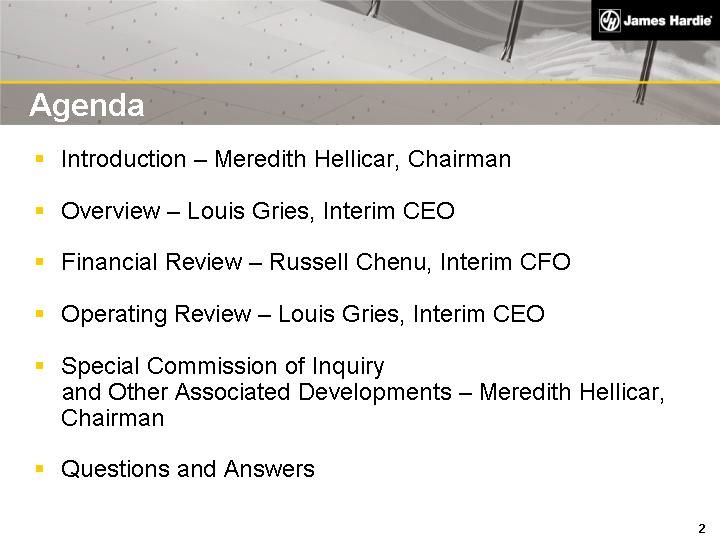
|
Introduction - Meredith Hellicar, Chairman
Overview - Louis Gries, Interim CEO
Financial Review - Russell Chenu, Interim CFO
Operating Review - Louis Gries, Interim CEO
Special Commission of Inquiry
and Other Associated Developments - Meredith Hellicar,
Chairman
Questions and Answers
Agenda
|
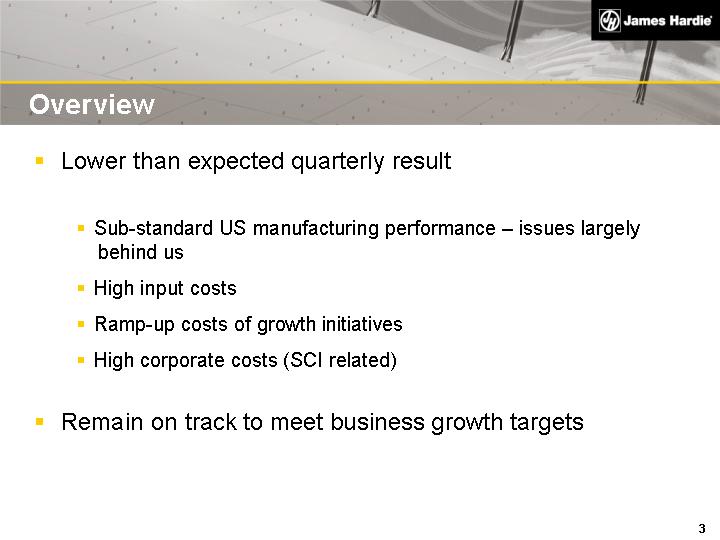
|
Overview
Lower than expected quarterly result
Sub-standard US manufacturing performance - issues largely
behind us
High input costs
Ramp-up costs of growth initiatives
High corporate costs (SCI related)
Remain on track to meet business growth targets
|

|
* Including Discontinued Operations
2nd Quarter and Half Year FY05
Q2'05% HY'05%
Net Sales
up 20 up 23
Gross Profit up 5 up 15
EBIT1 down 16 up 2
Operating Profit1 down 25 down 6
Net Operating Profit1 * down 24 down 9
Overview
|
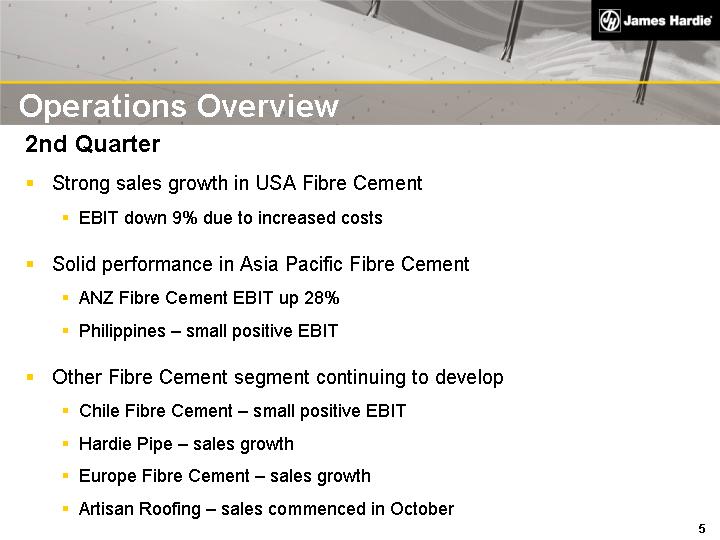
|
Operations Overview
2nd Quarter
Strong sales growth in USA Fibre Cement
EBIT down 9% due to increased costs
Solid performance in Asia Pacific Fibre Cement
ANZ Fibre Cement EBIT up 28%
Philippines - small positive EBIT
Other Fibre Cement segment continuing to develop
Chile Fibre Cement - small positive EBIT
Hardie Pipe - sales growth
Europe Fibre Cement - sales growth
Artisan Roofing - sales commenced in October
|
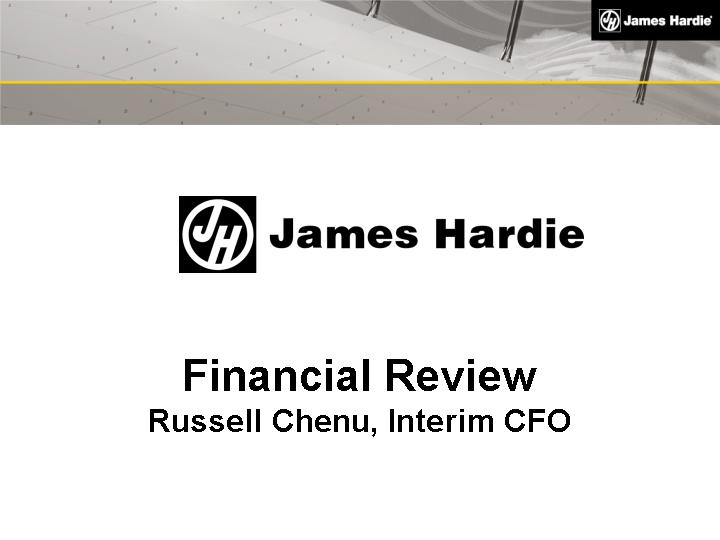
|
Financial Review
Russell Chenu, Interim CFO
|
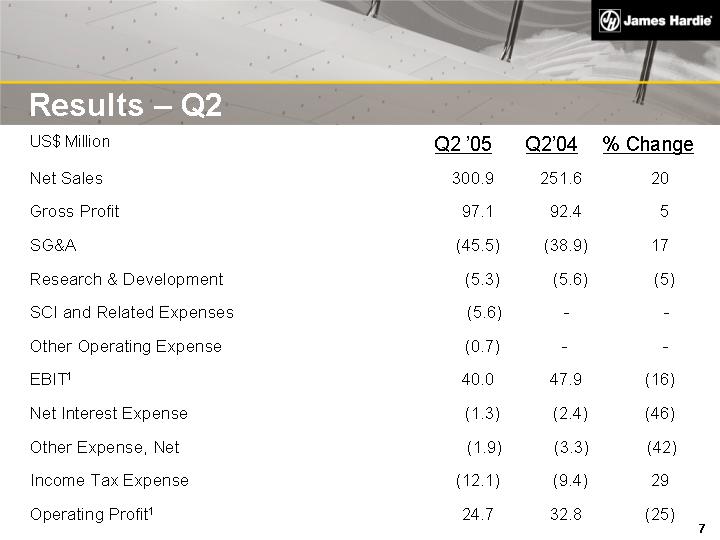
|
US$ Million
Q2 '05
Q2'04
% Change
Net Sales 300.9 251.6 20
Gross Profit 97.1 92.4 5
SG&A (45.5) (38.9) 17
Research & Development (5.3) (5.6) (5)
SCI and Related Expenses (5.6) - -
Other Operating Expense (0.7) - -
EBIT1 40.0 47.9 (16)
Net Interest Expense (1.3) (2.4) (46)
Other Expense, Net (1.9) (3.3) (42)
Income Tax Expense (12.1) (9.4) 29
Operating Profit1 24.7 32.8 (25)
Results - Q2
|
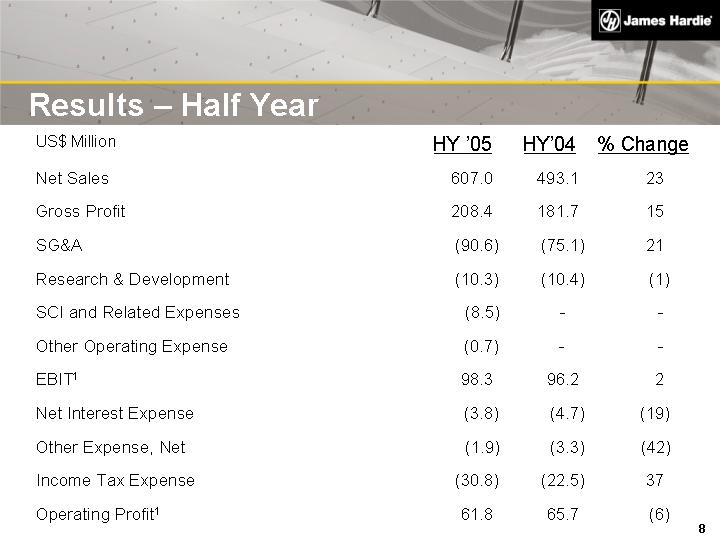
|
Results - Half Year
US$ Million
HY '05
HY'04
% Change
Net Sales 607.0 493.1 23
Gross Profit 208.4 181.7 15
SG&A (90.6) (75.1) 21
Research & Development (10.3) (10.4) (1)
SCI and Related Expenses (8.5) - -
Other Operating Expense (0.7) - -
EBIT1 98.3 96.2 2
Net Interest Expense (3.8) (4.7) (19)
Other Expense, Net (1.9) (3.3) (42)
Income Tax Expense (30.8) (22.5) 37
Operating Profit1 61.8 65.7 (6)
|
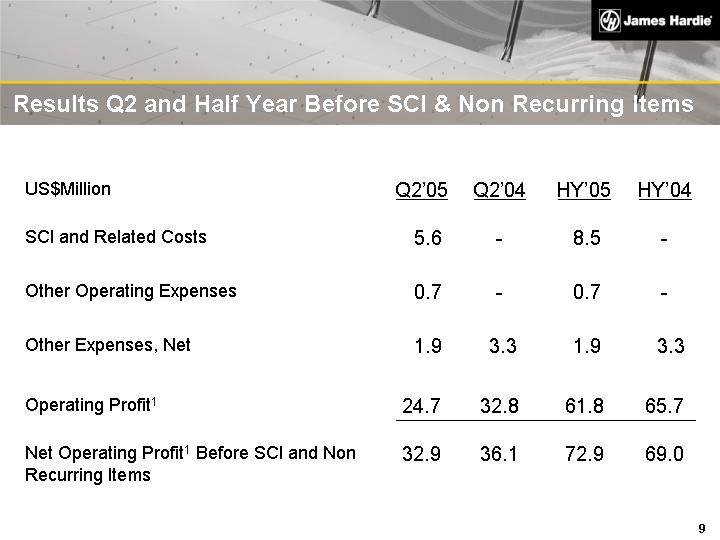
|
Results Q2 and Half Year Before SCI & Non Recurring Items
US$Million Q2'05 Q2'04 HY'05 HY'04
SCI and Related Costs 5.6 - 8.5 -
Other Operating Expenses 0.7 - 0.7 -
Other Expenses, Net 1.9 3.3 1.9 3.3
Operating Profit1 24.7 32.8 61.8 65.7
Net Operating Profit1 Before SCI and Non Recurring Items 32.9 36.1 72.9 69.0
|

|
Segment Net Sales - Q2
US$ Million Q2 '05 Q2 '04 % Change
USA Fibre Cement 231.0 191.4 21
Asia Pacific Fibre Cement 62.5 54.8 14
Other Fibre Cement 7.4 5.4 37
Total 300.9 251.6 20
|

|
Segment Net Sales - Half Year
US$ Million HY '05 HY '04 % Change
USA Fibre Cement 471.7 378.2 25
Asia Pacific Fibre Cement 119.8 104.9 14
Other Fibre Cement 15.5 10.0 55
Total 607.0 493.1 23
|
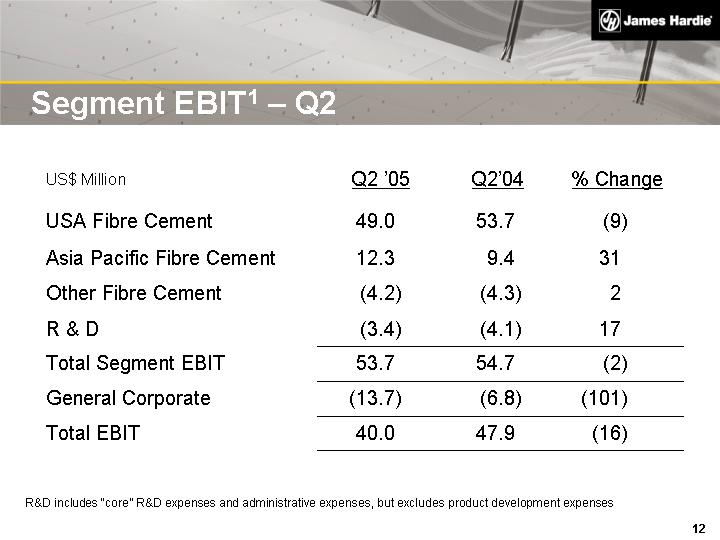
|
Segment EBIT1 - Q2
US$ Million Q2 '05 Q2'04 % Change
USA Fibre Cement 49.0 53.7 (9)
Asia Pacific Fibre Cement 12.3 9.4 31
Other Fibre Cement (4.2) (4.3) 2
R & D (3.4) (4.1) 17
Total Segment EBIT 53.7 54.7 (2)
General Corporate (13.7) (6.8) (101)
Total EBIT 40.0 47.9 (16)
R&D includes "core" R&D expenses and administrative expenses, but excludes product development expenses
|
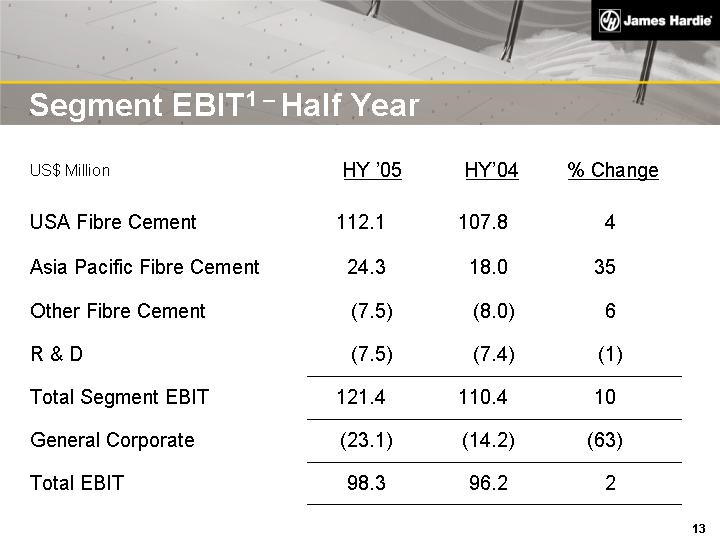
|
Segment EBIT1 - Half Year
US$ Million HY '05 HY'04 % Change
USA Fibre Cement 112.1 107.8 4
Asia Pacific Fibre Cement 24.3 18.0 35
Other Fibre Cement (7.5) (8.0) 6
R & D (7.5) (7.4) (1)
Total Segment EBIT 121.4 110.4 10
General Corporate (23.1) (14.2) (63)
Total EBIT 98.3 96.2 2
|
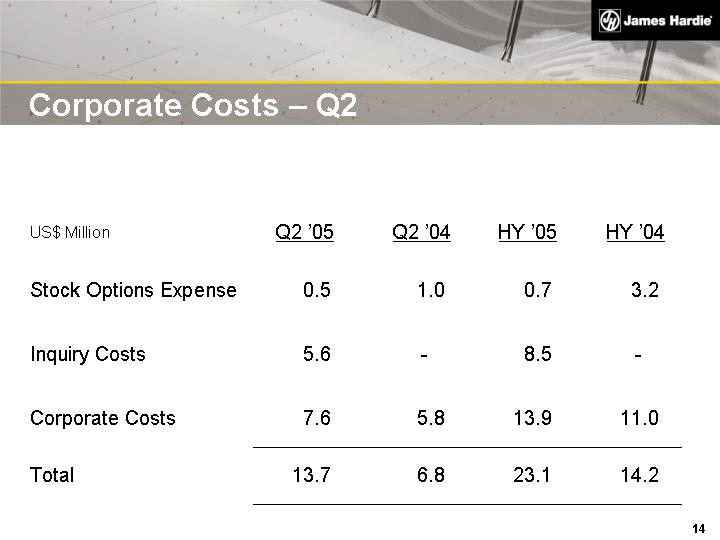
|
Corporate Costs - Q2
US$ Million Q2 '05 Q2 '04 HY '05 HY '04
Stock Options Expense 0.5 1.0 0.7 3.2
Inquiry Costs 5.6 - 8.5 -
Corporate Costs 7.6 5.8 13.9 11.0
Total 13.7 6.8 23.1 14.2
|

|
Net Interest Expense
US$ Million Q2'05 Q2'04 %Change
Net Interest Expense (1.3) (2.4) (46)
HY'05 HY'04 %Change
Net Interest Expense (3.8) (4.7) (19)
|
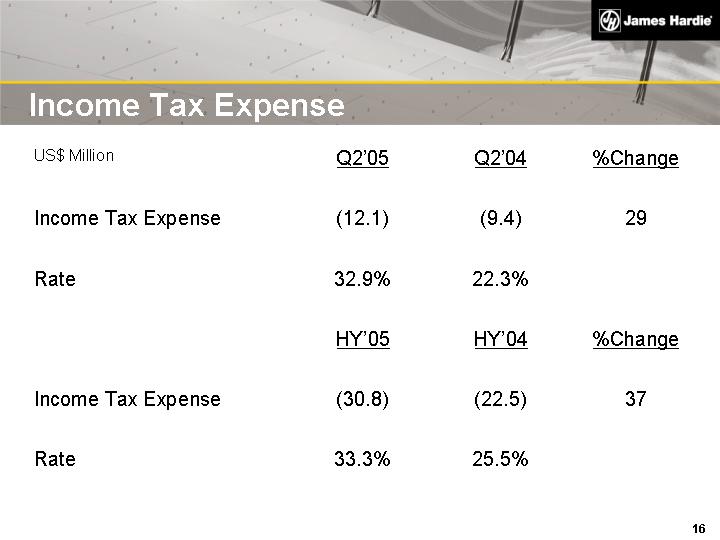
|
Income Tax Expense
US$ Million Q2'05 Q2'04 %Change
Income Tax Expense (12.1) (9.4) 29
Rate 32.9% 22.3%
HY'05 HY'04 %Change
Income Tax Expense (30.8) (22.5) 37
Rate 33.3% 25.5%
|
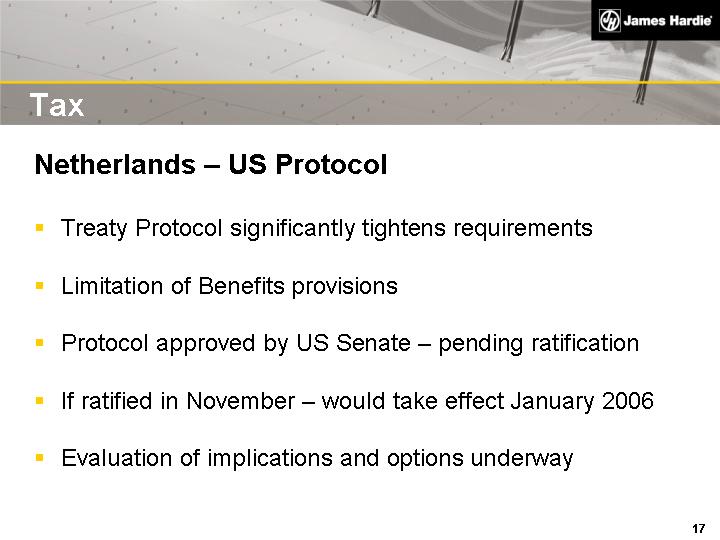
|
Tax
Netherlands - US Protocol
Treaty Protocol significantly tightens requirements
Limitation of Benefits provisions
Protocol approved by US Senate - pending ratification
If ratified in November - would take effect January 2006
Evaluation of implications and options underway
|
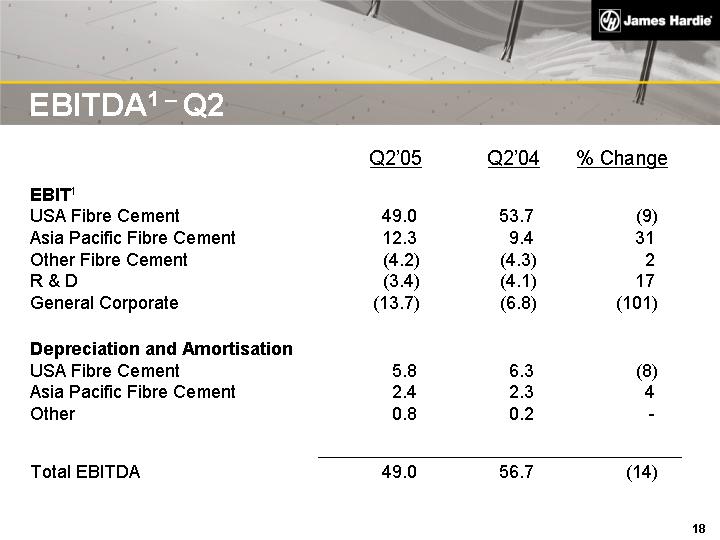
|
EBITDA1 - Q2
Q2'05 Q2'04 % Change
EBIT1
USA Fibre Cement
Asia Pacific Fibre Cement
Other Fibre Cement
R & D
General Corporate
49.0
12.3
(4.2) (3.4)
(13.7)
53.7
9.4
(4.3)
(4.1)
(6.8)
(9)
31
2
17
(101)
Depreciation and Amortisation
USA Fibre Cement
Asia Pacific Fibre Cement
Other
5.8
2.4
0.8
6.3
2.3
0.2
(8)
4
-
Total EBITDA 49.0 56.7 (14)
|

|
EBITDA1 - Half Year
HY'05 HY'04 % Change
EBIT1
USA Fibre Cement
Asia Pacific Fibre Cement
Other Fibre Cement
R & D
General Corporate
112.1
24.3
(7.5) (7.5)
(23.1)
107.8
18.0
(8.0)
(7.4)
(14.2)
4
35
6
(1)
(63)
Depreciation and Amortisation
USA Fibre Cement
Asia Pacific Fibre Cement
Other
11.6
4.7
1.6
11.2
4.6
0.4
4
2
-
Total EBITDA 116.2 112.4 3
R&D includes "core" R&D expenses and administrative expenses, but excludes product development expenses
|
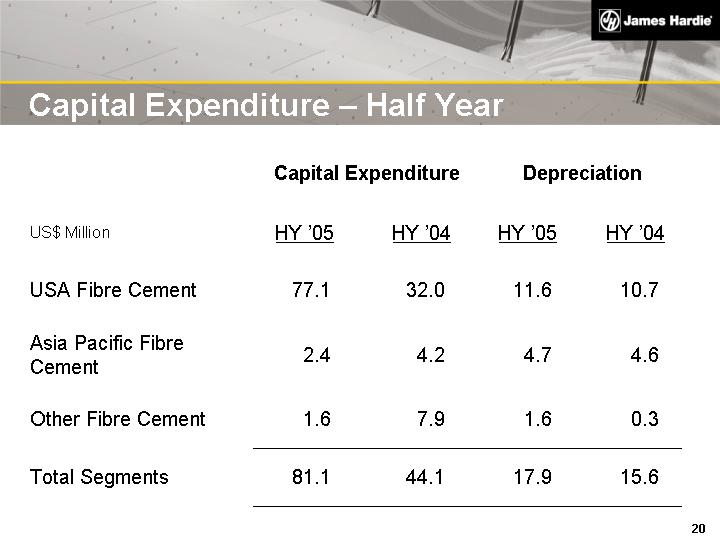
|
Capital Expenditure - Half Year
Capital Expenditure Capital Expenditure Depreciation Depreciation
US$ Million HY '05 HY '04 HY '05 HY '04
USA Fibre Cement 77.1 32.0 11.6 10.7
Asia Pacific Fibre Cement 2.4 4.2 4.7 4.6
Other Fibre Cement 1.6 7.9 1.6 0.3
Total Segments 81.1 44.1 17.9 15.6
|
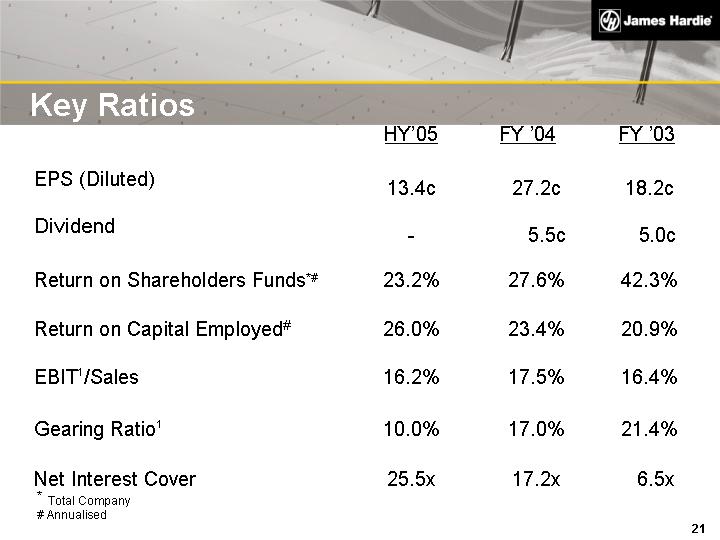
|
Key Ratios
HY'05 FY '04 FY '03
EPS (Diluted)
13.4c 27.2c 18.2c
Dividend - 5.5c 5.0c
Return on Shareholders Funds*# 23.2% 27.6% 42.3%
Return on Capital Employed# 26.0% 23.4% 20.9%
EBIT1/Sales 16.2% 17.5% 16.4%
Gearing Ratio1 10.0% 17.0% 21.4%
Net Interest Cover 25.5x 17.2x 6.5x
* Total Company
# Annualised
|
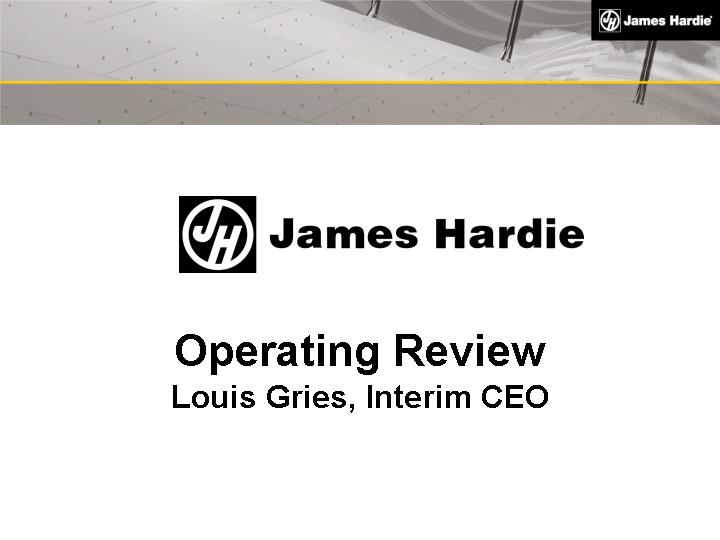
|
Operating Review
Louis Gries, Interim CEO
|
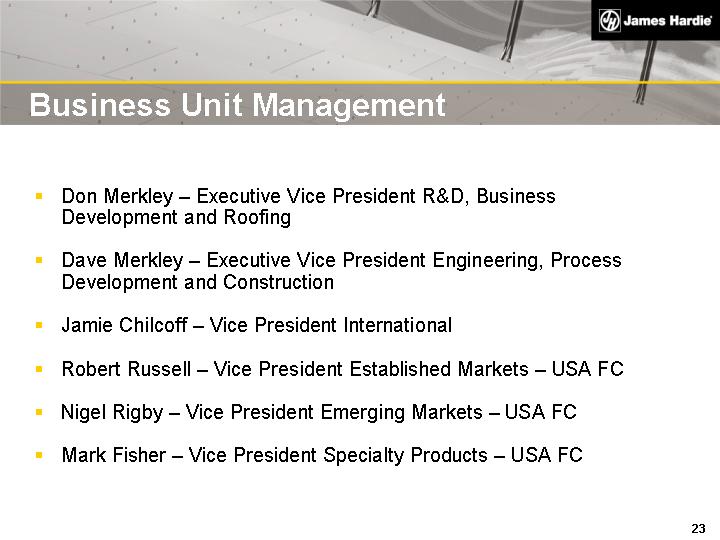
|
Business Unit Management
Don Merkley - Executive Vice President R&D, Business
Development and Roofing
Dave Merkley - Executive Vice President Engineering, Process
Development and Construction
Jamie Chilcoff - Vice President International
Robert Russell - Vice President Established Markets - USA FC
Nigel Rigby - Vice President Emerging Markets - USA FC
Mark Fisher - Vice President Specialty Products - USA FC
|
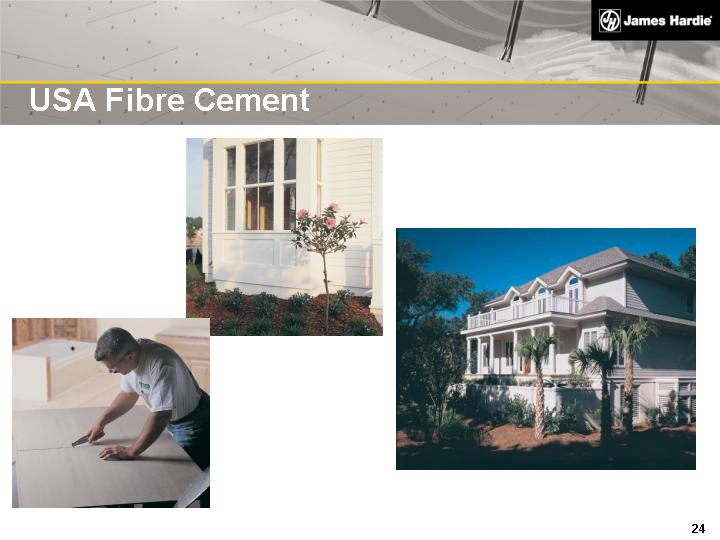
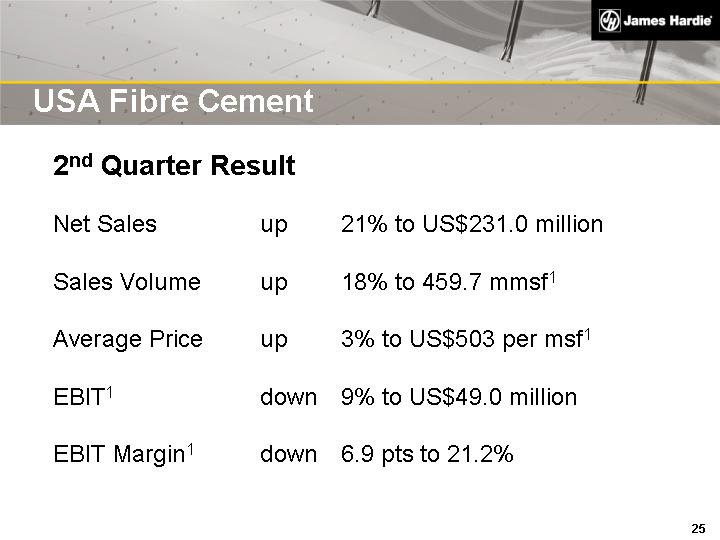
|
2nd Quarter Result
Net Sales up 21% to US$231.0 million
Sales Volume up 18% to 459.7 mmsf1
Average Price up 3% to US$503 per msf1
EBIT1 down 9% to US$49.0 million
EBIT Margin1 down 6.9 pts to 21.2%
USA Fibre Cement
|

|
USA Fibre Cement
2nd Quarter Trading Conditions
Continued strength in housing construction
Strong consumer demand
Low interest rates
Strong house prices
Low housing inventory levels
|
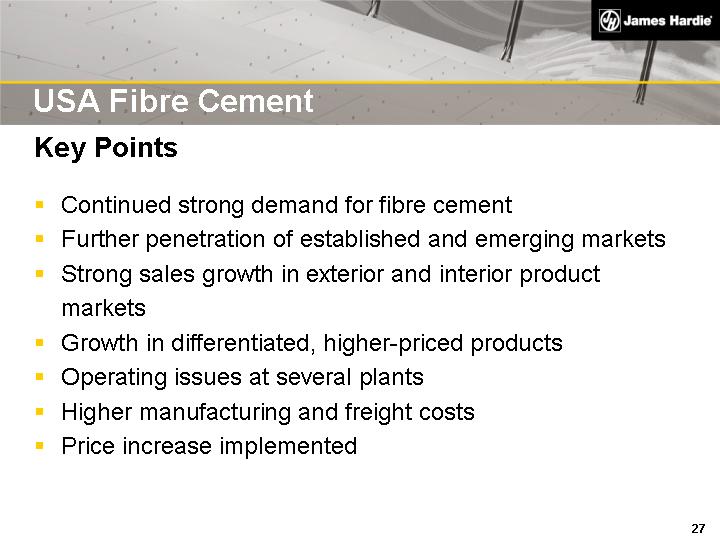
|
USA Fibre Cement
Key Points
Continued strong demand for fibre cement
Further penetration of established and emerging markets
Strong sales growth in exterior and interior product
markets
Growth in differentiated, higher-priced products
Operating issues at several plants
Higher manufacturing and freight costs
Price increase implemented
|

|
USA Fibre Cement
Plant Performance Issues
Ramp up and management issues at Blandon,
Pennsylvania; Summerville, South Carolina and
Waxahachie, Texas
Capacity constrained
Increased operating costs - US$8M impact:
Freight
Labour
Maintenance
Issues addressed and largely behind us
|

|
USA Fibre Cement
Q2'05
US$m HY'05
US$m
4.7 8.2
6.2 11.3
4.6 11.6
EBIT/Sales Margin
Higher costs
Higher raw material prices
Freight (capacity constraint
related and higher fuel cost impact)
SG&A (growth initiatives)
Long term band 20-25%
|
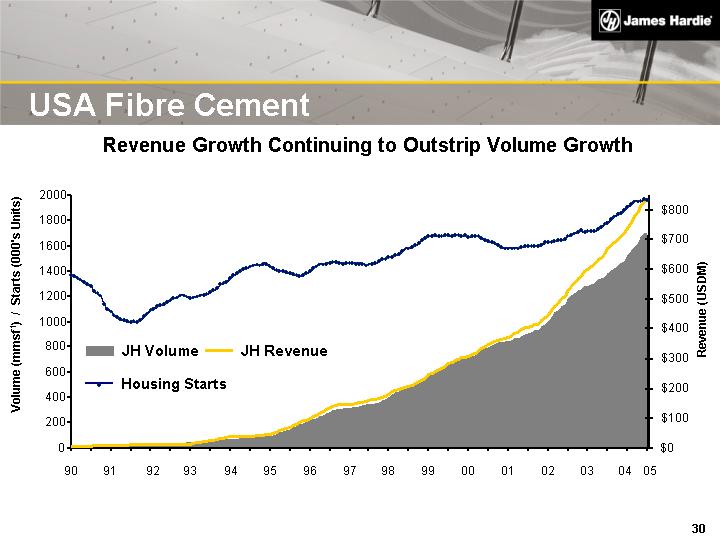
|
USA Fibre Cement
Revenue Growth Continuing to Outstrip Volume Growth
0
200
400
600
800
1000
1200
1400
1600
1800
2000
90
91
92
93
94
95
96
97
98
99
00
01
02
03
04
Volume (mmsf1) / Starts (000's Units)
$0
$100
$200
$300
$400
$500
$600
$700
$800
Revenue (USDM)
JH Volume
JH Revenue
Housing Starts
05
|
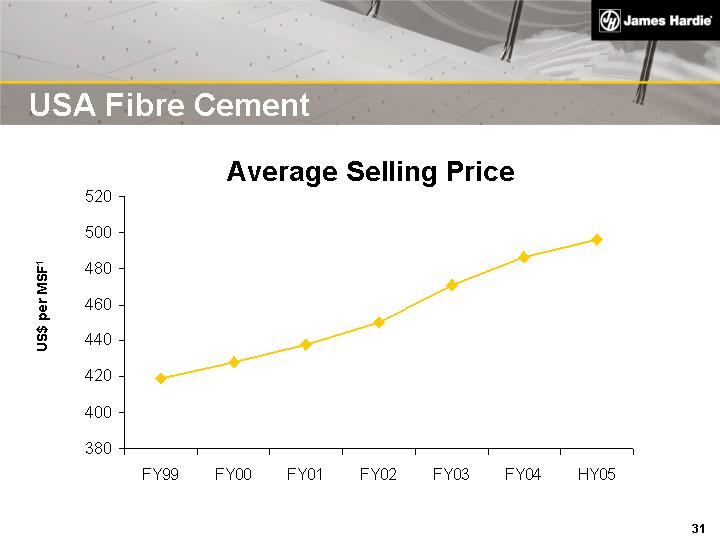
|
USA Fibre Cement
Average Selling Price
US$ per MSF1
|
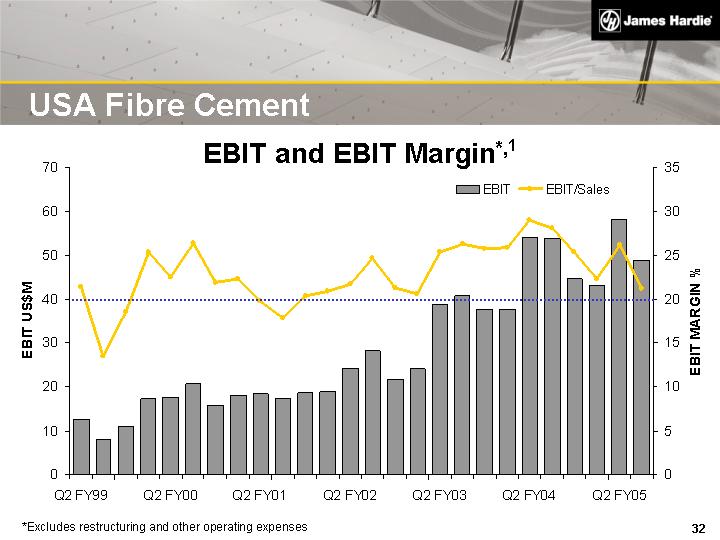
|
USA Fibre Cement
*Excludes restructuring and other operating expenses
EBIT and EBIT Margin*,1
|
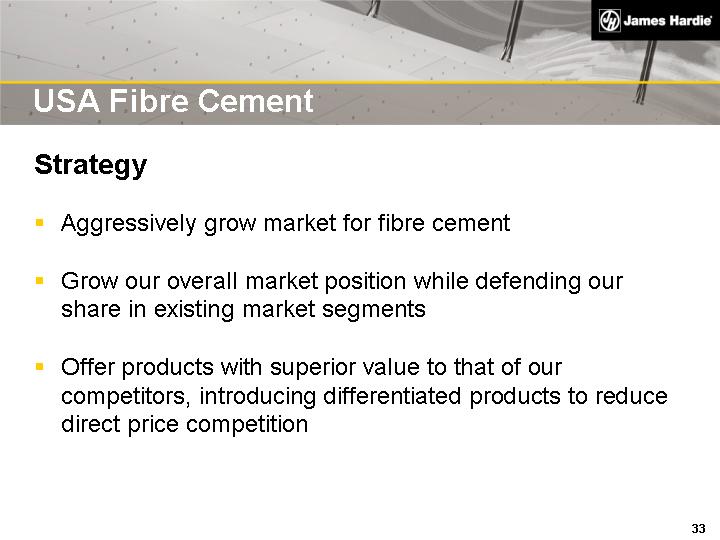
|
USA Fibre Cement
Strategy
Aggressively grow market for fibre cement
Grow our overall market position while defending our
share in existing market segments
Offer products with superior value to that of our
competitors, introducing differentiated products to reduce
direct price competition
|
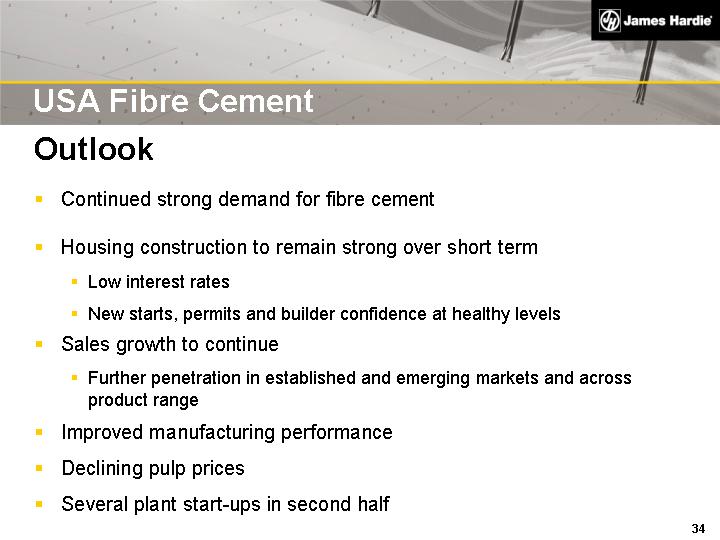
|
USA Fibre Cement
Outlook
Continued strong demand for fibre cement
Housing construction to remain strong over short term
Low interest rates
New starts, permits and builder confidence at healthy levels
Sales growth to continue
Further penetration in established and emerging markets and across
product range
Improved manufacturing performance
Declining pulp prices
Several plant start-ups in second half
|
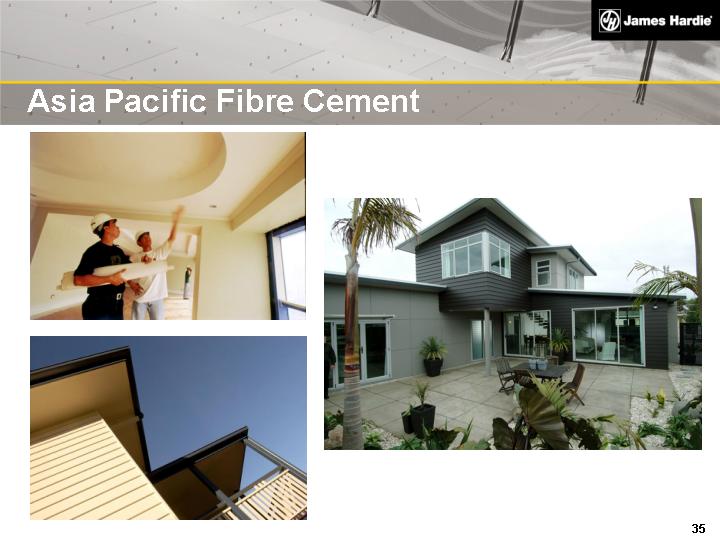
|
Asia Pacific Fibre Cement
|

|
Asia Pacific Fibre Cement
2nd Quarter Result
Net Sales up 14% to US$62.5 million
Sales Volume up 9% to 102.6 mmsf1
EBIT1 up 31% to US$12.3 million
EBIT Margin1 up 2.5 pts to 19.7%
|
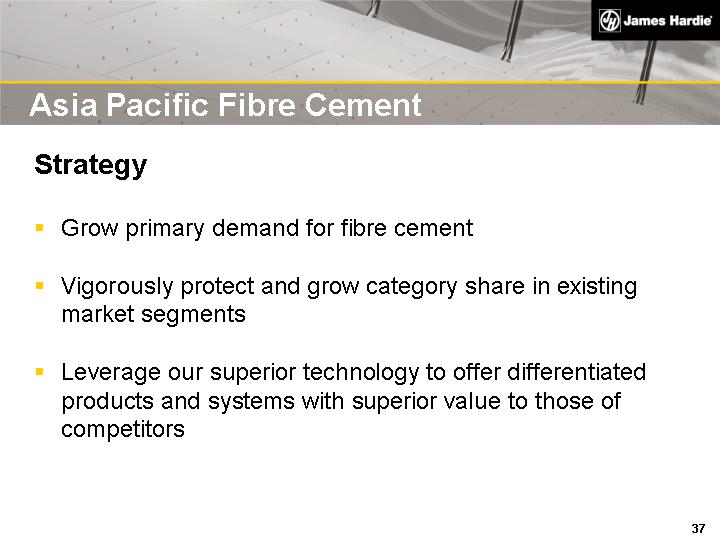
|
Strategy
Grow primary demand for fibre cement
Vigorously protect and grow category share in existing
market segments
Leverage our superior technology to offer differentiated
products and systems with superior value to those of
competitors
Asia Pacific Fibre Cement
|
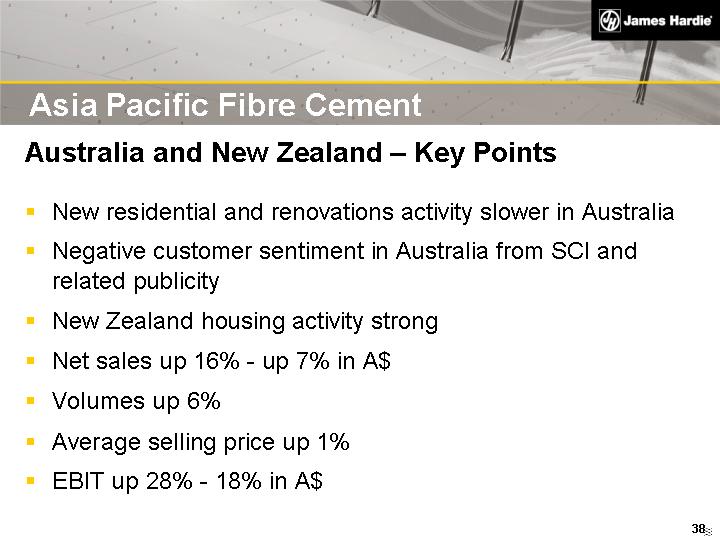
|
Australia and New Zealand - Key Points
New residential and renovations activity slower in Australia
Negative customer sentiment in Australia from SCI and
related publicity
New Zealand housing activity strong
Net sales up 16% - up 7% in A$
Volumes up 6%
Average selling price up 1%
EBIT up 28% - 18% in A$
Asia Pacific Fibre Cement
|
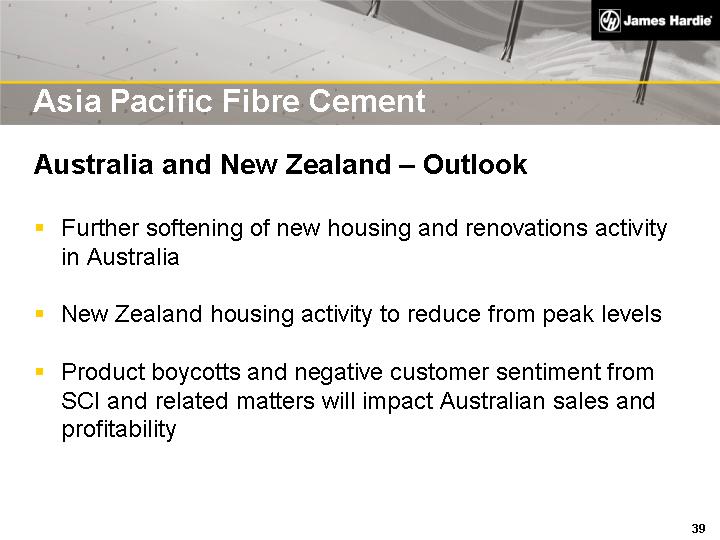
|
Asia Pacific Fibre Cement
Australia and New Zealand - Outlook
Further softening of new housing and renovations activity
in Australia
New Zealand housing activity to reduce from peak levels
Product boycotts and negative customer sentiment from
SCI and related matters will impact Australian sales and
profitability
|

|
Asia Pacific Fibre Cement
Philippines
Key Points
Increased building and construction activity
Net sales up 19% - up 22% in local currency
Positive EBIT
Outlook
Stronger building and construction activity
Continued improvement in business results
|

|
Other Fibre Cement
Chile Fibre Cement
Key Points
Improved domestic and regional construction activity
Strong sales growth
Higher domestic pricing
Outlook
Further improvement in domestic and regional
construction activity
Continued improvement in business results
|

|
Other Fibre Cement
USA Hardie(r) Pipe
Key Points
Higher prices and volumes
Improved manufacturing performance
EBIT losses reduced
Outlook
Further market penetration and sales growth
Continued improvements to plant operating efficiency
Further EBIT improvement
|
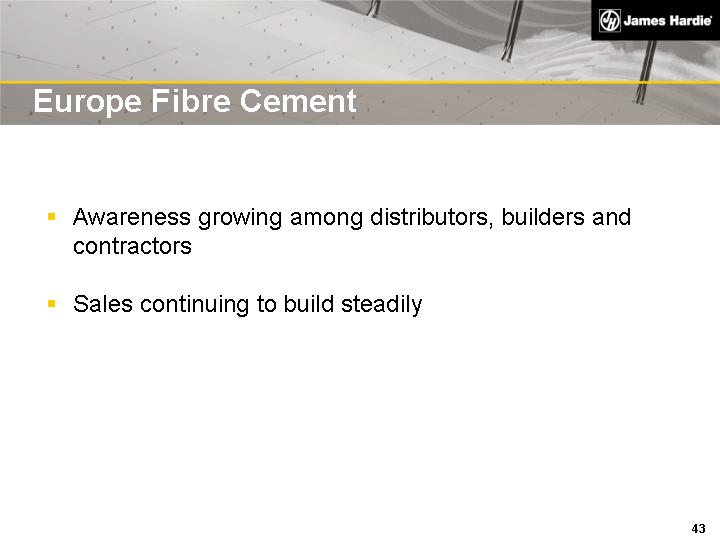
|
Europe Fibre Cement
Awareness growing among distributors, builders and
contractors
Sales continuing to build steadily
|

|
Artisan Roofing
Sales commenced in October
Customer interest remains strong
Manufacturing ramp up in early stages
|
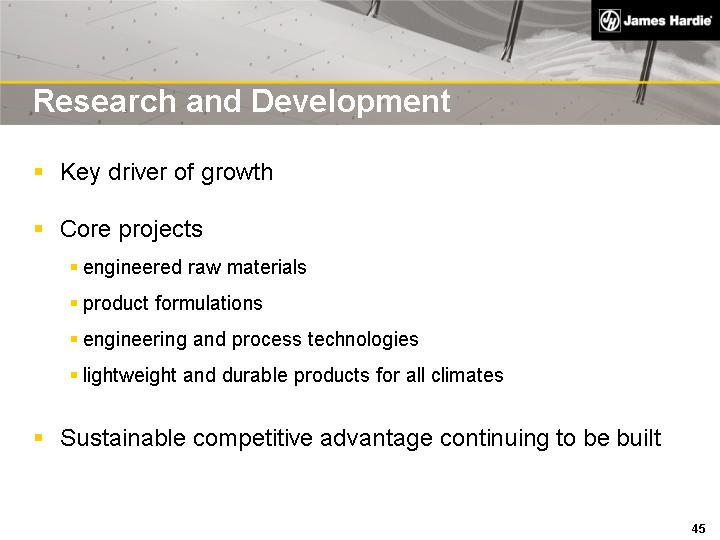
|
Research and Development
Key driver of growth
Core projects
engineered raw materials
product formulations
engineering and process technologies
lightweight and durable products for all climates
Sustainable competitive advantage continuing to be built
|
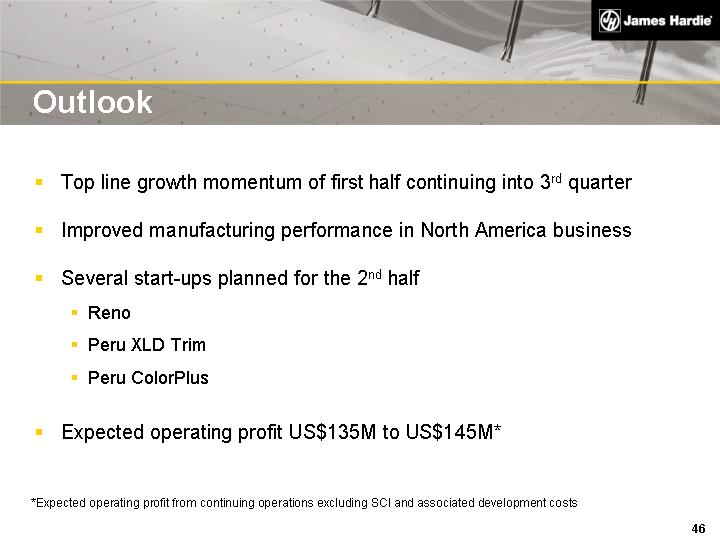
|
Outlook
Top line growth momentum of first half continuing into 3rd quarter
Improved manufacturing performance in North America business
Several start-ups planned for the 2nd half
Reno
Peru XLD Trim
Peru ColorPlus
Expected operating profit US$135M to US$145M*
*Expected operating profit from continuing operations excluding SCI and associated development costs
|
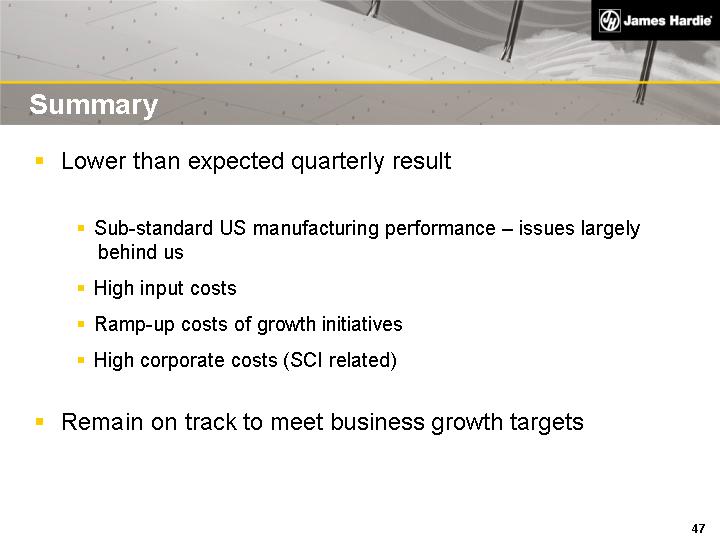
|
Summary
Lower than expected quarterly result
Sub-standard US manufacturing performance - issues largely
behind us
High input costs
Ramp-up costs of growth initiatives
High corporate costs (SCI related)
Remain on track to meet business growth targets
|
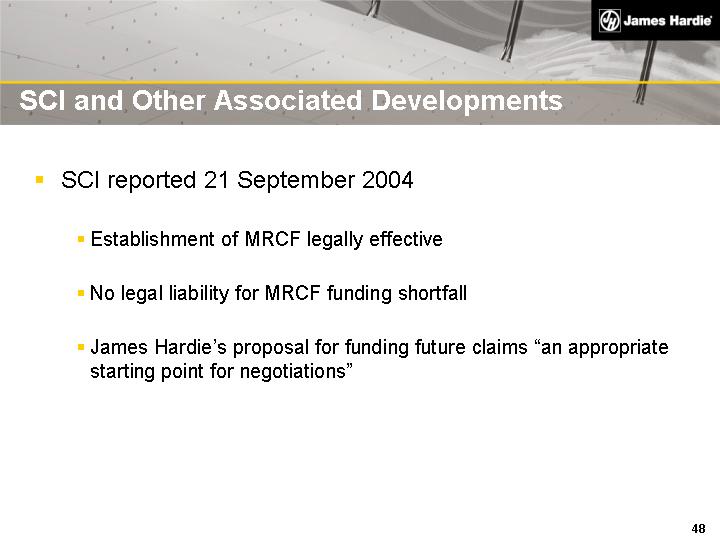
|
SCI and Other Associated Developments
SCI reported 21 September 2004
Establishment of MRCF legally effective
No legal liability for MRCF funding shortfall
James Hardie's proposal for funding future claims "an appropriate
starting point for negotiations"
|

|
Currently in discussions with various stakeholders - progress being made
NSW Government to review ways to cut unnecessary legal and
administrative costs in current compensation system
22 September 2004, ASIC announced investigation into creation of
MRCF - James Hardie co-operating with ASIC
Substantial costs incurred on SCI and other developments - further costs will
be incurred
Offer of indemnity to ABN 60 and interim funding to MRCF
10 September 2004, internal investigation announced consistent with SEC
regulations. Investigation now concluded - no impact on financial statements
Form 20-F (annual report) lodged with SEC, 22 November 2004
SCI and Other Associated Developments
|

|
Updated Actuarial Estimate - MRCF Liabilities
KPMG estimate updated to 30 June 04
Central Estimate of MRCF liabilities A$1.536 billion at 30
June 2004
Underlying increase in liabilities 5%
Sustained trend or aberration not clear - but factored in
SCI and Other Associated Developments
|
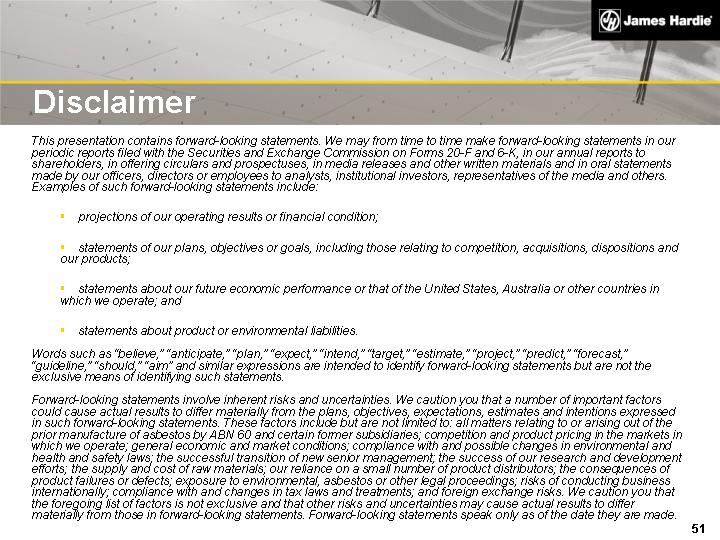
|
Disclaimer
This presentation contains forward-looking statements. We may from time to time make forward-looking statements in our
periodic reports filed with the Securities and Exchange Commission on Forms 20-F and 6-K, in our annual reports to
shareholders, in offering circulars and prospectuses, in media releases and other written materials and in oral statements
made by our officers, directors or employees to analysts, institutional investors, representatives of the media and others.
Examples of such forward-looking statements include:
projections of our operating results or financial condition;
statements of our plans, objectives or goals, including those relating to competition, acquisitions, dispositions and
our products;
statements about our future economic performance or that of the United States, Australia or other countries in
which we operate; and
statements about product or environmental liabilities.
Words such as "believe," "anticipate," "plan," "expect," "intend," "target," "estimate," "project," "predict," "forecast,"
"guideline," "should," "aim" and similar expressions are intended to identify forward-looking statements but are not the
exclusive means of identifying such statements.
Forward-looking statements involve inherent risks and uncertainties. We caution you that a number of important factors
could cause actual results to differ materially from the plans, objectives, expectations, estimates and intentions expressed
in such forward-looking statements. These factors include but are not limited to: all matters relating to or arising out of the
prior manufacture of asbestos by ABN 60 and certain former subsidiaries; competition and product pricing in the markets in
which we operate; general economic and market conditions; compliance with and possible changes in environmental and
health and safety laws; the successful transition of new senior management; the success of our research and development
efforts; the supply and cost of raw materials; our reliance on a small number of product distributors; the consequences of
product failures or defects; exposure to environmental, asbestos or other legal proceedings; risks of conducting business
internationally; compliance with and changes in tax laws and treatments; and foreign exchange risks. We caution you that
the foregoing list of factors is not exclusive and that other risks and uncertainties may cause actual results to differ
materially from those in forward-looking statements. Forward-looking statements speak only as of the date they are made.
|
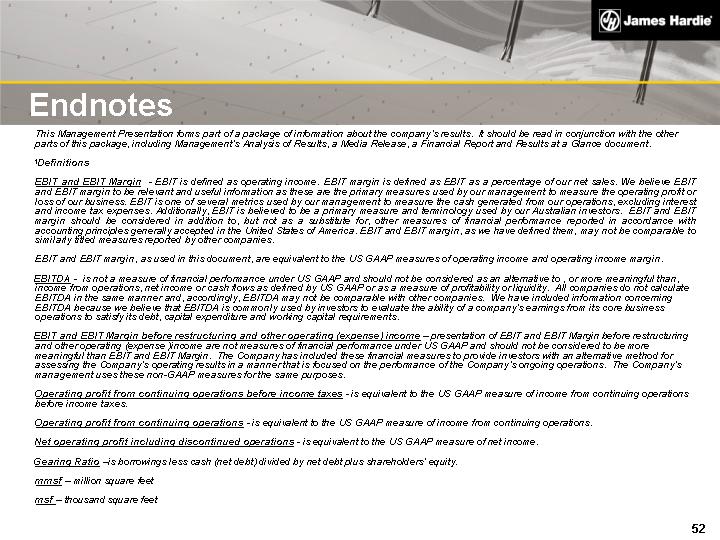
|
Endnotes
This Management Presentation forms part of a package of information about the company's results. It should be read in conjunction with the other
parts of this package, including Management's Analysis of Results, a Media Release, a Financial Report and Results at a Glance document.
1Definitions
EBIT and EBIT Margin - EBIT is defined as operating income. EBIT margin is defined as EBIT as a percentage of our net sales. We believe EBIT
and EBIT margin to be relevant and useful information as these are the primary measures used by our management to measure the operating profit or
loss of our business. EBIT is one of several metrics used by our management to measure the cash generated from our operations, excluding interest
and income tax expenses. Additionally, EBIT is believed to be a primary measure and terminology used by our Australian investors. EBIT and EBIT
margin should be considered in addition to, but not as a substitute for, other measures of financial performance reported in accordance with
accounting principles generally accepted in the United States of America. EBIT and EBIT margin, as we have defined them, may not be comparable to
similarly titled measures reported by other companies.
EBIT and EBIT margin, as used in this document, are equivalent to the US GAAP measures of operating income and operating income margin.
EBITDA - is not a measure of financial performance under US GAAP and should not be considered as an alternative to , or more meaningful than,
income from operations, net income or cash flows as defined by US GAAP or as a measure of profitability or liquidity. All companies do not calculate
EBITDA in the same manner and, accordingly, EBITDA may not be comparable with other companies. We have included information concerning
EBITDA because we believe that EBITDA is commonly used by investors to evaluate the ability of a company's earnings from its core business
operations to satisfy its debt, capital expenditure and working capital requirements.
EBIT and EBIT Margin before restructuring and other operating (expense) income - presentation of EBIT and EBIT Margin before restructuring
and other operating (expense )income are not measures of financial performance under US GAAP and should not be considered to be more
meaningful than EBIT and EBIT Margin. The Company has included these financial measures to provide investors with an alternative method for
assessing the Company's operating results in a manner that is focused on the performance of the Company's ongoing operations. The Company's
management uses these non-GAAP measures for the same purposes.
Operating profit from continuing operations before income taxes - is equivalent to the US GAAP measure of income from continuing operations
before income taxes.
Operating profit from continuing operations - is equivalent to the US GAAP measure of income from continuing operations.
Net operating profit including discontinued operations - is equivalent to the US GAAP measure of net income.
Gearing Ratio -is borrowings less cash (net debt) divided by net debt plus shareholders' equity.
mmsf - million square feet
msf - thousand square feet
|
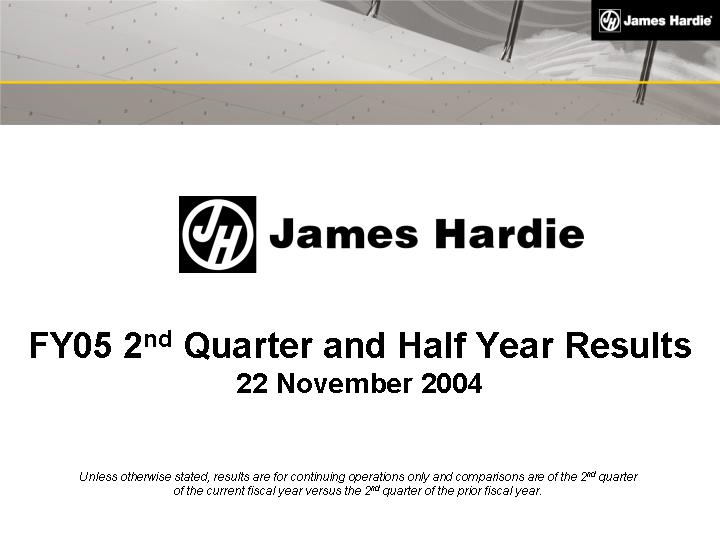
|
FY05 2nd Quarter and Half Year Results
22 November 2004
Unless otherwise stated, results are for continuing operations only and comparisons are of the 2nd quarter
of the current fiscal year versus the 2nd quarter of the prior fiscal year.
|























































